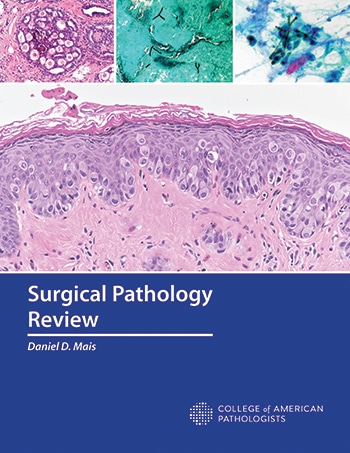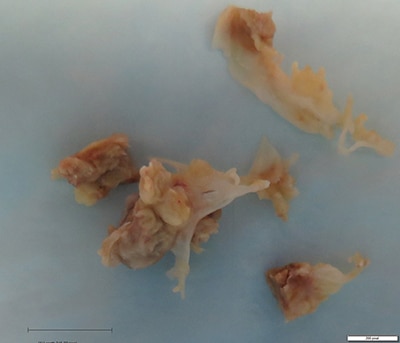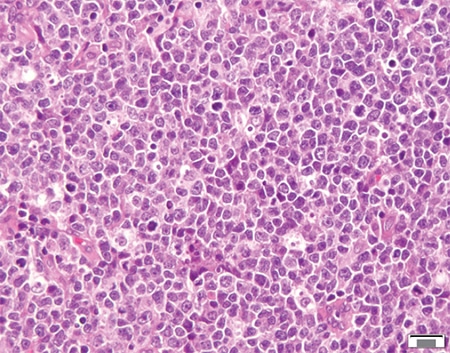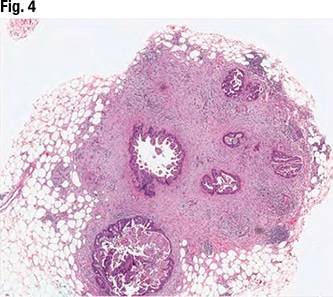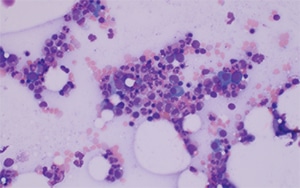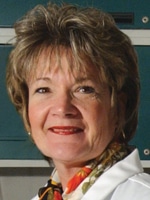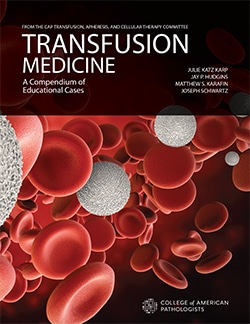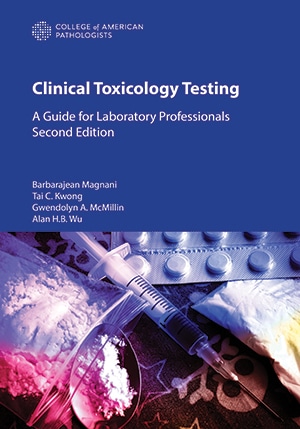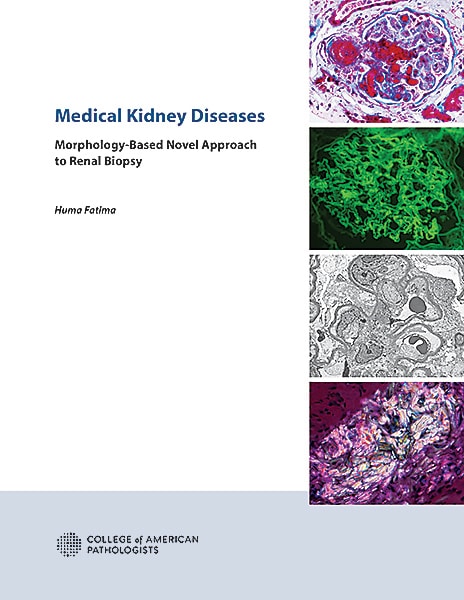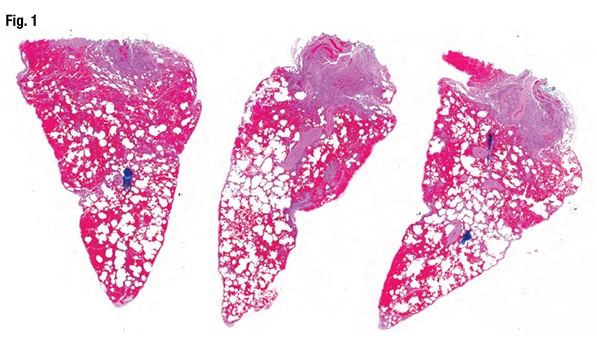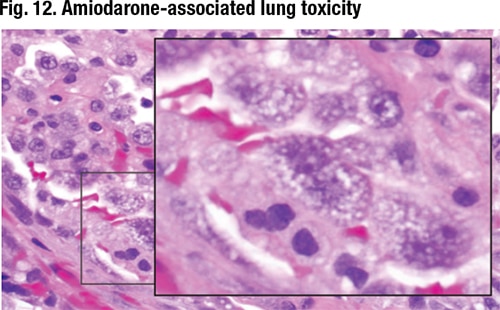September 2021—Beginning next year, CAP-accredited laboratories that perform HER2 immunohistochemistry in gastroesophageal adenocarcinoma or highly sensitive (hs) ALK in non-small cell lung cancer will be required to enroll in proficiency testing for those analytes.
Read More »ALL ISSUES
Metagenomic NGS: More pros than cons?
September 2021—A stem cell transplant patient at Lurie Children’s Hospital in Chicago had a disseminated fungal infection by every clinical criterion, but no conventional method had detected it.
Read More »How to prevail over a crisis using data analytics
September 2021—The pandemic has pelted hospitals and laboratories with wild cards and sometimes thrown wrenches into the works. But the jolts it has delivered to normal institutional operations, forcing new solutions to business and clinical care dilemmas, have also positioned laboratories to help produce stunning new capabilities.
Read More »A preanalytics push in accreditation checklists
September 2021—Taking steps to protect the integrity of specimens is at the heart of new and revised requirements in this year’s edition of the accreditation program checklists, set for release Sept. 22. A CAP team made up of members of the Checklists, Personalized Health Care, and Cytopathology committees collaborated to incorporate into the checklists the evidence-based recommendations set forth in a 2019 article on preanalytics and precision pathology. Many of the new and revised requirements, which are in seven checklists, are aimed at improving the quality of tissue and blood specimens that may undergo molecular testing for patients with cancer. The aim of others is to improve the preanalytic quality of specimens used for all types of testing.
Read More »Salaries, schools, students—all eyes on workforce
September 2021—SARS-CoV-2 spread and the staffing shortage drove the conversation when Compass Group members met Aug. 3 for their monthly call led by CAP TODAY publisher Bob McGonnagle. “Like others, we were seeing problems before COVID, but COVID seems to have kicked it into overdrive,” Steven Carroll, MD, PhD, of the Medical University of South Carolina, said of the shortage. And more long term, it’s time to jump-start training programs, he and others say. The Compass Group is an organization of not-for-profit IDN system laboratory leaders who collaborate to identify and share best practices and strategies. Here is what they shared last month.
Read More »For MammaPrint and BluePrint, the long-term view
September 2021—The latest data on the use of two genomic assays in early-stage breast cancer and at the University of Rochester Medical Center as the pandemic set in were reported in a CAP TODAY webinar presented by William Audeh, MD, and David G. Hicks, MD. Dr. Audeh, medical oncologist and chief medical officer of Agendia, developer of MammaPrint and BluePrint, presented the long-term follow-up results of the MINDACT trial and an age-related analysis, as well as new data on MammaPrint’s use in endocrine therapy decisions.
Read More »From the President’s Desk: Looking back, looking ahead
September 2021—As my term as president of the College of American Pathologists comes to a close, I am both honored and humbled to have been selected by my peers for this position. Over the past two years our organization was presented with the greatest challenge we have ever faced. Because of our phenomenal members and staff, we have accomplished great things even though we worked under the most adverse conditions. We, yet again, backed a horse named CAP. It broke out of the gate well and had to weave through traffic on a bad track, but we are ahead. We made the right bet and I am so, so lucky to have been chosen to be the jockey for this race. Looking back, the COVID-19 pandemic presented our community with relatively sudden and profound changes resulting in a tremendous number of challenges. It has dominated our lives. We should be proud of our accomplishments. We have not only put out many fires and sewn up deep wounds, but we have also set up the College and our fellows for continued success so that we will be able to keep serving our patients well.
Read More »Clinical pathology selected abstracts
September 2021—Colorectal cancer is the third leading cause of cancer death for men and women, with approximately 52,980 deaths projected this year. Although colorectal cancer is most frequently diagnosed in adults between the ages of 65 and 74 years, about 10.5 percent of new colorectal cancer cases will occur in those younger than 50 years of age.
Read More »Anatomic pathology selected abstracts
September 2021—Nivolumab is an immune checkpoint inhibitor approved for treating many types of cancer, including hepatocellular carcinoma (HCC). Liver injury is a known complication in patients treated with nivolumab for nonliver tumors. The morphologic changes to tumor and nontumor liver have not been well-characterized in HCC patients.
Read More »Pathology informatics selected abstracts
September 2021—Chronic myelogenous leukemia is a clonal stem cell disorder driven by the BCR-ABL1 fusion oncogene and accounts for 15 percent of adult leukemias. Patients typically present with abnormalities in their complete blood cell counts with differential classification.
Read More »Molecular pathology selected abstracts
September 2021—More than a year into the COVID-19 pandemic, an essential question remains unanswered: Why do some people infected with SARS-CoV-2 develop severe life-threatening disease or die while others are asymptomatic or have only mild disease symptoms?
Read More »Q&A column
September 2021 Q. What is the ideal collection tube for measuring the level of ammonia in blood? Is a tube containing EDTA suitable?Read answer. Q. Is there a requirement to notify nursing personnel or doctors about each critical value obtained for a patient after the initial occurrence of the critical result?Read answer.
Read More »Newsbytes
September 2021—When Stephen Hewitt, MD, PhD, went down the COVID-19 rabbit hole in early 2020, little did he know about the long-term value of a comprehensive COVID-19 digital pathology repository—and how such a project would come to fill his days and, occasionally, nights.
Read More »Put It on the Board
September 2021—Testing for chronic kidney disease in adults with hypertension and/or diabetes is low in routine clinical care, despite guideline recommendations, write the authors of a study published in Diabetes Care (Alfego D, et al. 2021;44[9]:2025–2032).
Read More »AP lab maps its cyberattack recovery
August 2021—The downtime manual that the anatomic pathology laboratory at the University of Vermont Medical Center maintained in 2020 was never intended to be used for dealing with a cyberattack. In fact, it wasn’t actually a manual. It was a laboratory-wide policy essentially consisting of one instruction to be used in the event of a power failure or short-term IT disruption or other emergency: “Bring everything to a halt.” In anatomic pathology, “Our downtime protocol was: You stop in your tracks,” says dermatopathologist Anne M. Stowman, MD. “For the urgent/emergent specimens, you get out your paper logs, you do paper recording of the cases coming in, and you handwrite your cassettes, your descriptions, your slides.” That would be a bit slower and less efficient, but it would work for brief, temporary outages and disruptions. But the cyberattack that UVMMC experienced in October 2020, cutting off the labs’ access to the medical center’s information technology systems and disabling operations for more than three weeks, was an abrupt wake-up call.
Read More »CSF biomarkers in ‘a new era’ for Alzheimer’s
August 2021—The FDA’s approval in June of a new drug to treat Alzheimer’s disease has incited motley responses, a sort of Grand Tour of emotions and reactions. As with any stormy action, the aftermath becomes clear only over time, during the hard work of cleaning up. What comes next?
Read More »Lab staff shortage calls for speed, money, and more
August 2021—From critical to worse is how two Compass Group members described the lab labor shortage on July 6 when the group spoke with CAP TODAY publisher Bob McGonnagle in another of their monthly virtual meetings. “Things imploded. We’re struggling in every area,” said one.
Read More »Testing for platelet function using whole blood
August 2021—Platelet function testing using platelet-rich plasma is the gold standard, but whole blood platelet aggregation has its advantages, with less risk for preanalytic error among them.
Read More »National patient identifier advocates state their case
August 2021—The iconic Timex slogan “It takes a licking and keeps on ticking” was designed to sell watches in the 1950s and ’60s, but it could just as easily be applied to efforts to repeal the decades-long appropriations ban on a unique national patient identifier—year, after year, after year.
Read More »PGx in transplant medicine: tacrolimus as foundation
August 2021—Pharmacogenetic testing is not standard of care at most transplant centers, nor do the FDA or others mandate it. But “transplant medicine is ripe for observing the benefits of pharmacogenetics,” said Gwendolyn A. McMillin, PhD, D(ABCC), in an AACC virtual session last year.
Read More »AMP case report: Celiac genetic health risk screening by NGS in the family of a child with clinical findings of dermatitis herpetiformis and gluten sensitivity
August 2021—Dermatitis herpetiformis (DH) is an autoimmune skin disorder associated with celiac disease and characterized by pruritic, blistering lesions mainly on the elbows, knees, buttocks, lower back, and scalp. Immunopathogenesis is attributed to IgA TG3 antibody immune complexes in the papillary dermis originating from subclinical celiac disease in the gut. Onset occurs at any age, but DH is diagnosed most often in young adults and rarely in children. Individuals of northern European heritage represent the most frequently affected population for DH, with an estimated incidence reported by the National Organization for Rare Disorders of 75.3 per 100,000 people. First-degree family members of patients with DH are at increased risk for both DH and celiac disease.
Read More »Cytopathology in focus: Reflections on use of Milan System, edition 1: Areas to be explored for edition 2
August 2021—Salivary gland neoplasms (SGN) are a special group of tumors due to the high variation in histologic subtypes that are further complicated by frequent overlapping morphological features. Fine-needle aspiration is a safe, cost-effective, first-line modality for diagnosing SGNs, an integral part of SGN preoperational workup. In 2018, Faquin and Rossi led the effort to standardize the reporting system of salivary gland lesions. Their final product, Milan System for Reporting Salivary Gland Cytopathology (MSRSGC), has had a huge impact on salivary gland FNA practice in the United States and worldwide.
Read More »Cytopathology in focus: At the center of AI implementation in cytopathology
August 2021—Recent advances in the deep learning area of artificial intelligence offer tantalizing opportunities to improve cytology practice. However, aside from the commercially available options for automated screening in gynecologic cytology, systems with applications in cytology have largely been used in research settings only. The article by authors McAlpine and Michelow reviews the approach to developing and validating artificial intelligence algorithms in cytology, from the generation of appropriate cytology data sets to clinical validation of the model.
Read More »From the President’s Desk: A step forward
August 2021—No doubt about it, in-person meetings are coming back. I went from a record-long stretch at home because of the pandemic to attending events all over the country. I hasten to add that my entire family is fully vaccinated, and we were so at our first opportunity. As I write this in July, I just returned from an in-person professional development meeting, and I am reminded that virtual meetings are nowhere near as effective as face-to-face meetings. That’s why I am pleased that CAP21 will be a hybrid meeting this year. It’s a step back to normal and will allow people to engage in the way that’s most comfortable for them as the COVID-19 pandemic continues in our country. It feels good to have the opportunity to come back together. I think one of the many reasons our country is so divided now is that we have been separated from each other for so long. At a recent CAP meeting I attended, there was a disagreement during one particular session. After it ended, everyone involved got together face to face, talked through the issue, and came to a good resolution.
Read More »Anatomic pathology selected abstracts
August 2021—Pseudocarcinomatous squamous hyperplasia within the bone is uncommon and closely mimics well-differentiated squamous cell carcinoma. It arises from cutaneous or mucosal surfaces and grows directly into the bone. The authors conducted a study in which they analyzed a series of 31 pseudocarcinomatous squamous hyperplasia (PSH) cases and discussed the clinicopathologic features that distinguished PSH from squamous cell carcinoma (SCC).
Read More »Clinical pathology selected abstracts
August 2021—The primary target organ of the SARS-CoV-2 virus is the lung. The virus invades endothelial cells through angiotensin-converting enzyme 2 receptors, which are found throughout the body. There are multiple markers of abnormal coagulation and hemostasis activation in patients with COVID-19 that signal a risk of thromboembolic complications.
Read More »Molecular pathology selected abstracts
August 2021—Auditory neuropathy spectrum disorder is a rare, progressive condition affecting a person’s ability to discriminate speech despite being able to respond to sound. The condition is often sporadic and diagnosed in patients with no family history of hearing loss, but it can be heritable.
Read More »Q&A column
August 2021
Q. Is it necessary for a lab to report a corrected sodium level when the glucose level is really high? Studies show pseudohyponatremia can occur due to hyperglycemia. How common is this, and how do we decide which correction factor to use? Is it possible that this is easily overlooked by providers due to comorbidities in patients? Some references say there is a need to correct glucose for each 100 mg/dL increase above 400 mg/dL glucose. Read answer.
Q. Payers are limiting reimbursement for PCR respiratory panels to a small subset of tested pathogens and only with certain indications. Many panels available from manufacturers test for more pathogens than can be reimbursed. What is the best approach to deal with this issue? Should large respiratory panels no longer be offered? If a large panel is performed, should only a limited number of pathogen results be reported, even though the entire panel was performed? Should the entire panel be reported but only a limited number of pathogens billed for? Read answer.
Newsbytes
August 2021—The Office of the National Coordinator for Health Information Technology released last month the United States Core Data for Interoperability version two, or USCDI v2, a standardized set of health data classes and constituent data elements for nationwide, interoperable health information exchange.
Read More »Put It on the Board
August 2021—The Association for Molecular Pathology on July 29 called on all relevant individuals and organizations to support and facilitate the sharing of molecular genetic variant data and offered recommendations.
Read More »Coag issues occupy COVID’s central stage
July 2021—The pandemic’s reach has often been portrayed in shades of red, signaling surging COVID-19 cases across states and countries. Vaccination maps, on the other hand, tend to render progress in more soothing tones, typically in the green family. But in coagulation laboratories, one small portent is colored blue—specifically, blue-top sodium citrate tubes. In recent months, laboratories began voicing concerns about tightening supplies. They’ve spoken with their vendors; some have reached out to new ones. And though no one wants to think about limiting testing if supplies truly become scarce, it wouldn’t be the first time labs have had to steer through these waters. The tubes are a functional symbol of the continued complexities of COVID-19-related coagulopathy, as physicians try to understand and respond to the pathophysiology of infection that leads to a thrombotic event. As the pandemic has churned on, much has started coming into sharper focus. Prepublication persists, but physicians have begun to sort through the past 18 months and, as many have put it, to “do the science.”
Read More »Analytics reframes decisions from bench to C-suite
July 2021—From takeout margaritas to the embrace of remote work, the pandemic upended convention, leaving behind permanent changes that were nowhere on the radar in 2019. In the world of pathology informatics, the new online COVID-19 data dashboards at the Cleveland Clinic illustrate how much the pandemic has raised the profile of data analytics in managing the laboratory.
Read More »Accuracy-Based Programs for ‘bigger dividends,’ better care
July 2021—Proficiency testing is the bedrock of good laboratory performance, but Accuracy-Based Programs are equally important, which is why members of a CAP committee are hoping for 10 labs from each peer group to participate.
Read More »A few years in, a new picture for liquid biopsy
July 2021—Liquid biopsy has entered a more confident era, with two FDA-approved next-generation sequencing assays for comprehensive tumor mutation profiling, evidence of its clinical utility, and broadened patient access.
Read More »Variants, vaccine efficacy, and the tests labs need
July 2021—For SARS-CoV-2, there has to be a plan to sequence locally and collaborate globally, and public health must recognize that hospital-based laboratories have a part to play, says Glen Hansen, PhD, D(ABMM), medical director of microbiology and molecular diagnostics at Hennepin County Medical Center, Minneapolis.
Read More »Lab leaders on growth, labor, and cybersecurity
July 2021—Revenue and growth, cybersecurity, and labor and wage pressures were on minds June 1 when Compass Group members met virtually with CAP TODAY publisher Bob McGonnagle. But perhaps no problem felt heavier than the labor shortage.
Read More »Testing for platelet function using platelet-rich plasma
July 2021—Identifying severe disorders of primary hemostasis is relatively straightforward for most coagulation laboratories, but the more prevalent disorders with less severe bleeding and less overt diagnostic abnormalities are trickier, and platelet function testing using platelet-rich plasma remains the gold standard. Geoffrey Wool, MD, PhD, in an AACC virtual session last year, presented some of his laboratory’s cases to illustrate the use of light transmission aggregometry and a modification called lumi-aggregation.
Read More »AMP case report: MYC amplification identified in an EML4-ALK-positive lung adenocarcinoma with primary resistance to targeted therapy
July 2021—The advent of genomically targeted therapy and immunotherapy has greatly altered the clinical management of advanced non-small cell lung cancer (NSCLC). Molecular testing is recommended for sensitizing EGFR mutations, ALK fusions, ROS1 fusions, BRAF V600E, NTRK fusions, RET fusions, and MET exon 14 skipping alterations.
Read More »Close ties: instruments, middleware, and more
July 2021—Laboratory instrumentation from an IT perspective and as one solution to the labor shortage were the topics explored April 27 in a virtual roundtable of instrument vendors and laboratory medical directors, led by CAP TODAY publisher Bob McGonnagle. Part one of their conversation about core labs was published in the June 2021 issue; part two follows.
Read More »Under one cover: grossing, staging, and reporting
July 2021—CAP Publications released this month Grossing, Staging, and Reporting—An Integrated Manual of Modern Surgical Pathology, edited by Qihui “Jim” Zhai, MD, professor of laboratory medicine and pathology, consultant pathologist, and director of the FISH laboratory, Mayo Clinic Florida. The manual consists of 12 sections—from breast to thorax—and 54 chapters, organized by organ. CAP TODAY asked Dr. Zhai to tell us about the new book.
Read More »From the President’s Desk: ‘Divided we fall’
July 2021—It has been a long time since the American public has been so terribly divided by politics. So many topics seem polarizing in our country right now. As pathologists, we should not allow these forces to fragment us. I fear that if we are not careful, we could find our community pulled apart, and that would be detrimental to those we should most protect—our patients. I’ve been thinking a lot lately about the phrase, “United we stand, divided we fall.” It is well worn but still meaningful. It’s the official motto of the Commonwealth of Kentucky, where I was born. Within the CAP and each state’s pathology society—in my view, the two groups every pathologist should belong to—it is imperative that we stick to the topics that unite us to keep our organizations strong and inclusive. We are all pathologists or soon-to-be pathologists, and we are all physicians. We are united on measures that allow us to better serve our patients and protect our practices. We should not be divided by politics, and there is no room for that in the CAP or state-level pathology societies. I am not saying that we should not individually be politically active or work peacefully in other politically active groups.
Read More »Clinical pathology selected abstracts
July 2021—Pathologists play a key role in molecular and genomics testing, so pathologists-in-training should demonstrate an understanding of genetics concepts and the utility of molecular and genomic testing in patient care. A list of published competencies for training includes determining sample adequacy, ensuring that appropriate molecular tests are ordered, and effectively communicating genomic testing results through pathology reports and interdisciplinary teams.
Read More »Anatomic pathology selected abstracts
July 2021—Microscopic colitis is characterized by chronic watery diarrhea, endoscopically normal findings, and abnormal histology. The disorder is most prevalent in adults. Pediatric cases are rare and may vary in presentation.
Read More »Pathology informatics selected abstracts
July 2021—Despite growing awareness of whole slide imaging, few pathology laboratories have implemented and validated such a digital pathology system for primary diagnosis. Among the barriers to adopting whole slide imaging (WSI) for routine clinical work is the difficulty of justifying the expense, time and effort, and change management involved in deploying this disruptive technology.
Read More »Molecular pathology selected abstracts
July 2021—The accurate diagnosis of malignant pleural mesothelioma is important because of its association with asbestos inhalation and because it is an aggressive tumor with poor outcome despite multimodal treatment. Unfortunately, however, diagnosing malignant pleural mesothelioma is not straightforward. Initial diagnosis often occurs on small biopsies, and the disease has morphologic overlap not only with other neoplasms that affect the lungs and pleura, such as solitary fibrous tumor or synovial sarcoma, but also with reactive conditions, such as reactive mesothelial hyperplasia or sclerosing fibrous pleuritis. While immunohistochemical markers can provide ancillary information, many of them are nonspecific and can lead to diagnostic dilemmas. Sequencing of cancer genes can help in some situations but cannot provide a definitive diagnosis.
Read More »Q&A column
July 2021
Q. Our lab does not have reference ranges established for body fluid manual differentials. Is it acceptable to use ranges from a reference material and include a disclaimer citing the source of the ranges? Read answer.
Q. In our lab, we perform semen analysis and make slides to send out for sperm morphology using Kruger’s strict criteria. We get quite a few results back as swollen sperm head for probable contamination. The reference lab insisted that liquefying agent was added, but when we reviewed the results, the sample was normal, so liquefying agent wasn’t used. What can cause a sperm head to swell, other than liquefying agent? Read answer.
Newsbytes
July 2021—As the role of informatics in the practice of medicine continues to grow, so does the need to move formalized informatics education from the category of luxury to necessity, says Bruce Levy, MD, associate chief medical informatics officer at Geisinger Health System, Danville, Pa., and professor and program director of the clinical informatics fellowship at Geisinger Commonwealth School of Medicine.
Read More »Letters
July 2021—The article about eGFR (“A transparent lens on estimated GFR,” June 2021) reinforces my initial attitude about eGFR: that it is an inaccurate contrived calculation. Testing for the status of a patient’s renal function is information too crucial to be done as a shortcut even though the National Kidney Foundation claims that eGFR is the most accurate way of determining renal function.
Read More »Put It on the Board
July 2021—The FDA in May approved two new targeted therapies for non-small cell lung cancer.
Read More »Higher stakes in systemic mastocytosis
June 2021—Mastocytosis is not for quitters. Not at any point, from considering the possible diagnosis, to doing a complement of stains, to looking for mutations beyond KIT D816V, to being curious about the presence of mast cells even after making a diagnosis of another myeloid disease. Patients have already learned this grueling lesson. They can easily spend years seeking answers before their disease is properly identified. Pathologists can speed up that process—and the time to do so is now, says Tracy George, MD, chief medical officer and incoming president of ARUP Laboratories, and medical director of hematopathology. Notes Dr. George: “There’s some exciting stuff going on with systemic mastocytosis.” New targeted KIT inhibitors appear to be quite effective, including at least one agent for advanced systemic mastocytosis that has been submitted to the Food and Drug Administration. “We anticipate there’s going to be approval by the FDA this summer,” says Dr. George, who’s been involved in the clinical trials for avapritinib (Blueprint Medicines).
Read More »1- or 2-step: Outcomes studied in GDM screening
June 2021—If screening for gestational diabetes mellitus were a dance competition, it might have a contest between quickstep and paso doble as its signature event. That tournament could pit the one-step testing protocol (twice as likely to diagnose GDM) against the two-step testing protocol (significantly easier for pregnant women to adhere to).
Read More »Puzzling out platelet function disorders
June 2021—In an AACC virtual session last December, Catherine P. M. Hayward, MD, PhD, of McMaster University, set out the stepwise approach to testing for platelet function disorders, explained the methods used to assess platelet aggregation response, and reported what most clinical labs do.
Read More »Virtual, blended inspections a sign of the times
June 2021—As COVID-19 restrictions halted traditional laboratory inspections, virtual and blended inspections became the stand-ins, and early adopters say there’s much to like and hold on to post-pandemic.
Read More »pTX and pNX should not be used in tumor staging
June 2021—For the June 2021 release of updates for the CAP cancer protocols and the corresponding electronic cancer checklists used by electronic health record vendors, pTX and pNX will no longer be selectable options for use by pathologists when assigning pathologic staging based on definitive surgical resection (pTNM). This change is coming after extensive discussions with the American Joint Committee on Cancer (AJCC) and with its unanimous endorsement. Why are we making this change?
Read More »Compass group roundtable: ‘Gaps loom large’: labor shortage hitting hard
June 2021—A brief update on SARS-CoV-2 variant testing and then a look at the latest on the laboratory labor struggle. That’s what Compass Group members provided when they spoke May 4 in another of their monthly calls led by CAP TODAY publisher Bob McGonnagle. “We’ve accepted that if we’re going to solve the [labor] issue,” said Sam Terese of Alverno Laboratories, “we’ll have to create the workforce. They’re not coming to us in any other way.” With McGonnagle and Terese were Bob Stallone and James Crawford, MD, PhD, Northwell; Sterling Bennett, MD, MS, Intermountain; John Waugh, MS, MT(ASCP), Henry Ford; Peter Dysert, MD, Baylor Scott & White; Steven Carroll, MD, PhD, Medical University of South Carolina; Stan Schofield, MaineHealth; Gregory Sossaman, MD, Ochsner; Clark Day, Indiana University; Diana Kremitske, MS, MHA, MT(ASCP), Geisinger; Julie Hess, AdventHealth; Terrence Dolan, MD, Regional Medical Laboratory; and Dan Ingemansen, Sanford. The Compass Group is an organization of not-for-profit IDN system lab leaders who collaborate to identify and share best practices and strategies. Here is what they said.
Read More »ED, lab views on point-of-care cardiac troponin
June 2021—Point-of-care cardiac troponin testing got a fresh look last December when an emergency medicine physician and a clinical chemist came together to talk about the use of both conventional POC troponin assays in a high-sensitivity era and high-sensitivity POC troponin testing when it becomes available.
Read More »B- and T-cell neoplasm features and fine points
June 2021—A case of monoclonal B-cell lymphocytosis and a tour of B- and T-cell morphologies were at the heart of a CAP20 virtual presentation on neoplastic lymphocytosis. Kyle Bradley, MD, associate professor of hematopathology and director of surgical pathology at Emory University, spoke last fall on reactive (CAP TODAY, May 2021) and neoplastic lymphocytosis, with Olga Pozdnyakova, MD, PhD, who addressed neutrophilia and monocytosis (CAP TODAY, February and March 2021). Together they took attendees through a morphology-based approach to hematopoietic neoplasms presenting with an abnormal WBC differential.
Read More »Transplant viral monitoring struggles and solutions
June 2021—Testing for viral infections post-transplant is an important part of care for transplant patients because of the risk for infections during immunosuppression. But viral load monitoring suffers from interlaboratory variability for several reasons, and while the problem is greater at higher viral loads, the interlaboratory variability is also present at lower viral loads. Steve Miller, MD, PhD, of the University of California San Francisco, and Joseph Yao, MD, of Mayo Clinic in Rochester, reported the monitoring difficulties, solutions, and new directions last fall in a CAP TODAY webinar made possible by a special educational grant from Roche.
Read More »Next moves for core labs—panel takes stock
June 2021—Pause and restart, or rethink and reorient? That’s the question CAP TODAY publisher Bob McGonnagle put to instrument vendors and James Faix, MD, and David Grenache, PhD, D(ABCC), about COVID and core labs and the instruments in those labs. What impact the pandemic had on them and their customers was a topic of discussion when they met on an April 27 call during which they talked, too, about antibody testing and the proliferation of SARS-CoV-2 testing labs during the pandemic. What follows is part of their conversation. The rest, on IT and the staffing shortage, will be published in July, as will our guide to chemistry and immunoassay analyzers for mid- to high-volume labs.
Read More »From the President’s Desk: Unionization?
June 2021—Several CAP fellows have reached out to me recently about a topic many find controversial: whether pathologists should unionize. Some of this interest stems from concerns about employment models and how pathologists are treated in various situations. Some of it comes from concerns that pathologists are not being compensated appropriately for the risks and responsibilities they bear daily. The COVID-19 pandemic has also fueled increased interest in unionizing among many types of health care workers. According to the U.S. Bureau of Labor Statistics, people who work in health care and social assistance are a little less likely to belong to unions than people in other fields. In 2020, 7.1 percent of workers employed in health care and social assistance were members of unions, compared with 10.8 percent for people in all industries. But the pandemic has led to an uptick in unionizing interest for many in the health care field, from nurses and respiratory therapists to many other providers as well as physicians. My great-grandfather was instrumental in bringing the United Mine Workers of America to the coal mines in Appalachia at a time when that was one of the most dangerous jobs in the country. Many miners were paid by the number of tons of coal they dug. The more they dug, the higher the pay.
Read More »Clinical pathology selected abstracts
June 2021—Adverse events reported following administration of the ChAdOx1 nCoV-19 AstraZeneca vaccine were similar to those reported for the Johnson & Johnson/Janssen COVID-19 vaccine. The latter was paused in the United States in April due to concerns about thrombocytopenia, cerebral venous thrombosis, and a heparin-induced thrombocytopenia (HIT)-like syndrome that was a rare occurrence post-vaccination in women under the age of 60.
Read More »Anatomic pathology selected abstracts
June 2021—Two etiopathogenic types of vulvar squamous cell carcinoma have been described: human papillomavirus associated and HPV independent. HPV-associated vulvar squamous cell carcinoma (VSCC) develops from the precursor high-grade squamous intraepithelial lesions (HSILs).
Read More »Molecular pathology selected abstracts
June 2021—In myeloid malignancies, identification of genetic abnormalities informs diagnostic classification, aids risk stratification, and often predicts response to clinical therapy. Multiple methodologies generally are necessary to detect these abnormalities given the diversity of genetic occurrences, which can range from single-nucleotide variants to chromosomal translocations.
Read More »Q&A column
June 2021
Q. If an exfoliative cytology specimen (for example, pleural fluid) is received fresh, how long can it stay refrigerated before it needs to be placed in formalin fixative for cell block preparation? That is, what is the recommended cold ischemic time? Read answer.
Q. Are two levels of a control required for a manual reticulocyte count? Read answer.
Q. What are the requirements for obtaining emergency use authorization versus 510(k) clearance? Read answer.
Q. Are the PCR assays for SARS-CoV-2 from most manufacturers quantitative? Read answer.
Q. Is there a best specimen type to use for SARS-CoV-2 molecular testing? Read answer.
Q. What is the primary test type used to detect SARS-CoV-2? Read answer.
Q. I know that a molecular test detects nucleic acid and an antigen test detects viral protein, but how do they compare for clinical use and which is better? Read answer.
Newsbytes
June 2021—ROI is the holy grail of pathology laboratories purchasing laboratory information systems and analyzers. The abbreviation stands for “return on investment,” but it should also mean “rarely obtained information,” jokes health care consultant Dennis Winsten.
Read More »Put It on the Board
June 2021—The Food and Drug Administration on March 30 allowed the use of the Binx Health IO CT/NG assay in physician offices, community-based clinics, urgent care settings, outpatient health care facilities, and other patient care settings operating under a CLIA certificate of waiver, certificate of compliance, or certificate of accreditation.
Read More »A transparent lens on estimated GFR
May 2021—Forget about who’s buried in Grant’s Tomb (though for the record it’s Grant, his wife, and their dog). For laboratories, the deceptively simple question now under scrutiny is, What is estimated GFR? It is indeed an estimate, for starters—an approximation of glomerular filtration rate, which in turn is a physiological parameter that’s actually difficult to measure, says Greg Miller, PhD. Even so-called measured GFR values are not very precise in individual patients. It’s been carried along by several equations over the decades: Cockcroft-Gault, MDRD, and CKD-EPI, all of which (to the consternation of some) are still in use. It guides clinical care, including referrals to specialists and placement on kidney transplant lists, as well as dosing of medications such as metformin. Some call it a workhorse. But estimated GFR (eGFR) has also long been saddled with a race-based component, a coefficient that adjusts for better kidney function for Black patients compared with other patients.
Read More »On the frontline of health care cybersecurity
May 2021—In the best of times, the health care industry has been the one most targeted by cyberattacks in the past decade. The pandemic has made health care an even more inviting mark, increasing the urgency of adopting effective cybersecurity measures.
Read More »Lymphocytosis: distinguishing benign from malignant
May 2021—How to distinguish “reactive” and “nonreactive” benign lymphocytosis from malignant lymphocytosis, and between benign and malignant large granular lymphocytosis, is how Kyle Bradley, MD, of Emory University, opened his talk in a CAP20 virtual session last fall.
Read More »Resistance targets: blood culture ID panel pitfalls
May 2021—Most of the time, bloodstream infection antimicrobial resistance results achieved with blood culture molecular ID panels will be accurate. When and why they might not be was the focus of an AMP 2020 virtual session. “I don’t want to lead anyone to believe that these are not good, accurate, and important types of tests,” Richard E. Davis, PhD, D(ABMM), MLS(ASCP)CM, said of the panels.
Read More »Lab leaders on variant testing and result requests
May 2021—How variant testing is being handled and how labs should respond to clinicians’ requests for the results was a topic of discussion when Compass Group members met April 6 with CAP TODAY publisher Bob McGonnagle for their monthly roundtable on COVID-19. The group’s members provided a follow-up on post-vaccination infections and reports on pre-procedure testing, and their thoughts on whether the focus has shifted away from testing amid the press to vaccinate. Until it’s known whether the U.S. can keep pace with vaccination alone, “it’s a mistake to take our eye off of what testing can offer, especially in terms of variant detection,” said Sterling Bennett, MD, MS, of Intermountain Healthcare.
Read More »NGS in more labs? IFCC group aims to ease the way
May 2021—When it comes to next-generation sequencing, don’t count out community hospital labs, especially as black-box solutions come on the market. That’s the hope of members of an International Federation of Clinical Chemistry and Laboratory Medicine (IFCC) working group that aims to help clinical labs develop in-house NGS programs. Large-scale genomic testing won’t be necessary or practical at the community hospital level. But hospital-based genomic testing programs should set out to meet the NCCN guideline targets and provide testing for which a wide range of sample input and quality can be accepted, says Robyn Sussman, PhD, a member of the IFCC working group and molecular development assistant director, Penn Precision and Computational Diagnostics, University of Pennsylvania Perelman School of Medicine.
Read More »Eyes on faster, cheaper, simpler next-gen sequencing
May 2021—Next-generation sequencing analysis and interpretation, as well as reimbursement, were some of what CAP TODAY publisher Bob McGonnagle asked Illumina and Thermo Fisher executives and Jeremy Segal, MD, PhD, about when they gathered on a March 24 call. McGonnagle asked, too, about variants of unknown significance and for views on what lies ahead for NGS. “Circulating tumor DNA analysis is starting to move wholesale into the academic setting,” along with other applications, says Dr. Segal, of the University of Chicago.
Read More »Cytopathology in focus: Inspection pitfalls: Common cytology lab-related deficiencies
May 2021—As COVID-19 restrictions ease, many laboratories are ramping up for biennial CAP inspections. Some of these inspections were delayed due to COVID restrictions and others were performed virtually and now must complete the statutory requirement of an on-site inspection. To add to the mix, the CAP published its 2020 checklist edition earlier than usual because of its impending reapplication with the CMS for deeming authority as an accrediting organization under CLIA. Together, these have made the 2021 inspection process appear unusually daunting. While no laboratory is immune to inspection anxiety, it does help to arm oneself with the knowledge gathered from the collective experiences of peers and colleagues across the country. Knowing what the common inspection pitfalls are can bring us a step closer to the “utopia” of a flawless inspection.
Read More »Cytopathology in Focus: Guideline on lab workup of lymphoma in adults
May 2021—The first recommended reading article consists of evidence-based guidelines for the primary diagnosis and classification of lymphoma, formulated by an expert panel convened by the CAP and the American Society for Clinical Pathology and American Society of Hematology. A comment period was provided during which more than 900 comments were received for review.
Read More »Cytopathology in Focus: What breast cytology brings to rapid assessment clinics
May 2021—During the past several years, significant changes have occurred in the approach to the diagnosis and follow-up of patients with breast cancer. The scattered and fragmented breast health services have been replaced by patient-centered clinical breast units and rapid assessment breast clinics all over the world.Pioneered and implemented in European countries, rapid assessment breast clinics are designed to effectively assess symptomatic women with palpable breast lesions by fine-needle aspiration biopsy (FNAB).
Read More »From the President’s Desk: What to expect from the American Rescue Plan
May 2021—Since the $1.9 trillion American Rescue Plan was signed into law in March, pathologists have been both excited and confused about its ramifications for our community. I’ve heard from many of my colleagues who expect more money to flow to their labs, and that may not necessarily be the case. The lab I run has not seen this new funding directly. Congress has made significant investments to support diagnostic testing in this bill and others enacted over the past year. The CAP is grateful for the support and recognizes that if we don’t receive funds directly, we will find funds flowing indirectly to our laboratories in one form or another. For example, Congress has ensured the necessary tests for COVID-19 that our laboratories run will be covered. This includes the tests for the uninsured. The CAP was instrumental in achieving big wins for us in this bill —but there were also places where we didn’t win. I’d like to review some of the most important elements to help all CAP members understand what to expect for your laboratories.
Read More »Clinical pathology selected abstracts
May 2021—Hepatitis C virus and HIV continue to be major causes of disease worldwide, and a delay in diagnosis is associated with an increase in mortality and a higher probability of viral transmission.
Read More »Anatomic pathology selected abstracts
May 2021—Secondary involvement of the uterine cervix by nongynecologic neoplasms is rare, accounting for less than two percent of metastases to the gynecologic tract. The authors conducted a study to analyze the clinicopathologic features of cervical involvement by nongynecologic malignancies.
Read More »Pathology informatics selected abstracts
May 2021—As whole slide imaging has matured, pathologists have been focusing on the use of artificial intelligence algorithms. At the same time, the need to develop computer-assisted diagnostic tools to evaluate prostate core needle biopsies has intensified with the dramatic increase in the number of prostate cancer cases.
Read More »Molecular pathology selected abstracts
May 2021—Autoinflammatory and rheumatologic disorders in adults often present with overlapping clinical features and are challenging to treat. A genotype-first approach has been helpful to guide proper clinical management in other analogous disease settings. The authors conducted a study in which they analyzed the exome/genome sequencing data of peripheral blood cells from two large cohorts: 1,477 people who had undiagnosed recurrent fevers or systemic inflammation, or both, and 1,083 people affected by atypical, unclassified disorders who were identified through the National Institutes of Health Undiagnosed Diseases Program. Recurrent novel missense mutations affecting the methionine-41 codon of the X-linked gene UBA1, which codes for a major E1 enzyme that initiates ubiquitylation, were identified in three men. These UBA1 mutations were confirmed as somatic because they were not found in the matched fibroblasts of the affected individuals and their family members.
Read More »Q&A column
Q. I am part of a two-pathologist practice in a rural community hospital of 110 beds. We have been asked more frequently lately to evaluate liver and kidney biopsies for organ transplantation. We are hesitant to evaluate these biopsies for transplantation purposes due to frozen section artifacts and because we send all of our kidney biopsies performed by local nephrologists to a reference laboratory and do not evaluate kidney biopsies. It seems that regardless of what we say about the biopsies, the surgeons transplant the organs. We believe it is out of our scope of practice to evaluate liver and kidney biopsies for organ transplantation. What do you think? Read answer. Q. What is the minimum and maximum formalin fixation time for cytology specimens for optimal immunohistochemical and nucleic-acid–based molecular testing? Read answer.
Read More »Newsbytes
May 2021–Laboratory information systems contain a wealth of diagnostic patient case data, but accessing it promptly can be difficult if not impossible—without a workaround, that is.
Read More »Put It on the Board
May 2021—In an April 21 blog post, the Association for Molecular Pathology advised against routine use of SARS-CoV-2 PCR cycle threshold values to inform clinical decisions.
Read More »Weeks of lab turmoil follow cyberattack
April 2021—After he finished interviewing for a fellowship one morning last October at the University of Vermont Medical Center, pathology resident William O. Humphrey, MD, checked in to attend grand rounds virtually. Then the cyberattack struck. It began mysteriously, with people dropping one by one off the Zoom screen and emails arriving only intermittently. Internet service grew patchy and a hospital staffer unmuted and canceled grand rounds, saying, “We aren’t really sure what’s going on.” From there, a cascade of failures indicated serious trouble. “All of a sudden we’re realizing we can’t sign into our EMR. We can’t get into our email either. My phone isn’t working on the Wi-Fi. Something is wrong,” recalls Dr. Humphrey, a member of the CAP Informatics Committee. That was the prelude to a siege in which fax machines and penmanship were unretired from obsolescence, paperlessness became a relic of the past, and words like “runners” and “bouncers” entered routine laboratory vocabulary.
Read More »Seeking stability in gene nomenclature
April 2021—Human first names are not necessarily known for being meaningful—or unique for that matter. When Shakespeare’s Juliet muses, “What’s in a name?” she’s observing that her lover’s name is more or less an arbitrary label without relevance to the essence of Romeo.
Read More »‘Know your panel’: Blood culture ID cautions
April 2021—The interpretive challenges of blood culture identification panels were the focus of an AMP2020 virtual presentation on false-positives and false-negatives and their sources and solutions.
Read More »SARS-CoV-2 testing: Buy, build, and borrow? Middleware solutions
April 2021—Whirlwind timelines, novel problems, and a never-ending workload: On the anniversary of the COVID-19 pandemic, pathology informatics leaders David S. McClintock, MD, and Christopher Williams, MD, reflected on the year’s onslaught of challenges.
Read More »Calm before spring storm? Compass on COVID
April 2021—Test volumes and positivity rates were down and vaccinations and interest in variants were up on March 2 when Compass Group laboratory leaders met with CAP TODAY publisher Bob McGonnagle for another in a series of calls about SARS-CoV-2. Also in the discussion: antigen and serologic testing, school and sports team testing, and testing for travel.
Read More »From manual to staging system—AJCC’s new path
April 2021—In the continuum of cancer care, diagnostic specialties such as ours play critical roles. We touch virtually all aspects of cancer care through cancer diagnostics, the use of molecular studies in treatment and as predictive markers, and our key role in anatomic pathologic staging. The widespread use of the CAP cancer protocols has improved cancer reporting by standardizing format and terminology while also incorporating the concept of human factors engineering and standards for developing high-quality clinical practice guidelines.
Read More »Billing, business, win, lose: roundtable dives in
April 2021—A look at laboratories post-pandemic was at the heart of a revenue- and billing-focused roundtable led by CAP TODAY publisher Bob McGonnagle on Feb. 10. With McGonnagle were Mick Raich, Vachette Pathology; Bob Dowd, NovoPath; Kwami Edwards, Telcor; Kyle Fetter, Xifin; and Tom Scheanwald and Matt Zaborski, APS Medical Billing.
Read More »Problems, solutions at core of UTI, C. diff modules
April 2021—Urinary tract infections and Clostridioides (Clostridium) difficile testing are the topics of two of the modules released recently in the CAP Test Ordering Program. The Laboratory Workup for Urinary Tract Infections module became available online in January, and C. difficile Testing in October 2020 (www.cap.org/member-resources/test-ordering-program). The program is free to CAP members.
Read More »AMP case report: Adult B-lymphoblastic leukemia/lymphoma, BCR-ABL1-like
April 2021—A 71-year-old female with a history of asthma and hypertension initially presented to her local hospital complaining of shortness of breath. She was found to be pancytopenic with severe anemia (hemoglobin 5 g/dL). She was subsequently transferred to a tertiary care facility for further evaluation. Bone marrow biopsy revealed a hypercellular marrow composed of 72 percent blasts. Flow cytometric analysis revealed a B-lymphoblast immunophenotype with expression of CD34, dim CD45, CD19, CD79a, CD22, HLA-DR, TDT, CD200, CD33, and dim CD13.
Read More »From the President’s Desk: ‘The end of the beginning’
April 2021—“Now this is not the end. It is not even the beginning of the end. But it is, perhaps, the end of the beginning.” I thought of this Winston Churchill quote when I, along with many others, received my first COVID-19 vaccine in December. Unfortunately, this country would go on to experience a second peak. My counterparts in other countries remind me of their third peak. Still, we are well along in the end of the beginning. By the time this column reaches you in mid-April, COVID-19 metrics will have changed, and I believe will be better. This is being written in early March and positive indicators are abundant. Testing availability has increased substantially. In the U.S., reported new daily infections have fallen significantly from their peak in January, while more than 10 percent of the public is now fully vaccinated against the virus.
Read More »Clinical pathology selected abstracts
April 2021—The incidence of cardiovascular disease and coronary heart disease is disproportionately higher among African-Americans compared with non-Hispanic whites. It has been hypothesized that genetic variation is associated with these higher rates of cardiovascular disease (CVD) and coronary heart disease (CHD) among this race.
Read More »Anatomic pathology selected abstracts
April 2021—Intraductal biopsy is commonly used preoperatively to evaluate the etiology of biliary strictures. It can be challenging to interpret intraductal biopsies. The diagnosis is often hindered by interobserver disagreement.
Read More »Molecular pathology selected abstracts
April 2021—Genetic testing for breast cancer hereditary predisposition genes is used to guide cancer screening strategies, risk-reducing surgery, and therapeutic interventions, in accordance with national guidelines.
Read More »Q&A column
Q. What is the recommended procedure for analyzing cerebrospinal fluid from patients suspected of having Creutzfeldt-Jakob disease? In addition to sending the specimen to the National Prion Disease Pathology Surveillance Center for 14-3-3 testing, should the laboratory perform a cell count and/or meningitis panel? Read answer. Q. Is light protection needed for folate samples? Most major reference laboratories do not require folate samples to be protected from light, and I could not find any studies on the topic. Read answer. Q. Many times a platelet count on an automated hematology system indicates some degree of thrombocytopenia or the analyzer reports a high mean platelet volume or platelet large cell ratio, while a blood smear shows large platelets and/or giant platelets. Is it OK to include a comment in the report that the platelets are adequate or that the count could be due to large platelets, especially with values that indicate marked thrombocytopenia? Read answer.
Read More »Newsbytes
April 2021—The rewards of data analytics can be sizable, but so can the challenges of extracting data, transforming it, and loading it into the appropriate systems to facilitate the functionality.
Read More »Put It on the Board
April 2021—In an Association for Molecular Pathology survey focused on molecular testing in oncology during the pandemic, 70 percent of 163 respondents reported having decreased or stopped the development and validation of new tests in their laboratories.
Read More »Looming unknowns with SARS-CoV-2 variants
March 2021—Listening to experts and others make predictions about the pandemic, it’s easy to think they’re obsessed with surfing: How will we deal with the next wave? The dangers are real. With SARS-CoV-2, the next wave might be swept in by emerging variants, with their uncertain but worrisome impact on transmission, severity of illness, treatments, and vaccine effectiveness.
Read More »Close-up on abnormal monocyte morphology in peripheral blood smears
March 2021—A recently published study of 90 patients found significant numeric and atypical white blood cell morphologic changes associated with SARS-CoV-2 infection that differed between mild and severe disease.
Read More »Vascular changes in lung—a piece of the puzzle
March 2021—If you see vascular changes, report them. That is the advice Kristen L. Veraldi, MD, PhD, pulmonary critical care physician, University of Pittsburgh Simmons Center for Interstitial Lung Disease, gave last fall in a CAP20 virtual session on vascular changes in lung biopsies—when and what to report.
Read More »‘The stakes are high’—taking on workplace well-being
March 2021—A focus on workplace well-being is worthwhile all the time but never more so than now. “Everyone knows health care worker fatigue is amplified during the pandemic,” says Sarah M. Bean, MD, professor of pathology and pathology medical co-director of the dermatology/pathology clinical research unit, Duke University School of Medicine.
Read More »One year later, life in labs remains a juggling act
March 2021—Tackling staff shortages, urging vaccination, answering questions about serology testing, and raising questions about variants were some of what Compass Group members were doing when they spoke on Feb. 2 about COVID-19. “Staffing has continued to be a challenge, the greatest of which is phlebotomy staffing,” said Darlene Cloutier, MSM, MT(ASCP), HP, director of laboratory operations at Baystate Health, Springfield, Mass. “Our biggest pain point is laboratory technologists,” said Tony Bull, executive director, AdventHealth, Orlando, Fla. CAP TODAY publisher Bob McGonnagle led the roundtable.
Read More »Tox testing challenges in adolescents, young adults
March 2021—Synthetic cannabinoids. Toxic household substances. Over-the-counter medicine. These and other drug and non-drug substances are favored by adolescents and young adults and tough to detect, and the pandemic has exacerbated their use. “Many drugs that are of interest for this age group are household substances, things they can get their hands on easily, and often those tests are not available as immunoassays,” said Sarah E. Wheeler, PhD, medical director of the automated laboratory, University of Pittsburgh Medical Center Children’s Hospital of Pittsburgh, and assistant professor of pathology, University of Pittsburgh, in a session on adolescent and young adult substance abuse testing at AACC’s virtual annual meeting last year.
Read More »Rapid ID from positive blood culture: Labs tally gains
March 2021—Fresh from its Dec. 27, 2020 FDA clearance, the Bruker MALDI Sepsityper Kit US IVD promises to provide microbiology laboratories with a universal, rapid sepsis identification solution. With the Bruker MALDI Biotyper platform’s reference library covering 491 organisms, the Sepsityper’s ability to identify pathogens directly from positive blood cultures in suspected bacterial or fungal sepsis cases delivers an “order of magnitude increase” in the number of microorganisms that can be identified through PCR detection, said Wolfgang Pusch, Bruker Daltonics executive vice president of microbiology and diagnostics, in a company statement.
Read More »AMP case report: A CLL/SLL case with distinctive molecular and cytogenetic changes during different stages of disease progression
March 2021—Chronic lymphocytic leukemia/small lymphocytic lymphoma (CLL/SLL) is one of the most common lymphoproliferative diseases. It is a CD5-positive B-cell neoplasm of monomorphic small mature B cells. One of the characteristics of CLL/SLL is its heterogeneity, not only among individuals but also within individual patients.1 The cytogenetic and molecular variants are dynamic during disease progression and in response to targeted therapies.
Read More »From the President’s Desk: Lab quality in times of COVID-19
March 2021—I inspected my first lab as a pathology resident in 1988. Robert Baisden, MD, head of clinical pathology at Medical College of Georgia at the time, handed me a checklist one day and said we were going to do a laboratory inspection. Like that of so many pathologists, my introduction to the CAP came through the Laboratory Accreditation Program. The Laboratory Improvement Program, LIP, is an essential component in the CAP’s efforts to ensure laboratory quality.
Read More »Q&A column
Q. In our hospital, respiratory therapy runs most of the blood gas tests on instruments in centralized locations. Staff are able to enter into the blood gas instrument, which is connected to the LIS, to whom they gave critical results. However, staff do not have a way to document that a result was read back. The majority of these critical results happen in the neonatal intensive care and intensive care units, where respiratory therapy is a part of the care team, so results are given in person. Is documenting a read-back necessary when critical results are communicated verbally? How does the CAP checklist COM.30100 relate to point-of-care testing? Read answer.
Clinical pathology selected abstracts
March 2021—Convalescent plasma, with neutralizing and non-neutralizing anti-viral antibodies, has been used to treat COVID-19 patients. Plasma is collected from people who have recovered from the disease and transfused to those who are infected. Data have shown improvements in patients with severe infections who are transfused with COVID-19 convalescent plasma. The majority of people who have COVID-19 will demonstrate IgM and IgG antibodies within two weeks of symptom onset. These antibodies have specificity toward the receptor-binding domain (RBD) and spike protein viral epitopes that correspond to virus neutralization.
Read More »Anatomic pathology selected abstracts
March 2021—Prostatic-type differentiation in the lower female genital tract is rarely encountered and its causes and clinical associations are not well established. Reports have invariably described ectopic prostatic-type differentiation within the vagina as restricted to the lamina propria. The authors encountered a patient receiving testosterone for gender dysphoria whose vaginectomy specimen showed a prostatic glandular proliferation within the surface epithelium. To elucidate its potential association with androgen exposure, they sought similar lesions, resected during a 26-year period, from patients with exogenous or endogenous androgen excess. Thirteen cases, involving the vagina (n =12) and exocervix (n =1), were identified.
Read More »Pathology informatics selected abstracts
March 2021—A significant benefit of whole slide imaging is the ability to view digital slides remotely. This benefit has been reinforced during the COVID pandemic as pathologists render pathology diagnoses from home. At the same time, the FDA has temporarily relaxed regulations for modifying FDA-cleared digital pathology devices and the marketing of devices that are not FDA 510(k) cleared. This contrasts with previous requirements that various digital pathology systems use computer displays with specifications that have satisfied regulatory or institutional approval, or both. This, in turn, raises concern about pathologists working in unregulated home settings where they use a variety of monitors that vary in visual quality and, therefore, in image clarity.
Read More »Molecular pathology selected abstracts
March 2021—High tumor mutational burden in certain cancers has become an established biomarker for predicting a response to immune checkpoint inhibitor therapy and longer overall survival after such treatment. The immune checkpoint inhibitor (ICI) pembrolizumab, for example, has recently been approved by the FDA for patients whose solid tumors, regardless of histology, have a high tumor mutational burden (TMB), defined as 10 or more mutations per megabase. TMB, assessed by next-generation sequencing, varies considerably among cancers and can range from 0.01 to more than 1,000 somatic mutations per megabase of sequenced genome. The presumed mechanism for the enhanced responsiveness to immunotherapy associated with high TMB is the creation, by somatic mutation, of potentially immunogenic neoantigens that facilitate an enhanced antitumor immune response. Given this presumed mechanism, the authors addressed whether high TMB levels, which are associated with better cancer outcomes in patients treated with immune checkpoint inhibitors, might also lead to better outcomes for patients treated with other anti-cancer therapies.
Read More »Newsbytes
March 2021—For many pathologists, smartphones are an untapped resource. Although the screen is significantly smaller than a computer display, the device offers much of the same functionality to enhance the practice of pathology as its larger cousin but with the benefit of pocket portability.
Read More »Put It on the Board
March 2021—As the U.S. fights COVID-19 and prepares for new threats, its leaders need to “motivate and support a laboratory-based testing model that enables broad and distributed production capacity,” say the authors of a “Perspective” published Jan. 21 in the New England Journal of Medicine (2021;384[3]:197–199).
Read More »Markers, methods remake the NSCLC map
February 2021—Absorbing new biomarkers into lung cancer workups makes for a complicated diplomacy. How best to balance so many rivals? Does it make the most sense for laboratories to try to do everything at once, a full-court press involving next-generation sequencing panels? Or is it more practical to add a new marker only as a new targeted therapy receives approval? Where do RNA-based assays fit in? What about IHC? When do you make the switch? Or do you? And how best to handle cell-free DNA tests (which seem to be the rogue states in all this)? How do you weight external factors, such as reimbursement, existing equipment and capital expenditures, and physician expertise? Driving this all are medical breakthroughs. As with all forms of statecraft, the latest incident can change everything. For lung cancer, the most recent advance comes from the ADAURA trial, which showed a significant benefit of using osimertinib to treat stage IB to IIIA EGFR-mutation positive non-small-cell lung cancer.
Read More »Setting sights on a coordinated testing strategy
February 2021—From the first, the COVID-19 pandemic has been marked by absence. Reagents and instruments, collection tubes and pipette tips; enough technologists to handle the overwhelming workloads; sleep—so much went missing or was in short supply, month after month.
Read More »In transplantation, detecting CMV antiviral resistance
February 2021—Eighteen months after introducing a next-generation sequencing assay to detect CMV antiviral resistance in the transplant population, Matthew Binnicker, PhD, D(ABMM), in an AMP presentation, shared a patient’s case and his laboratory’s broader experience.
Read More »New data on reference ranges for transgender men
February 2021—Cisgender male reference intervals can be used to interpret testosterone concentrations in transgender and nonbinary adults on masculinizing therapy, but reference intervals specific to the transmasculine population should be used to evaluate estradiol, say the authors of a recently published study.
Read More »Variants, vaccines, predictions: Compass on COVID
February 2021—Variants and vaccines were in the news when Compass Group members spoke with CAP TODAY publisher Bob McGonnagle for the first time in the new year, on Jan. 5. “This is something we all need to stay close to,” Julie Hess, of AdventHealth, said of the variants. “We need to know if it’s going to impact our ability to detect.” With McGonnagle and Hess on the Jan. 5 call were Dwayne Breining, MD, and James Crawford, MD, PhD, Northwell; John Waugh, MS, MT(ASCP), Henry Ford; Stan Schofield, MaineHealth; Gregory Sossaman, MD, Ochsner; Peter Dysert, MD, Baylor Scott & White; Steven Carroll, MD, PhD, Medical University of South Carolina; Heather Dawson, Allina; Janet Durham, MD, ACL; Daniel Ingemansen, Sanford Health; Ericka Olgaard, DO, MBA, University of Arkansas for Medical Sciences; Sterling Bennett, MD, MS, Intermountain; and Judy Lyzak, MD, MBA, Alverno.
Read More »Finding the morphologic clues to neutrophilia etiology
February 2021—Granulocyte morphology may contain clues to neutrophilia etiology, and that was the focus of a CAP20 virtual presentation by Olga Pozdnyakova, MD, PhD, associate professor of pathology at Harvard Medical School and medical director of the hematology laboratory at Brigham and Women’s Hospital. Reactive changes can mimic myeloproliferative neoplasm, but myeloproliferative neoplasm can have reactive morphology, she said. Pathologists can piece together clinical and morphological clues, “especially in concert with the clinical team, that may help them decide whether the changes are more reactive or more neoplastic in nature,” she told CAP TODAY in a follow-up interview. Neutrophilia is defined as greater than 7.7 × 109/L or two standard deviations above the mean, and it is important to note whether it is present in the context of the left shift.
Read More »CAP TODAY Roundtable: AP computer system— ‘Look at value versus cost’
February 2021—What is the one most important thing to look for in an anatomic pathology computer system? That is one of several questions CAP TODAY publisher Bob McGonnagle put to five people in a Dec. 14 call on the AP LIS and more—surgical pathology volumes amid COVID-19, data integration, practice consolidation.
Read More »Surgical Pathology Review: easing the transitions
February 2021—New from CAP Publications is Surgical Pathology Review, by Daniel D. Mais, MD, associate professor of pathology, Department of Pathology, University of Texas Long School of Medicine, San Antonio. He and 14 other contributors wrote this book to ease the transition through board exams and into practice, Dr. Mais writes in the preface. Here is what he told CAP TODAY about the book.
Read More »Practice beyond the microscope, a memoir: My years as a doctor’s doctor
February 2021—When I entered the practice of pathology the role was described as being a “doctor’s doctor.” That reflected the fact that physicians turn to the laboratory for so many tests that define diseases and determine the response to treatment, a reality true today. But my memories are of the more personal interactions with clinicians over the years as I pursued the practice of pathology beyond the microscope, and often beyond the laboratory.
Read More »From the President’s Desk: Important wins but work continues
February 2021—In late December, the U.S. Congress passed a COVID-19 relief bill that included two key items for pathologists—measures that the CAP pushed hard to achieve on our behalf. The document is more than 5,000 pages and addresses a large number of subjects, including thoroughbred horses. Here, I’d like to offer a brief analysis of the elements that affect our profession.
Read More »Clinical pathology selected abstracts
February 2020—SARS-CoV-2 is transmitted through respiratory droplets, close person-to-person contact, and infected surfaces. Those with COVID-19 often present with fever and respiratory symptoms, and diagnosis relies on detecting the virus through specimens from the upper and lower respiratory tract. However, an increasing number of patients are exhibiting such gastrointestinal symptoms as diarrhea, vomiting, and abdominal pain. A growing number of studies are reporting the presence of SARS-CoV-2 RNA in stool samples and anal swabs, generating interest in research focused on a fecal-oral route of transmission. The authors conducted a study to assess the clinical relevance of testing stool samples and anal swabs for SARS-CoV-2 and to provide a critical overview of literature addressing possible fecal-oral transmission.
Read More »Anatomic pathology selected abstracts
February 2021—SARS-CoV-2 primarily causes pulmonary injury, but it has been implicated in hepatic injury through the use of serum markers and histologic evaluation. The histologic pattern of injury has not been completely described, and studies quantifying viral load in the liver are lacking. The authors conducted a study in which they reported the clinical and histologic findings related to the liver in 40 patients who died of complications of COVID-19. For the study, they subjected a subset of liver tissue blocks to polymerase chain reaction (PCR) for viral RNA. Peak levels of alanine aminotransferase (ALT) and aspartate aminotransferase (AST) were elevated, with a median ALT peak of 68 U/L (normal up to 46 U/L) and median AST peak of 102 U/L (normal up to 37 U/L). Macrovesicular steatosis was the most common finding, involving 30 (75 percent) patients.
Read More »Molecular pathology selected abstracts
February 2021—Beta-thalassemia and sickle cell disease are common hereditary conditions that can have life-threatening complications. Both diseases are caused by genetic alterations affecting the beta subunit of hemoglobin. Mutations that reduce or prevent the synthesis of the beta-globin protein cause beta-thalassemia, a disease characterized by inadequate red blood cell production and, therefore, anemia. In contrast, sickle cell anemia results from a specific point mutation in the beta-globin gene that causes the resulting protein to polymerize. These protein polymers form rigid fibers that affect the stability of the red blood cell and cause its characteristic sickling deformity. Destruction of the aberrant red blood cells leads to anemia, and the sickled cells can also cause painful vaso-occlusive episodes and tissue damage.
Read More »Q&A column
Q. Can toxicology testing be performed on a person who has been deceased for two years? Read answer. Q. Is there a standardized procedure for performing platelet estimates that incorporates the dilution effect for low hemoglobin in anemic patients? The formula I found for platelet estimation works well with low hemoglobin levels but not with levels greater than 13 g/dL. Read answer.
Read More »Newsbytes
Feburary 2021—Laboratories involved in requests for proposal for total lab automation systems may want to consider the words of wisdom of Francis of Assisi: “For it is in giving that we receive.”
Read More »Put It on the Board
February 2021—The FDA has issued an EUA for Siemens Healthineers’ IL-6 assay to measure the presence of interleukin-6 in human serum or plasma.
Read More »Putting labs front, center in pandemic plans
January 2021—Susan Butler-Wu, PhD, D(ABMM), is clear about who she is and what she does. “I’m just a microbiologist,” she says. But in a viral pandemic, a microbiologist—and everyone else associated with clinical laboratory testing—becomes so much more than the job title. (For the record, Dr. Butler-Wu is director of the clinical microbiology laboratory, LAC+USC Medical Center, Los Angeles, and associate professor of clinical pathology, Keck School of Medicine of USC.) Likewise, a test becomes more than a lab value. The very fact that testing has become the focus of national discourse is a testament to the upending nature of the pandemic, she says. “The public are having conversations about Ct values. It’s mind-blowing.”
Read More »Primary HPV screen only? Experts warn of risks
January 2021—It’s a watershed moment when an influential standard-setting organization, the American Cancer Society, announces that a test widely used for decades should be supplanted—especially when the test is the linchpin of the most successful cancer screening program in U.S. history.
Read More »For POC molecular, pauses, plans, and testing precautions
January 2021—The use of molecular assays at the point of care is exciting but a bit scary. That’s how Raquel Martinez, PhD, D(ABMM), described the state of the science for molecular infectious disease POC testing when she spoke in a virtual AMP session in November with Omai Garner, PhD, D(ABMM), of UCLA Health.
Read More »No letup in pandemic struggle for supplies, staff
January 2021—Wrestling with rapid test shortfalls and with open laboratory positions. Expecting the post-holiday surge, frustrated by federal level disconnect. That is what Compass Group members were doing and feeling on Dec. 1 last year, when they gathered on Zoom for another conversation about COVID-19.
Read More »In memoriam: Mary E. Fowkes, MD, PhD
January 2021—Mary E. Fowkes, MD, PhD, a member of the CAP Board of Governors since 2019, died on Nov. 15, 2020. Dr. Fowkes was an associate professor of pathology and the director of neuropathology and the autopsy service, Icahn School of Medicine at Mount Sinai Hospital. She was also an adjunct professor at the State University of New York College of Environmental Science and Forestry in Syracuse.
Read More »Practice management network: A new ‘safety zone’ for practice problem-solving
January 2021—A CAP Practice Management Network will be online Feb. 9 for CAP members and their practice staff who want to share problems and best practices and learn from the practice management insights of others. It will be a “no-judgment zone, a safety zone, a neutral territory,” says Brian H. Le, MD, MBA, co-coordinator of the network and vice chair of the CAP Practice Management Committee, developer of the network. “A lot of practices and new-in-practice pathologists encounter a competitive spirit that sometimes doesn’t serve us well,” says Dr. Le, a pathologist based at Novant Health in North Carolina.
Read More »Congress mitigates Medicare cuts at 11th hour
January 2021—Hanging over the publication of the 2021 Medicare physician fee schedule on Dec. 1 was an overall decrease of nine percent to pathology services and similar cuts to other specialty physicians. The Centers for Medicare and Medicaid Services in 2019 announced these payment cuts would offset increases to evaluation and management services, which are typically billed during physician office visits. The CAP through its advocacy opposed the cuts to pathologists and sought to stop them from taking effect.
Read More »AMP case report: 18-month-old female with poorly differentiated cerebellar tumor harboring BCOR internal tandem duplication
January 2021—Central nervous system high-grade neuroepithelial tumor with BCOR alteration (CNS HGNET-BCOR) is a rare and genetically distinct CNS neoplasm that occurs predominantly in the pediatric population. Previously, these tumors had been categorized as primitive neuroectodermal tumors of the central nervous system (CNS-PNET).
Read More »Coagulation tests and COVID: inside labs, industry
January 2021—COVID-19 and coagulation testing were up for discussion on Nov. 20 when six people joined CAP TODAY publisher Bob McGonnagle to talk about that and laboratory labor, relationships with industry and hospital administration, and the distribution of testing. “We’re working with all the manufacturers to support rapid point-of-care testing to manage hot spots that will pop up once there is a vaccine,” said Orchard Software’s Curt Johnson. With Johnson and McGonnagle on the call were Oksana Volod, MD, of Cedars-Sinai Medical Center; Neil Harris, MBChB, MD, of the University of Florida; Annie Winkler, MD, MSc, of Instrumentation Laboratory; Nichole Howard, MBA, of Diagnostica Stago; and Jason Lam, MBA, MLS, of Siemens Healthineers. Drs. Volod and Harris are members of the CAP Hemostasis and Thrombosis Committee.
Read More »Cytopathology in focus: Virtual education in cytology: pandemic silver lining
January 2021—Although the challenges we face due to the COVID-19 pandemic are significant, adapting to our new circumstances can be a driver for positive change. Cytology education had started using virtual learning resources in the past few years with great variation among institutions and countries. The pandemic forced the community to embrace virtual learning in a variety of modalities. These changes may lead to lasting improvements in the quality and accessibility of educational opportunities for cytology trainees, and not just in the United States. In the same way, we are witnessing the exponential growth of digital pathology as applied to surgical pathology. In cytopathology the applications have been limited to telecytopathology in the setting of rapid on-site evaluation (ROSE) for interventional procedures. The difficulties in dealing with multilayered focus have been given as reasons not to pursue whole slide imaging for cytology. As the cytology community has, even if reluctantly, gained experience with remote sign-out, we may see a push for digital imaging for primary diagnosis in cytology.
Read More »Cytopathology in focus: Telecytology for rapid on-site evaluation
January 2021—Rapid on-site evaluation (ROSE) for cytology specimens is performed at many institutions to improve the quality of health care by proper triage of obtained material to increase the diagnostic yield, or to direct appropriate investigation. It also helps to control health care costs by reducing the rate of nondiagnostic specimens, unnecessary passes, and repeat procedures. The number of procedures requiring ROSE is growing due to the increase in the number of platforms used to perform minimally invasive procedures.
Read More »From the President’s Desk: Celebrating 75 years
January 2021—Please join me in a collective sigh of relief: 2020 is finally over. I am glad that awful year is behind us at last and sincerely hope that 2021 will be kinder and gentler to us all. From my perspective, 2021 is already off to a better start because it gives us a reason to celebrate. In 1946, 140 board-certified pathologists gathered in Chicago on Dec. 12 and 13 and formed the College of American Pathologists. This year is our 75th anniversary.
Read More »Clinical pathology selected abstracts
January 2021—Annual expenditures for clinical laboratory testing account for approximately $71.6 billion of health care costs and represent about 2.4 percent of all health care spending. While laboratory testing is critical, recommendations of the Choosing Wisely initiative focus on reducing laboratory costs and unnecessary testing, in part through dialogue between physicians and patients. Specialty societies widely accept and participate in Choosing Wisely recommendations, but outcomes of the initiative are largely unknown. The American Society for Clinical Pathology put forth 25 recommendations for Choosing Wisely, of which the 13th recommendation stated that serum lipase is the preferred test for diagnosing acute pancreatitis because lipase peaks by 24 hours and remains elevated for eight to 14 days. It was also recommended that serum amylase tests not be ordered with serum lipase tests because one or the other is sufficient for the diagnosis.
Read More »Anatomic pathology selected abstracts
January 2021—The authors conducted a review of postmortem pulmonary histopathologic findings of COVID-19 pneumonia in patients who had a spectrum of disease course that ranged from rapid demise to prolonged hospitalization. They analyzed histopathologic findings in postmortem lung tissue from eight patients who died from COVID-19 pneumonia. Immunohistochemistry and next-generation sequencing (NGS) were used to detect the virus. Diffuse alveolar damage (DAD) was seen in all cases with a spectrum of acute phase or organizing phase, or both. IHC with monoclonal antibodies against SARS-CoV-2 viral nucleoprotein and spike protein detected virus in areas of acute but not organizing DAD.
Read More »Molecular pathology selected abstracts
January 2021—Circular RNAs are a novel class of recently discovered RNA with emerging roles in gene regulation, homeostasis, and disease. They are generated by ligation of the distal ends to form a circular product and originate from parental-coding genes and noncoding regions of the genome. Circular RNAs (circRNAs) are widespread in the plant and animal kingdoms and conserved in multiple species. Recent literature suggests that they inhibit micro RNA (miRNA), an important class of RNAs that regulates gene expression by binding to messenger RNAs (mRNA). Therefore, the post-transcriptional regulation of gene expression by RNAs has expanded to include a circRNA–miRNA–mRNA regulatory network.
Read More »Pathology informatics selected abstracts
January 2021—A major barrier to adopting whole slide imaging for primary diagnosis in the United States was FDA regulatory approval. However, the FDA approved marketing of the first whole slide imaging (WSI) system for digital pathology in 2017. The agency subsequently cleared Leica’s Aperio AT2 DX system for in vitro diagnostic use to aid pathologists in reviewing and interpreting digital images of surgical pathology slides prepared from formalin-fixed paraffin-embedded tissue. The authors conducted a study in which they compared pathologists’ primary diagnoses rendered through the use of WSI versus standard glass microscopy. Their multicenter, double-blind, randomized clinical trial was conducted at five sites: the University of California Davis, Pacific Rim Pathology, Dignity Health, TriCore Reference Laboratories, and Intermountain Healthcare.
Read More »Q&A column
Q. If an instrument is moved a short distance, is it necessary to conduct revalidation? Read answer. Q. At what level or time is aPTT considered incorrect? Is an aPTT of less than 22.0 seconds an acceptable result? Read answer.
Read More »Newsbytes
January 2021—It’s a maxim for any laboratory automation project: Don’t automate until you analyze—the efficiency of current processes, that is. And ARUP Laboratories’ chief operating officer, Jonathan Genzen, MD, PhD, has taken it to heart as the laboratory gears up for large-scale automation projects this year.
Read More »Put It on the Board
January 2021—AstraZeneca’s Tagrisso (osimertinib) has been approved in the U.S. for the adjuvant treatment of adult patients with early-stage EGFR-mutated non-small cell lung cancer after tumor resection with curative intent.
Read More »Governor positions to open, candidates welcome
January 2021—The CAP election to fill four positions on the Board of Governors will take place this summer. The CAP is encouraging its members who have been CAP fellows for at least five years and involved in CAP volunteer activities to take the next leadership step.
Read More »In SARS-CoV-2, small steps but big wins
December 2020—By its very nature, the global pandemic has forced laboratories to look far and wide, to bring binoculars, in essence, to their views of supply chains, testing platforms, personnel, and the like. As COVID-19 churns on, some labs are looking through a tinier lens as well. These labs aren’t trading their binoculars for a jeweler’s loupe, exactly, but they have found small and significant success stories closer to home. Like so many others, Erin Graf, PhD, D(ABMM), has confronted a spinning roulette wheel since the pandemic’s start. In a talk she gave in an AMP webinar in October, Dr. Graf posted a vibrantly colored wheel titled, “Which supply chain issue will impact us this week?” Each segment contained a phrase familiar to everyone in 2020, ranging from “swabs” and “sheep blood agar” to “pipette tips” and “chlamydia and gonorrhea tests.” As she surveys these continuous claims on her attention, Dr. Graf says, “I think none of us could have ever thought that COVID would have an impact on all these arms of the testing that we do.”
Read More »Digging into drug’s effect on aPTT-based assays
December 2020—As ongoing studies reveal the merits of emicizumab for hemophilia A patients—fewer bleeding episodes, longer duration between treatments—laboratories need to be alert to the drug’s effect on coagulation testing.
Read More »How to right the wrongs of clinical decision support alerts
December 2020—Always think about timing, maintain a log of malfunctions, and make the right decision the easy decision. These are a few of the clinical decision support tips that Ronald Jackups Jr., MD, PhD, and Amanda Blouin, MD, PhD, presented last month in a CAP20 session.
Read More »Journeys to alternative SARS-CoV-2 strategies
December 2020—In Colorado, Joan Coleman, MBA, MT(ASCP), and her UCHealth colleagues launched an expansive pooled testing program this summer that, after much work, worked well—until it didn’t, thanks to rising positivity rates in October.
Read More »Identifying respiratory pathogens: Pneumonia panel studied against standard of care
December 2020—In an evaluation performed at Washington University in St. Louis and published recently, BioFire’s FilmArray pneumonia panel was found to have strong agreement with standard-of-care methods in identifying viral and bacterial targets in 200 lower respiratory tract specimens (Webber DM, et al. J Clin Microbiol. 2020;58[7]:e00343–20). It was also found to have strong agreement with the BioFire upper respiratory panel for common targets, making it unnecessary to perform both. In comparison to standard-of-care methods, it has the potential to detect more Staphylococcus aureus and Haemophilus influenzae and to detect more antimicrobial resistance, particularly at low organism concentrations or in mixed cultures.
Read More »AMP case report: A vanishing twin as an explanation for discordant fetal sex results with NIPS and ultrasound
December 2020—Circulating cell-free DNA in the blood of pregnant women is derived from both maternal tissues and the placenta.1 As a result, cfDNA isolated from maternal plasma can be used for noninvasive prenatal screening (NIPS) to identify fetal autosomal aneuploidies (trisomies 13, 18, and 21) and sex chromosome aneuploidies (SCAs). For fetal autosomal aneuploidies, NIPS offers higher detection rates and lower false-positive rates than traditional screening methods, such as maternal serum screening and nuchal translucency.2 NIPS is the only screening option available for SCAs, such as Turner syndrome (45,X) and Klinefelter syndrome (47,XXY), which do not present with ambiguous genitalia on fetal ultrasound.3
Read More »Solving problems, restricting orders: Compass on COVID
December 2020—The Compass Group reconvenes to share the latest on SARS-CoV-2 testing—this time on Oct. 6 and again by Zoom. What they said about supplies, labor, and flu follows. Serology testing too: “It’s the one test we have loads of and the one test they don’t use a lot of,” said Heather Dawson of Allina Health in Minneapolis. CAP TODAY publisher Bob McGonnagle led the roundtable. With Dawson were Walter Henricks, MD, of Cleveland Clinic; Jennifer Laudadio, MD, of the University of Arkansas for Medical Sciences; Joseph Baker of Baylor Scott & White; Judy Lyzak, MD, MBA, of Alverno; Susan Fuhrman, MD, of OhioHealth; Dan Ingemansen and Rochelle Odenbrett, MT(ASCP), MBA, of Sanford Health; Janet Durham, MD, of ACL Laboratories; Diana Kremitske, MS, MHA, MT(ASCP), of Geisinger; Darlene Cloutier, MSM, MT(ASCP), HP, of Baystate; Stan Schofield of NorDx; Clark Day of Indiana University Health; Tylis Chang, MD, of Northwell; and John Waugh, MS, MT(ASCP), of Henry Ford. The Compass Group is an organization of not-for-profit IDN system lab leaders who collaborate to identify and share best practices and strategies.
Read More »Urinalysis: ‘a field with the potential to do more’: pathologist, two companies talk about urinalysis now and what’s needed
December 2020—What could improve urinalysis operations in your laboratory? That’s a question CAP TODAY publisher Bob McGonnagle asked Megan Nakashima, MD, of the Cleveland Clinic when she talked in October with him and two others: Carl Trippiedi of Sysmex and Matt Rhyner, PhD, MBA, of Beckman Coulter. Their conversation took place as CAP TODAY’s 2020 product guide to urinalysis instrumentation was taking shape. What they had to say follows.
Read More »From the President’s Desk: The year that wouldn’t end
December 2020—As we reach the end of December, I am taking a look back at this year and wondering: How long was 2020 anyway? My calendar says 12 months, but if you’re like me, 2020 seems like it has already had about 24 in it and I’m still counting. I’ve even taken to using “2020” as an expletive. When I think of the key themes of the past year, most are quite negative. The pandemic, virtual meetings, and extremely challenging legislation just to name a few. In the spirit of hoping the worst is behind us—and to remind ourselves how much we worked to make the best of a bad situation—let’s take a quick tour of the major difficulties we faced in 2020.
Read More »Clinical pathology selected abstracts
December 2020—The National Academy of Medicine estimated that approximately 30 percent of U.S. health care spending constitutes nonvalue-added waste. This waste may be generated through unnecessary laboratory tests and services, inefficiency of care delivery, excessive administrative costs, and high prices. A goal of medical educators is to inform undergraduate medical students about health care management and health care delivery to make them better stewards of cost-effective, high-value care (HVC). The authors described the results of a needs analysis to inform the design of an online case-based educational tool for teaching laboratory stewardship to medical students. To this end, they conducted a needs assessment that included semi-structured interviews of core clerkship directors and residency program directors, a national survey of the Undergraduate Medical Educators Section of the Association of Pathology Chairs, and a review of existing online resources for teaching HVC. Their results showed that all of the core clerkship directors and residency program directors thought that teaching laboratory stewardship as part of the undergraduate medical education (UME) curriculum was important. The two major themes that emerged from the analysis to enhance laboratory stewardship education were appropriate test ordering and interpretation. The authors also found several organizations that provide HVC education through online modules or clinical cases.
Read More »Anatomic pathology selected abstracts
December 2020—It can be difficult to distinguish metastatic melanoma from melanocytic nevi in lymph nodes. Because diffuse IHC PRAME (preferentially expressed antigen in melanoma) expression is detected in the majority of primary and metastatic melanomas, but rarely in nevi, the authors conducted a study in which they hypothesized that PRAME could be a useful adjunct marker for the diagnosis of melanocytes in lymph nodes. They examined 45 nodal melanocytic deposits comprising 30 nodal nevi and 15 melanoma metastases. The latter were not straightforward from a diagnostic perspective because they coexisted with nodal nevi or were present in perinodal fibrous tissue. All nodal nevi were negative for PRAME and all melanoma metastases were diffusely positive for PRAME IHC.
Read More »Molecular pathology selected abstracts
December 2020—Next-generation sequencing-based mutation testing of various cancer types is clinically indicated and widely used to diagnose disease, inform potential therapeutic targets, prognosticate disease course, and monitor responses to targeted and nontargeted therapies. The genetic variants discovered by tumor-based next-generation sequencing (NGS) can be somatically acquired by the neoplastic cells or a fixed inherited component of the patient’s germline genome. Distinguishing the germline versus somatic status of tumor NGS-defined variants is of significant clinical importance not only for patient care but possibly for patients’ families. Because many cancers have a substantial inherited component, the discovery of a pathogenic germline mutation by tumor-based NGS may have substantial familial implications. For example, being aware of a cancer risk allele, such as BRCA1, can lead to the use of highly effective interventions to prevent or treat the related cancer in family members. Consensus guidelines recommend germline genetic testing only for those cancer patients who have a clinical presentation or family history suggestive of hereditary disease.
Read More »Q&A column
Q. Can a heel stick for a basic metabolic panel with magnesium and phosphorus be performed on a two-month-old baby? Read answer. Q. Due to nationwide supply shortages affecting COVID-19 and other testing in the laboratory, we are concerned about using up critical supplies when assessing competency. Do you have suggestions or strategies we can use? Read answer. Q. When a patient is admitted to our hospital, we collect MRSA nares PCR, MRSA axilla by culture, MRSA groin by culture, and vancomycin-resistant Enterococcus by PCR for infection control purposes. Many surrounding facilities have told us they have removed the axilla and groin cultures, but no references were cited to support removing these procedures. Our facility would like to follow the practices of other hospitals, but our providers would like a reference to cite. Are there best practices or benchmarks from an infection control and microbiology point of view that would allow us to remove the axilla and groin MRSA screen cultures? Read answer.
Read More »Newsbytes
New NovoPath CEO settled in and taking questions December 2020—CAP TODAY publisher Bob McGonnagle recently spoke with Promise Okeke, who took the helm as CEO of NovoPath last summer. Here’s what Okeke had to say about NovoPath’s case distribution module, customer service, and the advantages of offering a best-of-breed system, among other topics.
Read More »Put It on the Board
December 2020—Antimicrobial Susceptibility Testing: Monitoring and Trend Analysis is a new CAP program that is beginning to roll out to laboratories this month. The CDC guidance for antibiotic stewardship consists of seven core elements to address resistance-associated risks, one of which points to the importance of laboratory collaboration, communication, and AST reporting practices to the success of stewardship programs. According to this core element, the laboratory must provide information to guide discussions on the potential implementation of test interpretive criteria, such as changes in antibiotic breakpoints, that might affect antibiotic use.
Read More »Making peace with saliva, pooled testing
November 2020—Adam Barker, PhD, D(ABMM), was ready to call it quits. For weeks, he had been working to bring saliva-based SARS-CoV-2 testing to ARUP Laboratories and the University of Utah. Dr. Barker, director of ARUP’s COVID-19 rapid response lab, and his colleagues had done studies comparing saliva with nasopharyngeal swabs, which seemed to be following the flight of the passenger pigeon out of existence. They had wrestled with the FDA over emergency use authorization. They’d developed their own transport media, since that supply was also becoming extinct. He had begun building kits for saliva collection and figured out what sample size worked best. Kits had been delivered to collection sites on campus, and staff were being trained in their use. He was, in other words, creating a laboratory success story, one of the many that have been written since March. He was not basking in this fact. “I have to tell you: I lost so much sleep because of saliva,” says Dr. Barker, who is also director, ARUP Institute for Clinical and Experimental Pathology.
Read More »Checklist, CLIA line up on COVID reporting
November 2020—It’s been well understood since the Ten Commandments that rules that appear simple in theory can be fiendishly complex or even impossible to execute. The pandemic is providing a perfect example of that in the laboratory world, but with added twists, at least for now.
Read More »Three at AACC: rapid STI testing, toxicology, biosafety
November 2020—Point-of-care testing for sexually transmitted infections, toxicology investigation, and biosafety practices are three of the hundreds of topics that will come online next month during AACC’s virtual annual meeting.
Read More »Fewer urine cultures — series of changes add up
November 2020—Five years after putting in place a urine reflex algorithm at Barnes-Jewish Hospital in St. Louis, and many tweaks later, Melanie Yarbrough, PhD, D(ABMM), D(ABCC), has tips to share on how to increase the odds for success in reducing the number of urine cultures.
Read More »At POC and in lab, 2 new checks on SARS-CoV-2 testing
November 2020—The CAP released in September its proficiency testing program for SARS-CoV-2 antigen testing, with the first shipment to laboratories set for Nov. 30. It also introduced recently a Quality Cross Check program that makes it possible for labs performing nucleic acid amplification testing for SARS-CoV-2 to monitor performance across multiple instruments, in compliance with the CMS directive prohibiting proficiency testing on multiple instruments.
Read More »Compass on COVID: What test for whom and when—lab leaders talk
November 2020—Testing saliva, stocking up, and expanding capacity were top of mind when members of the Compass Group convened by Zoom on Sept. 1 for a second COVID-19-related call with CAP TODAY publisher Bob McGonnagle. Antigen testing, too, came up, and the question to answer there, said Susan Fuhrman, MD, of OhioHealth, is why the test is performed and what will be done with the result. That and more—testing for patients undergoing treatment for cancer, flu season—were up for discussion. Others on the call were Greg Sossaman, MD, of Ochsner; Lauren Anthony, MD, and Heather Dawson of Allina; Sarah Province and Julie Hess of AdventHealth; James Crawford, MD, PhD, of Northwell; Stan Schofield and Robert Carlson, MD, of MaineHealth; Sterling Bennett, MD, MS, of Intermountain; John Carey, MD, of Henry Ford; and Pamela Murphy, PhD, APRN, of MUSC Health. The Compass Group is an organization of not-for-profit IDN system lab leaders who collaborate to identify and share best practices and strategies. (For our coverage of their first call with CAP TODAY, see “Compass points chart the pandemic,” September 2020.) Here is what they told us on Sept. 1.
Read More »IT in a pandemic year, now and what’s ahead: interfaces, analytics, telepathology—seven weigh in
November 2020—Information technology from a COVID-19 perspective. What has been the impact on IT, and what change is yet to come? That is what seven people who met virtually on Sept. 10 talked about with CAP TODAY publisher Bob McGonnagle. They are James Harrison, MD, PhD, of the University of Virginia; J. Mark Tuthill, MD, of Henry Ford; Stephen Hewitt, MD, PhD, of the National Cancer Institute; Bob Dowd of NovoPath; Michelle Del Guercio of Sunquest; Curt Johnson of Orchard; and Brian Gunderson of Roche. You will see here, in the conversation that follows, where their focus is as the crisis continues.
Read More »AMP case report: Role of lymphoma sequencing panel in diagnosis of pediatric-type follicular lymphoma
November 2020—Pediatric-type follicular lymphoma (PTFL) is a rare form of lymphoma that was recognized as a new diagnostic entity in the revised 2016 WHO Classification of Tumours of Haematopoietic and Lymphoid Tissues. The classic features of PTFL include male predominance, localized stage I lymphadenopathy, blastoid morphology, high proliferation index, and exceedingly good response rate to local excision.
Read More »From the President’s Desk: Gratitude all around
November 2020—Despite the circumstances that forced us to shift to a virtual event for our annual meeting this year—and my sincere hope we will never have to do so again—I couldn’t be more proud of how everyone in the CAP worked hard to adapt to the COVID-19 pandemic and ensure the best experience possible for all of our pathologists. As I write this, the annual meeting has just concluded. While every conference we hold requires tremendous effort, this was a different event, a different horse race. The work and persistence that went into making our virtual meeting a success were extraordinary.
Read More »Clinical pathology selected abstracts
November 2020—Smoking is a leading cause of death in the United States and is associated with many postoperative complications, including increased transfusion needs. Toxins in tobacco that create free radicals that damage the arterial walls and make them more susceptible to rupture and bleeding may be the link between smoking and surgical bleeding. Smoking also impairs tissue healing after surgery, most likely due to reduced oxygenation and altered function of inflammatory cells during the healing process. This may impact bleeding risk in the immediate postoperative period. The authors conducted a study in which they queried the American College of Surgeons National Surgical Quality Improvement Program (ACS NSQIP) Participant Use Data File 2007–2016, which contained data from up to 680 U.S. hospitals, to test the hypothesis that smoking is associated with a higher risk of bleeding in various surgical procedures.
Read More »Molecular pathology selected abstracts
November 2020—Sporadic vascular malformations are congenital malformations of arteries, veins, capillaries, or lymphatic vessels, or a combination of these, and are associated with significant morbidity. The majority of them are caused by postzygotic somatic pathogenic variants in oncogenes in the PI3K-MTOR and RAS-MAPK pathways, including within PIK3CA, TEK, MAP2K1, BRAF, and KRAS. Investigators have assessed whether therapeutic agents targeting these pathways should be used to augment or replace traditional surgical management. But because these somatic variants are restricted to cells within the tissue of vascular malformations (VM), it is necessary to conduct genetic testing on the surgically resected tissue to qualify patients for trials of targeted therapies. Approximately 10 percent of cell-free DNA (cfDNA) originates from endothelial cells.
Read More »Anatomic pathology selected abstracts
November 2020—Neuroendocrine neoplasms range from well to poorly differentiated and indolent to highly aggressive. The site of origin in metastatic neuroendocrine neoplasms has therapeutic and prognostic implications. SATB2 is a transcriptional regulator involved in osteoblastic and neuronal differentiation and a sensitive and specific marker of colorectal epithelium. The authors conducted a study to evaluate the expression of SATB2 in neuroendocrine neoplasms from various primary sites and its utility as a marker for determining the site of origin of these neoplasms. SATB2 IHC was performed on 266 such neoplasms, including lung small cell carcinomas (n = 39) and carcinoids (n = 30), bladder (n = 21) and prostate (n = 31) small cell carcinomas, and gastrointestinal/pancreatic neuroendocrine neoplasms of various primary sites (n =145) consisting of well-differentiated neuroendocrine tumors (WDNET, n =124) and poorly differentiated neuroendocrine carcinomas (PDNEC, n = 21).
Read More »Pathology informatics selected abstracts
November 2020—Telepathology is a leading application for digital pathology. The ability to easily share a digital image in practice offers pathology laboratories clinical, operational, and financial benefits. This is best demonstrated by the longstanding success of telepathology in allowing pathologists to remotely perform intraoperative consultations—that is, to read frozen sections. Neuropathologists were one of the first specialists to leverage digital pathology for this clinical use. The authors, all of whom were from the University of Pittsburgh Medical Center, performed teleneuropathology at their institution, which implemented the practice 17 years ago.
Read More »Q&A column
Q. What can laboratories expect to see after a medication such as Narcan is given for an opioid overdose? Read answer. Q. There are conflicting views among my colleagues regarding the meaning of initial competency assessment. Some think that using a training checklist for new staff counts as the initial competency assessment because we are signing off that staff are competent to perform patient testing and report results. Others believe an initial competency assessment is done shortly after training is completed, followed by the mid-cycle/six-month competency assessment and annual competency assessment. Please clarify. Read answer. Q. How do you calculate RDW-SD and RDW-CV values in dimorphic anemia cases on the Sysmex XN-3000? Most of the dimorphic anemia cases report a masked parameter. Read answer.
Read More »Newsbytes
November 2020—As LigoLab was designing a direct-to-consumer portal for laboratory testing early this year, company CEO Suren Avunjian turned his focus to when in 2021 he would release it, not knowing what was around the corner. But as the number of COVID-19 cases grew to pandemic proportions, Avunjian realized he could and should redesign the portal to streamline SARS-CoV-2 testing.
Read More »Put It on the Board
November 2020—In an Association for Molecular Pathology survey, 62 percent of U.S. labs reported using only commercial testing kits with FDA EUA for SARS-CoV-2 molecular testing. Five percent reported using laboratory-developed tests only, 26 percent said they were using a combination of LDTs and EUA commercial kits, and six percent reported using LDTs, IRB-approved/non-EUA assays, and commercial kits. Less than one percent reported using a combination of LDTs and IRB-approved/non-EUA assays or a combination of IRB-approved/non-EUA assays and commercial kits.
Read More »2024 Advertising Rates
Every month CAP TODAY brings essential news to all key decision-makers responsible for clinical laboratory purchases. This news includes advances in tests and equipment, trends in management and clinical operation, regulatory changes, and finance, plus news about the laboratory improvement programs of the College of American Pathologists.
Read More »Flu mounts COVID’s bustling stage
October 2020—Barely a half year into the pandemic’s presence in the United States, history has already begun pressing down on SARS-CoV-2 testing. Like an actor playing Hamlet, it’s been difficult not to feel the burden of past performances when preparing for the months ahead. Now, at the start of fall, that also means readying for the return of influenza. Here, even longer experience has shown that each new season is, indeed, a new season. As in the theater world itself these days, planning for what lies ahead feels tempest-tossed. Plans are being laid. Discussions continue. Creativity abounds, and hard work persists. The season shall unfold. But no one knows how it will look until the curtain—or whatever is passing for one this year—goes up. Poor Hamlet is troubled enough to fill the stage for hours—it is, in fact, Shakespeare’s longest play. Yet he’s just one man. Laboratories this fall are absorbing the slings and arrows of two roles simultaneously. Can they prepare for both parts (think Richard II and III sparring on the same stage) with confidence?
Read More »To fast or not to fast? Fat is the question
October 2020—For nearly five decades, clinicians and laboratories aiming to screen LDL cholesterol (LDL-C) in adults to assess cardiovascular disease risk have contended with a problem generally beyond their control: lack of assurance that patients told to fast before a blood specimen is collected for lipid testing have indeed fasted.
Read More »LSU autopsy findings point to endothelium as target in heart
October 2020—Autopsies conducted at University Medical Center in New Orleans on 22 patients who died from SARS-CoV-2 infection found not the expected typical inflammation of the heart muscle associated with myocarditis but instead scattered individual myocyte necrosis.
Read More »Higher CVD risk, or lower risk? hs-cTn in diabetes
October 2020—When Elizabeth Selvin, PhD, MPH, of Johns Hopkins Bloomberg School of Public Health, began her studies of high-sensitivity cardiac troponin assays, they had not yet been approved in the U.S., as they are now, for use in diagnosing myocardial infarction. But some of her studies and those of Amy K. Saenger, PhD, DABCC, medical director of clinical laboratories and director of clinical chemistry at Hennepin County Medical Center in Minneapolis, take high-sensitivity cardiac troponin in a new direction by exploring its potential use as an aid in monitoring cardiovascular risk in the general population.
Read More »Uncharted season forges new paths for all hands
October 2020—Planning for respiratory season is always tricky but never more so than this year. “Uncharted territory for influenza” is how Frederick Nolte, PhD, D(ABMM), of the Medical University of South Carolina, describes the prospect of testing for influenza at the scale labs have been testing for SARS-CoV-2.
Read More »Molecular methods shown to push cases forward: Case studies in hematopathology
October 2020—B-ALL with aberrant expression of myeloid markers should be investigated further for specific gene abnormalities, including ZNF384 rearrangements, and microarray analysis may play an important role.
Read More »AMP case report: TET2TET— reconciling conflicting genomic reports
October 2020—After 20 years of CAP advocacy, synoptic reporting in surgical pathology is ubiquitous. This came about in part by fiat and in part by all parties agreeing on the importance of standardization for patient care. The merits of some elements remain controversial. Molecular pathology, a newer discipline, does not offer the scope for creative writing once available in surgical pathology.
Read More »MGMT promoter methylation: assays, implications
October 2020—With MGMT gene promoter methylation observed in about 50 percent of glioblastomas, it remains a biomarker of strong clinical interest in routine practice, even though it’s not the sole determinant in decisions related to therapy. PCR and pyrosequencing are the most commonly used assays, and there’s a technique that is not yet mainstream but gaining interest, said Tejus A. Bale, MD, PhD, assistant attending pathologist in the Department of Neuropathology and Diagnostic Molecular Pathology, Memorial Sloan Kettering Cancer Center. Dr. Bale spoke June 30 in the first of a series of Association for Molecular Pathology webinars on emerging and evolving biomarkers.
Read More »From the President’s Desk: An access to care issue
October 2020—Many CAP TODAY readers know about my fondness for horse racing, so it will come as no surprise that I thoroughly enjoyed the belated running of the Kentucky Derby last month. I even made a few dollars from a small bet, which may be the only positive financial news I get in a year marked by COVID-19 and the threat of impending reimbursement cuts.
Read More »Clinical pathology selected abstracts
October 2020—Early in the COVID-19 pandemic, some reports linked ABO blood type to severity of the disease and test positivity. Among these were reports that blood type A was associated with a higher risk for SARS-CoV-2 infection and blood group O with a lower risk of infection and mortality. However, there is a paucity of data regarding the relationship between ABO blood type and severity of COVID-19. Therefore, the authors conducted a large multi-institutional observational study to determine if there is an association between ABO blood type and severity of COVID-19 and if those with specific blood types are more likely to test positive for the disease. For the study, they used a large multi-institutional database of adult patients who tested positive for SARS-CoV-2 at five major hospitals in Massachusetts from March 6 to April 16. The authors evaluated hospitalization, intubation, and death for an association with blood type.
Read More »Anatomic pathology selected abstracts
October 2020—Immune checkpoint inhibitors are frequently used to treat a variety of solid tumors. These drugs involve upregulation of cytotoxic T cells, which can lead to immune-related adverse events, including those involving the gastrointestinal tract. The authors conducted a study to characterize the histological features of immune checkpoint inhibitor therapy-associated gastritis. Gastric biopsies from patients on immune checkpoint inhibitor therapy who had clinical suspicion of drug-associated gastrointestinal injury were identified. The predominant histological pattern of injury, distribution of injury, degree of tissue eosinophilia, and prominence of apoptosis were recorded.
Read More »Molecular pathology selected abstracts
October 2020—An increase in the number of copies of a gene, or amplification, is regarded as the most common gain-of-function alteration across various cancer types. The authors developed a bioinformatics tool (Amplicon Architect) to identify extrachromosomal oncogene (ecDNA) amplification from whole genome sequencing (WGS) data based on three characteristic features: circularity of ecDNA, absence of a centromere, and high levels of amplification. The tool was validated in 44 cancer-derived cell lines known to have ecDNA. A combination of centromeric and noncentromeric FISH probes was used to identify extrachromosomal DNA, and the tool was able to classify 83 percent of these signals as representing circular ecDNA amplicons. Interestingly, some of these cases revealed the presence of concurrent extrachromosomal and intrachromosomal signals, suggesting that some ecDNA had reintegrated into the genome.
Read More »Q&A column
Q. What is the minimum cutoff value for total nucleated cells and red blood cells in body fluids after which we need to perform cytospin? Read answer. Q. We treat all elevated troponins as critical values that necessitate a phone call to the ordering physician and documentation on the patient’s chart. Is this necessary? How does it affect patient treatment? Read answer.
Read More »Newsbytes
October 2020—Many prolific Twitter users describe the social media site as a time sink, but Andrew Schaumberg, PhD, begs to differ. After observing pathologists turn to Twitter to seek advice about difficult patient cases, he developed Pathobot, a free, artificial intelligence-driven search tool on Twitter that is designed to help pathologists connect with colleagues faster.
Read More »Put It on the Board
October 2020—Siemens Healthineers will collaborate with the Centers for Disease Control and Prevention and the Joint Research Centre of the European Commission on a research project to develop a novel process for standardizing SARS-CoV-2 assays.
Read More »Compass points chart the pandemic
September 2020—Between a rock and a hard place. Trying to stay ahead, trying to build inventory. Chasing multiple new testing requests. Anticipating influenza. That’s where laboratory leaders said their labs were in early August when CAP TODAY publisher Bob McGonnagle convened members of the Compass Group on Zoom to share their pandemic experiences. They shared surprise, too, that the situation is what it is: “Not a clue in my mind that this would go past the springtime,” said Stan Schofield, president of NorDx and senior VP, MaineHealth. McGonnagle asked them about the diversion of supplies, the coming flu season, IT support, lessons and long-term changes, and more.
See current issue below for additional COVID-19 coverage or access all COVID-19 articles here.
Real-time QC: on course for prime time?
September 2020—Bill Gates was just 10 years old and the Beatles were still playing live concerts when the concept of patient-based real-time quality control was proposed in 1965. At the time, patient-based real-time QC (PBRTQC) was based on the “average of normals,” a precursor of moving averages.
Read More »Oh, the places you’ll go when flu season hits
September 2020—The twinned challenge of testing for SARS-CoV-2 and the upcoming influenza season has a bit of The Cat in the Hat energy running through it. How does one manage to keep Thing One and Thing Two from creating unmitigated chaos? Maybe one doesn’t, not completely. A pandemic-based flu season will by its very nature be protean.
Read More »What’s new in latest transfusion medicine checklist
September 2020—Strong quality management, patient safety, and conformity with regulations are at the heart of the new and revised requirements in the 2020 CAP accreditation program transfusion medicine checklist, released in June.
Read More »Juan Rosai, ‘master of the neoplastic universe’
September 2020—Great mentors, once passed, live on in the ideas, memories, and dreams of their students. For those like me, lucky enough to have been a student of Juan Rosai, MD, and to have heard him speak, the experience will never be forgotten.
Read More »Why do universal HRD testing in ovarian cancer?
September 2020—Genetic testing in ovarian cancer has a therapeutic implication that will aid in developing a treatment plan, and it is pathologists who should take the lead in creating the testing protocol, said Samuel Caughron, MD, pathologist, president, and CEO of MAWD Pathology Group, in a recent CAP TODAY webinar. Dr. Caughron explained the rationale for universal homologous recombination deficiency testing in patients with advanced ovarian cancer. The webinar, made possible by a medical sponsorship from AstraZeneca, is at <a href="https://www.captodayonline.com">www.captodayonline.com</a>.
Read More »Behind book on professionalism: ‘we can do better’
September 2020—Professionalism in Pathology and Laboratory Medicine is a new book now out from CAP Publications. It provides a basic understanding, educational and assessment tools, 105 cases specific to pathology and laboratory medicine, guidance in recognizing and addressing lapses in behavior, discussions on best practices and legal and ethical aspects, and much more. Ronald E. Domen, MD, of Penn State College of Medicine and Hershey Medical Center, is editor. His co-editors are Richard M. Conran, MD, PhD, JD, of Eastern Virginia Medical School; Robert D. Hoffman, MD, PhD, of Vanderbilt University School of Medicine; Cindy B. McCloskey, MD, of the University of Oklahoma Health Sciences Center; and Suzanne Zein-Eldin Powell, MD, of Houston Methodist Hospital.
Read More »Targeting immune signaling checkpoints in AML
September 2020—Acute myeloid leukemia was one of the first diseases for which T cells were incorporated into the therapeutic paradigm, in the form of allogeneic stem cell transplant and donor lymphocyte infusion. Why then are there no approved immune therapies, or more specifically checkpoint inhibitors, for this T-cell–sensitive disease?
Read More »AMP case report: Culture-negative endocarditis due to Tropheryma whipplei
September 2020—A 64-year-old male presented with worsening shortness of breath, dry cough, and bilateral leg edema. He had a history of diabetes mellitus type two, hypertension, seropositive rheumatoid arthritis, and tobacco and alcohol abuse. CT scan demonstrated bilateral pleural effusions, pulmonary edema, subsegmental atelectasis, mildly enlarged hilar lymph nodes, mild cardiomegaly with a small pericardial effusion, and liver cirrhosis with a liver nodule. A hepatitis panel demonstrated positive serology for hepatitis C virus infection.
Read More »From the President’s Desk: Painful cuts ahead
September 2020—Pathologists have been feeling the pain for months. The COVID-19 pandemic triggered furloughs and layoffs even as we ran a grueling race to implement and scale high-quality testing. And now looming cuts to pathologist physician payments threaten to make our situation even worse.
Read More »Clinical pathology selected abstracts
September 2020—The clinical features and immune responses of people infected with SARS-CoV-2 who are asymptomatic are under investigation since people without disease symptoms can unknowingly spread the virus. As of Aug. 3, there were 17,965,128 confirmed COVID-19 cases worldwide, 4,749,138 of which were in the United States. The majority of those with SARS-CoV-2 infection have mild to severe respiratory illness with fever, cough, and shortness of breath, which appears two to 14 days after exposure. The authors conducted a study in which they described the epidemiological and clinical characteristics, viral levels, and immune responses in 37 asymptomatic people to better understand the clinical features and immune responses of people who are infected with SARS-CoV-2 and asymptomatic. The 37 asymptomatic people, all in the Wanzhou district of China, were diagnosed with RT-PCR–confirmed SARS-CoV-2 infections but had no relevant clinical symptoms in the preceding 14 days or while quarantined at the government-designated hospital for centralized isolation in Wanzhou.
Read More »Anatomic pathology selected abstracts
September 2020—Identifying patients who respond to immune checkpoint blockade is a significant challenge in oncology. PD-L1 expression by immunohistochemistry is the diagnostic gold standard for patient selection, but it does not capture all patients who may respond to immune checkpoint blockade (ICB). Recent gene-expression studies of high-grade serous ovarian carcinoma have defined an immunoreactive molecular subtype that shows a measurable favorable difference in patient survival compared with nonimmunoreactive subtypes, but no studies have demonstrated its impact on predicting response to ICB. As a step toward establishing the predictive value of gene-expression classifiers in ICB, the authors assessed the relationship between PD-L1 IHC and molecular subtypes of ovarian epithelial cancer. They analyzed 93 tissue specimens from patients with stages III and IV disease and compared PD-L1 IHC with gene expression by Agilent microarrays using The Cancer Genome Atlas-defined subtypes.
Read More »Molecular pathology selected abstracts
September 2020—Whole genome methylation profiling is used to subclassify neuroepithelial tumors and soft tissue sarcomas. Extending its use to much more common cancers, such as prostate cancer, has the potential to benefit a large number of patients. Metastatic castration-resistant prostate cancer (mCRPC) is the incurable and lethal form of prostate cancer and consists of different subgroups with variable morphologies and genomic alterations. The emergence of distinct subtypes of mCRPC likely represents adaption of the cancer cells to treatment and the microenvironment. The authors conducted a study that integrated methylation profiling with genomic sequencing and RNA transcriptome analysis in 100 mCRPC tumors, yielding a comprehensive molecular profile of these metastatic tumors.
Read More »Pathology informatics selected abstracts
September 2020—Whole slide imaging has been available for clinical, research, and educational use for decades, with several digital pathology systems cleared by the FDA for primary diagnosis. However, widespread adoption of this technology for routine practice has been slow. Likely reasons for the slow uptick in employing whole slide imaging (WSI) for sign-out include the cost of these systems, their lack of interoperability with laboratory information systems, pathologist resistance to using this digital modality, and regulatory restrictions on remote sign-out imposed by the Clinical Laboratory Improvement Amendments (CLIA). However, the COVID-19 pandemic led the Trump administration, on March 26, to temporarily waive these CLIA regulations, giving pathologists the flexibility to sign out cases digitally from their homes.
Read More »Q&A column
Q. Is the evaluation of gene copies by RT-PCR or multiplex ligation-dependent probe amplification a qualitative or quantitative assay? Copy number analysis of genes or chromosomes determines a numerical value, with a normal autosomal count being two. However, an FDA-approved microarray test (CytoScan Dx assay, Thermo Fisher Scientific) is labeled as a qualitative assay for the detection of copy number variations. Read answer. Q. How does using sodium heparin, in an attempt to reduce EDTA-induced platelet clumps, affect the platelet count? Read answer. Q. How do you know whether thyroid-stimulating hormone isoforms have been measured in an assay when the TSH levels are very high and free T4 is considerably less than the reference interval (i.e. less than 50 percent of the reference interval)? Read answer.
Read More »Newsbytes
September 2020—While the SARS-CoV-2 outbreak has led many long-standing companies to zig instead of zag, it caused the computational and digital pathology startup Crosscope to switch gears in the midst of developing its first product.
Read More »Put It on the Board
Roche launches Preanalytical System, announces FDA OK for HER2 Dual ISH test as CDx
September 2020—Roche launched its Cobas Prime Preanalytical System to improve efficiency in molecular diagnostics laboratories. It is now commercially available in the United States and markets accepting the CE mark. The system is designed to automate all preanalytic steps and features cross-contamination control of samples. It has track-connectable modular configurations with one workflow for multiple sample types, end-to-end automation with predictable lab turnaround time, and IT integration with sample and test tracking.
The laboratory tests of pandemic summer
August 2020—In March, the COVID-19 pandemic came in like a lion—and has yet to leave, like a lamb or anything else. Instead, it roared through April and May in early hot spots like New York City and New Orleans. As lockdowns took hold, the cautious hope was that by summer the virus would be tamed (if not simply go away “like a miracle” or “as the heat comes in,” per several infamous predictions), giving health care providers a chance to exhale before a likely second wave in the fall. Instead, June and July saw other cities and states hit hard in turn, while many places that appeared to have flattened the curve were starting to see concerning upticks in cases.
Read More »Targeting microbiology lab efficiency with AI
August 2020—Bringing an automated culture plate reading system into the Hennepin County Medical Center microbiology laboratory was never a question of if but when. “We need artificial intelligence to help us with active decision-making processes in the lab,” says Glen Hansen, PhD.
Read More »In 2020 checklist, a ‘gentle push’ to next quality level
August 2020—For quality management in the laboratory, it’s not enough to have checks and balances. The checks and balances have to work to improve quality. That’s how Stephen J. Sarewitz, MD, vice chair of the CAP Checklists Committee, characterizes the changes to the quality management requirements in the 2020 laboratory general checklist, released in June.
Read More »Lab with Ebola experience: COVID more complicated
August 2020—If there’s one thing scarier to experience than COVID-19, it’s Ebola. Or so you might think. “Ebola was easier,” says Beverly Dickson, MD, medical director of the clinical laboratory at Texas Health Presbyterian Hospital Dallas.
Read More »Steps to verifying SARS-CoV-2 antibody assays and what’s known about protective immunity
August 2020—The CAP treats emergency use authorization assays similar to FDA-cleared assays and thus requires full verification. In a June 4 CAP webinar, Neil Anderson, MD, D(ABMM), assistant director of clinical microbiology, Washington University School of Medicine in St. Louis, walked through how to approach verification for SARS-CoV-2 assays. Co-presenter Elitza Theel, PhD, D(ABMM), director of the infectious diseases serology laboratory at Mayo Clinic, reported what’s known about protective immunity against SARS-CoV-2.
Read More »Tumor budding assessment in CRC: why and how
August 2020—Tumor budding is a robust prognostic marker that should be reported at least in pT1 and stage II colorectal carcinomas and taken into account with other risk factors. Further evidence is needed for tumor budding assessment in specimens taken after neoadjuvant therapy, says Heather Dawson, MD, senior staff GI pathologist at the Institute of Pathology, University of Bern in Switzerland.
Read More »AMP case report: Burkitt-like lymphoma with 11q aberration
August 2020—Burkitt-like lymphoma with 11q aberration (BLL-11q) is a new provisional entity in the revised 2016 WHO classification of hematopoietic and lymphoid tumors.1 It refers to a subset of high-grade B-cell lymphomas that resemble Burkitt lymphoma with similar morphology, phenotype, and gene expression profiling, but lack MYC gene rearrangements. Instead, these lymphomas carry chromosome 11q proximal gains and telomeric losses, suggesting co-dysregulation of oncogenes and tumor suppressor genes.
Read More »COVID testing capacity falls short as flu season nears
August 2020—As the need for COVID-19 testing grows well beyond that for hospital patients, clinical laboratories in mid-summer were again overwhelmed by demand while at the same time bracing for flu season. That was the gist of a July 10 webinar that brought together Gyorgy Abel, MD, PhD, medical director of clinical chemistry, molecular diagnostics, immunology, and point-of-care testing at Lahey Hospital and Medical Center, Burlington, Mass.; Bob McGonnagle, CAP TODAY publisher; and moderator Steve Beuchaw, director of life science and medical device research, Wolfe Research.
Read More »Cytopathology in focus: Abnormal cervical screening tests: a personal approach
August 2020—If the past decade was directed toward aligning medicine with a personalized approach to therapy, this decade should further realize the implementation of health care decisions tailored to the patient. The updated 2019 ASCCP Risk-Based Management Consensus Guidelines for Abnormal Cervical Cancer Screening Tests and Cancer Precursors take a large step in that direction by relying on the input of personal data into a free online application that provides suggested management planning based on patient history and prior Pap/HPV test results.
Read More »Cytopathology in focus: New direction for thoracic small biopsy, cytology specimens
August 2020—Cytopathologists are keenly aware of the need to collect adequate cytologic tissue not only to arrive at a diagnosis but also to provide sufficient material for predictive and prognostic markers. This is especially true in the realm of non-small cell lung cancer, where biomarker testing is routinely used for the clinical management of patients with advanced-stage disease. The list of clinically relevant biomarkers in NSCLC is expanding. The most recent version of the National Comprehensive Cancer Network Clinical Practice Guidelines in Oncology includes MET exon 14 skipping mutations and RET as therapeutic targets for advanced NSCLC, in addition to the well-established EGFR and BRAF mutations, ALK and ROS1 rearrangements, and PD-L1 expression.
Read More »From the President’s Desk: Virtual meetings, for now
August 2020—In the past six months, many of us have developed video conferencing skills to an extent we never imagined we would need. Until the COVID-19 pandemic led to lockdowns in several states, a great deal of expertise in Zoom and other similar platforms was not a high priority among many pathologists. I am proud that our community adapted quickly and skillfully to continue providing the best care possible to our patients.
Read More »Clinical pathology selected abstracts
August 2020—Bacterial contamination of platelets continues to be an important cause of transfusion-associated morbidity and mortality. From 2001 to 2016, there were 51 deaths reported to the FDA due to transfusion of apheresis products contaminated with bacteria, including 30 deaths since testing for bacterial contamination was mandated in 2004. This mandate was implemented through primary culture of single-donor apheresis platelets in 2004 and then prestorage pooled platelets (PSPPs) in 2007. The authors conducted a study to compare the platelet bacterial contamination and septic transfusion rates before and after introducing testing of pooled and apheresis platelets by primary culture over an extended time period. They cultured platelet aliquots at issue and evaluated transfusion reactions.
Read More »Anatomic pathology selected abstracts
August 2020—The authors conducted a study in which they reviewed 354 cases of malignant diffuse mesothelioma in women from a database of 2,858 histologically confirmed cases. Pleural predominance was noted with 78 percent of pleural malignant mesotheliomas (MM) and 22 percent of peritoneal MM. The pleural tumors consisted of 72 percent epithelioid, 19 percent biphasic, and nine percent sarcomatoid variant. The peritoneal tumors consisted of 82 percent epithelioid, 13 percent biphasic, and five percent sarcomatoid. The immunohistochemical profile was typical of what is well accepted and previously described for MM.
Read More »Molecular pathology selected abstracts
August 2020—Patients and families suspected of having Mendelian diseases, syndromes thought to be caused by a single mutated gene, often undergo comprehensive next-generation sequencing to determine the underlying pathogenic variant. Whole exome sequencing, in which the coding regions of all genes are analyzed, is usually the preferred testing method. However, this identifies the diagnostic pathogenic variant in only 25 to 52 percent of cases. Whole genome sequencing appears to confer only marginal benefit over whole exome sequencing, presumably because the pathogenic variants likely are not missed by whole exome sequencing but may be misinterpreted as nondiagnostic. Among the variants that are difficult to interpret are those that affect RNA by directly influencing transcription, or altering normal splicing, or by mediating their effects through chromatin.
Read More »Q&A column
Q. If a person died from an overdose, would the toxicology screen always show which drugs were in their system? Read answer. Q. We are looking into using a scale to measure 24-hour urine samples, but we can’t find much literature about it. Is the variation between the measurement from a scale and actual volume clinically significant? What kind of validation is recommended? Read answer.
Read More »Newsbytes
August 2020—At Sonora Quest Laboratories, working backward has been a key strategy for leaping forward. Little by little, the Arizona-based integrated laboratory system has been retracing paper trails and assessing established processes as part of an ambitious plan to eliminate paper use across its seven commercial laboratories, 28 hospital labs, and more than 75 patient service centers.
Read More »Put It on the Board
August 2020—SpIntellx and CellNetix Pathology & Laboratories will collaborate to validate the SpIntellx HistoMapr-Breast Platform. The platform is the first in the companies’ larger efforts to use explainable artificial intelligence-assisted lab processes in the development of diagnostics, prognostics, therapeutic strategies, and drug development for tumor and non-tumor diseases.
Read More »Published in June:
At the pandemic’s serologic frontier
 The arrival of a pandemic has shown—among many, many other things—that anyone who talks about it typically starts by saying, “This is a pandemic.” The next sentence tends to be, “It’s a completely different situation,” whether the focus is grocery shopping, exercising (or not), voting, or practicing medicine. Pointing to the pandemic is a polite way of saying, “All bets are off.” For many, it’s been a springboard to innovation and breakthroughs, even in the midst of considerable anguish. For clinical laboratories, however, much has felt unsettling, especially when the conversation turns to serology testing for SARS-CoV-2. It’s a topic stuffed to overflowing with interest, enthusiasm—and, early on, antibody tests themselves. That also meant months, possibly stretching into summer, in which laboratories faced more questions than answers, at a time when the demand for serology tests seems insatiable (and somewhat perplexing).
The arrival of a pandemic has shown—among many, many other things—that anyone who talks about it typically starts by saying, “This is a pandemic.” The next sentence tends to be, “It’s a completely different situation,” whether the focus is grocery shopping, exercising (or not), voting, or practicing medicine. Pointing to the pandemic is a polite way of saying, “All bets are off.” For many, it’s been a springboard to innovation and breakthroughs, even in the midst of considerable anguish. For clinical laboratories, however, much has felt unsettling, especially when the conversation turns to serology testing for SARS-CoV-2. It’s a topic stuffed to overflowing with interest, enthusiasm—and, early on, antibody tests themselves. That also meant months, possibly stretching into summer, in which laboratories faced more questions than answers, at a time when the demand for serology tests seems insatiable (and somewhat perplexing).
A preanalytical Rx for fallible GDM testing
July 2020—Gestational diabetes mellitus, if left untreated, is notoriously dangerous for mothers and their babies, making timely diagnosis critical. Yet the disease is similarly well known for being chronically under-diagnosed by laboratory testing.
Read More »New checklist hones lab’s verification and validation requirements
July 2020—If a manufacturer assists a laboratory in setting up a new FDA-approved or -cleared test, the lab must make sure that the personnel who will perform the test participate in the verification or validation study.
Read More »Outbreak detection of novel pathogens: Is AI the answer?
July 2020—A machine learning algorithm, used in conjunction with BioFire’s Syndromic Trends, demonstrated a mechanism for near real-time outbreak detection of enterovirus D68, says a study reported in the Journal of Clinical Virology.
Read More »In CRC, distinguishing tumor deposit from lymph node
July 2020—When patients who have colorectal cancer surgery at another institution seek further care at Beth Israel Deaconess Medical Center in Boston, the Beth Israel pathologists routinely request the original slides. Raul S. Gonzalez, MD, a gastrointestinal pathologist at Beth Israel, says he usually agrees with everything the outside pathologist reports. But if there are differences, lymph nodes versus tumor deposits is one place where he might disagree.
Read More »Closing the workflow loop: HistoQC for digital slides
July 2020—Unveiled in 2018, HistoQC, an open-source quality control tool for digital pathology slides, was an “awakening to a problem” and the kickoff of a conversation, says Andrew Janowczyk, PhD, its main investigator. And while it’s hard to measure the tool’s use because it’s freely available, he says, reception has been strong. “It’s been a pretty good ride,” he says of its first two years.
Read More »AMP case report: Unexpected diagnosis of indolent systemic mastocytosis through evaluation of NGS data
July 2020—A 77-year-old woman presented at our institution for care with a remote history of lymphoma. Three years earlier she had a bone marrow biopsy performed that by report showed five percent monoclonal kappa restricted plasma cells. At the initial presentation at our institution, serum protein electrophoresis and immunofixation showed an IgA kappa paraprotein (0.52 g/dL), and bone marrow biopsy showed less than five percent plasma cells by CD138 immunohistochemistry that were kappa light chain restricted by flow cytometry, with normal renal function and calcium level. A PET-CT indicated no lytic bone lesions. These findings confirmed the diagnosis of IgA kappa monoclonal gammopathy of undetermined significance (MGUS). Her past medical history was remarkable for chronic oral ulcers for five years of possible autoimmune etiology that were responsive to methylprednisolone, a stroke, hypertension, and hyperlipidemia.
Read More »At UW, anatomic pathology rotation moves online
July—When COVID-19 set in, much of residency education in the U.S. moved online. At the University of Washington School of Medicine, anatomic pathology faculty took online learning a step further by creating a virtual two-week anatomic pathology rotation for medical students. The faculty is aiming for a four-week virtual rotation inclusive of more laboratory medicine, to be used even after the pandemic has passed.
Read More »A panel’s take on instruments, connectivity, COVID
July 2020—Has the pandemic changed your thinking or that of your customers? That’s one of the questions CAP TODAY publisher Bob McGonnagle put to seven representatives of five companies and two other panelists in a May 13 roundtable on chemistry/immunoassay analyzers and testing. But first up were other topics: scalability, connectivity, standardizing platforms across health systems, consistent sourcing of antibodies, and open automation.
From the President’s Desk: Remembering Gene Herbek
July 2020—It is with profound sadness that I write about the passing of a dear friend. Gene Herbek, MD, served as president of the CAP from 2013 to 2015, and many CAP TODAY readers will remember his informative column in these pages. For details about his life and accomplishments, please read his obituary in this issue (page 12). I’d like to spend this column focused on how he shaped the CAP, and what an honor it was to have known him.
Read More »In memoriam: Gene N. Herbek, MD 1949 –2020
July 2020— Gene N. Herbek, MD, CAP president from 2013 to 2015, died June 4 after a brief illness. He was a CAP governor from 1998 to 2004 and secretary-treasurer from 2006 to 2011. Dr. Herbek was medical director of the Methodist Women’s Hospital laboratory and medical director of transfusion services for The Pathology Center at Methodist Hospital, Omaha, Neb. He chaired multiple CAP groups over the years, among them the councils on Public Affairs and Membership and Public Affairs and the Finance, Credentials, Nominating, Political Action, and Insurance committees.
Read More »Clinical pathology selected abstracts
July 2020—The College of American Pathologists launched the Pathology and Laboratory Quality Center for Evidence-Based Guidelines in 2009 to develop and promote laboratory practice guidelines (LPGs) using the National Academy of Medicine’s (NAM) standards for developing trustworthy guidelines. The center has published 17 evidence-based LPGs, including updated versions, using NAM’s criteria. In 2013, the CAP was awarded a five-year cooperative agreement grant from the Centers for Disease Control and Prevention to increase the effectiveness of its LPGs. The intent of the agreement was to assess awareness and adoption of two CAP LPGs: IHC assay validation (IHC VAL) and initial workup of acute leukemia (AL).
Read More »Anatomic pathology selected abstracts
July 2020—Smooth muscle tumors represent the second most common mural mesenchymal neaoplasm in the gastrointestinal tract, yet established criteria for prognostically assessing these tumors are lacking. The authors conducted a study on a large cohort of surgically resected intramural gastrointestinal smooth muscle tumors from 31 institutions to identify potential prognostic features. At each location, expert gastrointestinal or soft tissue pathologists, or both, assessed pathologic features. IHC confirmation was required.
Read More »Molecular pathology selected abstracts
July 2020—Drug-induced hypersensitivity syndrome/drug reaction with eosinophilia and systemic symptoms (DiHS/DRESS) is a rare but well-known full-body inflammatory skin condition that leads to life-threatening complications if untreated. The authors conducted a case study that involved a 44-year-old male who developed DiHS/DRESS after taking the combined antibiotic trimethoprim-sulfamethoxazole. Following standard treatment for this condition, the patient was started on high-dose prednisone, which provided no benefit. Subsequent tapering of prednisone advanced the disease to a toxic epidermal necrolysis-like condition. The patient was then given etanercept and high-dose intravenous immunoglobulin, without benefit. Next, the patient received cyclosporine, which resulted in some improvement but led to uncontrollable renal hypertension.
Read More »Q&A column
Q. Is it acceptable for a clinical laboratory to calculate ionized (free) calcium if calcium ion-selective electrode is not available? Are results of calculated ionized (free) calcium of acceptable accuracy in clinical practice? And what is the recommended formula for performing this calculation? Read answer. Q. Under checklist requirement COM.04250 “Comparability of Instruments and Methods —Nonwaived Testing,” what is the minimum number of samples that should be analyzed and which acceptance criteria should be used for the comparison? In addition, what parameters in the complete blood count do not apply for comparison purposes? Read answer. Q. I read an article about phlebotomy that stated for proper patient care, the recommended maximum number of blood draw attempts is four. The hospital at which I work recently implemented a procedure in which the nurses perform blood draws, instead of laboratory personnel. The procedure requires a nurse to attempt a blood draw twice and, if not successful, ask another nurse, and then ask the nursing supervisor before finally calling the laboratory. This policy has been difficult for hospital staff, and I feel terrible for patients who get stuck numerous times. Can you provide feedback that I can use to express my concerns to hospital administration? Read answer.
Read More »Newsbytes
July—In the early days of the COVID-19 pandemic, when the University of California, Berkeley's Innovative Genomics Institute decided to rapidly shift gears from conducting research to testing the community for SARS-CoV-2, some insiders may have thought the university was biting off more than it could chew under a tight timeframe. Yet a look at the lab 23 days later surely had any doubters eating their words.
Read More »Put It on the Board
AMP recommends PGx alleles for genotyping testing for warfarin response July 2020—The Association for Molecular Pathology published in May consensus, evidence-based recommendations to aid in the design, validation, and interpretation of clinical genotyping tests for the prediction of warfarin response. The new guideline on clinical warfarin sensitivity genotyping allele selection completes a series of three reports intended to facilitate testing ...
Read More »At the pandemic’s serologic frontier
June 2020—The arrival of a pandemic has shown—among many, many other things—that anyone who talks about it typically starts by saying, “This is a pandemic.” The next sentence tends to be, “It’s a completely different situation,” whether the focus is grocery shopping, exercising (or not), voting, or practicing medicine. Pointing to the pandemic is a polite way of saying, “All bets are off.” For many, it’s been a springboard to innovation and breakthroughs, even in the midst of considerable anguish. For clinical laboratories, however, much has felt unsettling, especially when the conversation turns to serology testing for SARS-CoV-2. It’s a topic stuffed to overflowing with interest, enthusiasm—and, early on, antibody tests themselves.
Read More »Published in June: Autopsies show many faces of COVID-19 Sudden” and “global” are descriptors that seldom appear in tandem, especially in relation to disease epidemiology. But they both fit the COVID-19 pandemic, which has left the health care world reeling. “COVID-19 has infected the entire planet pretty much all at once,” says Alex K. Williamson, MD. Read more.
Read More »HIV, TB requirements in latest accreditation checklist edition
June 2020—Best practices for HIV primary diagnostic testing and rapid detection of Mycobacterium tuberculosis complex are clarified and codified in new checklist requirements in the 2020 Laboratory Accreditation Program checklist edition published June 4.
Read More »ER, PgR, HER2 expression rates seen in Q-Probes
June 2020—With release of the latest Q-Probes study, titled “Expression Rates in Invasive Breast Carcinoma,” the CAP Quality Practices Committee fills a gap by providing data collected from a diverse set of 21 U.S. laboratories on the average frequency of various ER, PgR, and HER2 expression results.
Read More »Amid COVID-19 crisis, pathologists fill a critical gap
June 2020—At NYU Langone Health, pathologists and others typically not seen out front in the fight against COVID-19 became the bridge between families and the floors. When Katherine A. Hochman, MD, associate chair for quality in the Department of Medicine at NYU Langone, contracted a mild case of COVID-19, she finally had a chance to take a step back and think. Before going into quarantine to recover, Dr. Hochman had been on the floors day in and day out attending to COVID-19 patients.
Read More »Predicting response to therapy with BH3 profiling
June 2020—Precision medicine in oncology, which today is nearly universally about genetics, needs to move beyond omics and static approaches, Anthony Letai, MD, PhD, professor of medicine at Dana-Farber Cancer Institute and Harvard Medical School, said at last year’s meeting of the Association for Molecular Pathology. Dr. Letai reported how his laboratory uses dynamic BH3 profiling, a novel assay that detects BCL2 protein dependence in cancer cells and measures changes in their apoptotic priming, to predict clinical response to therapy. He and others call it functional precision medicine.
Read More »In NSCLC, biomarker testing rates fall short
June 2020—Testing rates for actionable biomarkers in metastatic non-small cell lung cancer patients are below where they should be, and the overlap of PD-L1 expression with genomic targets causes confusion for oncologists and patients, said Geoffrey R. Oxnard, MD, oncologist at Dana-Farber Cancer Institute and associate professor of medicine at Harvard Medical School, in a recent CAP TODAY webinar.
Read More »AMP case report: CCND1/IGH fusion amplification in a case of plasma cell myeloma
June 2020—A middle-aged adult presented with shortness of breath and bruising and was found to have leukopenia (WBC 4.16 K/mcL; normal range 4.50–11.00 K/mcL) and anemia (Hgb 7.6 g/dL; normal range 12–16 g/dL) with rouleaux. The hypercellular bone marrow core biopsy (80–90 percent cellularity) contained 90 percent plasma cells of variable morphology, some with prominent nucleoli and occasional binucleate forms.
Read More »In Italy, lessons learned for lab testing
June 2020—The key lesson for policymakers and hospital administrators stemming from the pandemic is that continuing to cut human and economic resources will create large organizational issues when the entire system of care, including laboratory diagnostics, is challenged by “an enormously amplified volume of tests to manage emergent situations,” write Giuseppe Lippi, MD, of the University of Verona, and Mario Plebani, MD, of University Hospital of Padova, Italy, in an opinion paper published online March 19.
Read More »Letters
June 2020—I enjoyed the recent roundtable on billing and reimbursement (April 2020), along with the product guide on billing software. As we all know, since that time COVID-19 has taken center stage. Here are some thoughts and predictions to bring your readers up to date. Never before has a nation turned off a large percentage of its health care system overnight. This change has caused a train wreck-like boxcar effect that is rippling through medical billing operations for laboratories and pathology groups.
Read More »Published in July:
Reading COVID-19’s signature: lung tissue injury
 Alain Charles Borczuk, MD, began his practice of pathology as a resident 28 years ago and has spent quite a bit of his career doing autopsies. But it is this year, during the pandemic, that he’s finding some of the best applications of his autopsy work as he seeks to understand the lung injury patterns in SARS CoV-2, or COVID-19 patients. Read more.
Alain Charles Borczuk, MD, began his practice of pathology as a resident 28 years ago and has spent quite a bit of his career doing autopsies. But it is this year, during the pandemic, that he’s finding some of the best applications of his autopsy work as he seeks to understand the lung injury patterns in SARS CoV-2, or COVID-19 patients. Read more.
From the President’s Desk: Getting through the pandemic
June 2020—Like so many CAP TODAY readers, I have been spending the vast majority of my time working on COVID-19. In Georgia we have the dubious distinction of having a county with one of the highest per capita death rates due to COVID-19 in the country—at least as of early May when I wrote this. Things are moving so fast with this pandemic that by the time you read this, much will have changed.
Read More »Clinical Pathology Selected Abstracts
June 2020—More than 1.7 million new diagnoses of cancer occur in the United States each year, and they are almost exclusively made by pathologists who evaluate patient specimens and issue a written diagnostic report. These patients often are not given the opportunity to talk with the pathologist who made the diagnosis or view their tissue through a microscope. There is little published data on patient-pathologist consultation programs in which patients can review their reports and slides with the pathologist. In addition, the number of patients who may be interested in this service is not known. The authors conducted a study to quantify patients’ interest in patient-pathologist consultation programs and qualitatively analyze their motivations for interest or disinterest.
Read More »Anatomic Pathology Selected Abstracts
June 2020—The authors conducted a study in which they independently evaluated the utility and prognostic value of tumor budding according to International Tumour Budding Consensus Conference (ITBCC) criteria in a large well-characterized European gastric cancer cohort. They assessed tumor budding according to the ITBCC criteria for 456 consecutive, surgically treated gastric cancers using the scoring system Bd0 (no buds), Bd1 (one to four buds), Bd2 (five to nine buds), and Bd3 (10 or more buds). Cases with tumor budding were divided into low-budding (Bd1/Bd2) and high-budding (Bd3) groups. The tumor budding score was analyzed in relation to clinicopathological parameters, overall survival, and tumor-specific survival. The authors found that 115 (25.2 percent) cases had no tumor budding, 104 (22.8 percent) had low tumor budding, and 237 (52 percent) had high tumor budding.
Read More »Molecular Pathology Selected Abstracts
June 2020—The COVID-19 pandemic has focused the world’s attention on using sensitive high-throughput molecular diagnostic testing for the SARS-CoV-2 virus as a public health tool for “flattening the curve” of the infection. Although initial shortages of specialized polymerase chain reaction (PCR) testing reagents that plagued the early weeks of the pandemic have slowly improved (as of CAP TODAY press time), an obstacle to universal testing continues to be the first-step bottleneck of collecting respiratory tract samples for virus-specific reverse transcriptase-PCR (RT-PCR) testing. The traditional gold standard sample for COVID-19 testing has been a nasopharyngeal (NP) swab. However, nationwide shortages of NP swabs, personal protective equipment (PPE), and viral transport media have intermittently delayed the testing process. In an attempt to alleviate these critical sample-collection issues and promote more widespread testing, the medical community and other entities have been investigating alternative sample-collection procedures.
Read More »Q&A column
Q. Are there high-specificity IHC stains for diagnosing mesothelioma that differ from those recommended in the “Guidelines for pathologic diagnosis of malignant mesothelioma: 2012 update of the consensus statement from the International Mesothelioma Interest Group”? Read answer. Q. For our hospital tissue and blood committee, we would like to expand the tissue component to look at more preoperative versus postoperative diagnoses (acute appendicitis, for example) and anything else that should be evaluated, such as adequacy of tissue and blood samples. Is there a resource that provides a list of tissue-related quality metrics that we can evaluate? Read answer.
Read More »Newsbytes
June 2020—The global market for health care chatbots has been growing at a fairly rapid pace in recent years, but “COVID-19 is the thing that’s going to make chatbots mainstream,” says Greg Kefer, chief marketing officer at the chatbot company LifeLink Health. A 2019 Allied Market Research report, released just months prior to the COVID-19 pandemic, projected the health care chatbot industry would reach $345.3 million by 2026, a steep rise from 2018, when it garnered $116.9 million (www.alliedmarketresearch.com/healthcare-chatbots-market). But now, the COVID-19 pandemic has put into sharp relief one of the key value propositions of chatbots—unlimited scale, which means the timeline for adoption “just got massively compressed,” says Kefer, whose software-as-a-service company develops enterprise-level chatbots for large health care organizations.
Read More »Put It on the Board
Better cancer diagnostics at core of Future of Pathology report June 2020—Leica Biosystems launched in April The Future of Pathology Expert Report written by an international panel of pathologists in consultation with health care executives, cancer stakeholders, and pathology leaders. In the report, each member of the panel—Tiffany Graham, MD, and Jerad Gardner, MD, in the U.S., and Bethany Williams, MBBS, PhD, and Matthew Clarke, MBBS, in the U.K.—addresses one of four subjects: pathology education, digital pathology and artificial intelligence, improving perceptions of pathology, and molecular pathology. The theme of the report (available at www.thefutureofpathology.com) is improving and transforming cancer diagnostics.
Read More »A lab world embroiled in pandemic
May 2020—Along with SARS-CoV-2, clinical laboratory testing has been hiding in plain sight far longer than many people realize. But it took the novel coronavirus (which, frankly, hardly feels novel anymore) to make that clear to the rest of the world. As the COVID-19 pandemic spread across the globe, laboratory testing crashed the news cycle. National leaders sought to reassure citizens by promising millions of test kits.
Read More »Adapting test ordering to novel tick-borne disease rise
May 2020—When tick-borne infections are the topic of discussion, talk of Lyme disease, caused by Borrelia burgdorferi, has tended to predominate. But as the prevalence of tick-borne infections in the United States rises steadily and widens geographically, the number of novel pathogens carried by ticks has been climbing as well.
Read More »Suiting up for COVID-19 autopsies, sharing findings
May 2020—To combat the spread of COVID-19, Louisiana’s governor in late March issued an order directing state residents to limit their excursions outside.
Read More »AI roundtable: hopes, hurdles, hype vs. reality
Michael Becich, MD, PhD, of the University of Pittsburgh School of Medicine, and five others spoke with CAP TODAY publisher Bob McGonnagle in March about the hype versus reality of artificial intelligence and the tension around it. Here is what they had to say.
A conversation: Specimen collection and testing for SARS-CoV-2
May 2020—But as the prevalence of tick-borne infections in the United States rises steadily and widens geographically, the number of novel pathogens carried by ticks—including non-Lyme bacteria, protozoa, and viruses—has been climbing as well.
Read More »In memoriam: William B. Zeiler, MD 1921–2020
May 2020—William B. Zeiler, MD, CAP president from 1987 to 1989, died March 24 at age 99. Dr. Zeiler was CAP vice president from 1985 to 1987 and a member of the Board of Governors from 1981 to 1985. He led and was a member of several CAP councils, committees, and commissions. He was named CAP Pathologist of the Year in 1990, and winner of the Gold Headed Cane Award from the World Association of Societies of Pathology and Laboratory Medicine in 2001.
Read More »From single to syndromic tests for SARS-CoV-2
May 2020—Christine C. Ginocchio, PhD, MT(ASCP), in an April 8 CAP TODAY webinar, reported findings on the analytical efficiencies and sensitivities of four of the original and most common of the SARS-CoV-2 assays. Read more.
Read More »AMP case report: NGS as the tiebreaker in tumors with similar morphology and equivocal immunophenotype
May 2020—Traditionally, histopathologic diagnosis has been regarded as the gold standard for most disease processes including cancer. However, in certain circumstances, a final histopathologic diagnosis cannot be rendered despite extensive conventional ancillary testing such as immunohistochemistry. In recent years, molecular testing has revealed specific variant signatures for many tumors, which can be used to determine a final diagnosis.
Read More »Study of inpatient test utilization practices set to begin
May 2020—Like a top 40 radio hit, test utilization is a topic that can sometimes seem to be overplayed. But the COVID-19 pandemic brings into sharp relief its importance. “What we’ve seen is organizations that have more mature test utilization efforts in place may be better able to handle these crises,” says Peter L. Perrotta, MD, professor and chair of pathology, anatomy, and laboratory medicine at West Virginia University School of Medicine and director of pathology services, West Virginia University Health System.
Read More »Cytopathology in focus: Direct HPV testing in FNAs from cervical lymph node metastases
May 2020—According to a Centers for Disease Control and Prevention study from 2008 to 2012, there are about 16,000 cases of HPV-positive oropharyngeal squamous cell carcinoma per year in the United States. These carcinomas tend to present with small primary lesion and early nodal metastases as an initial manifestation of the disease. Furthermore, carcinoma of unknown primary presenting as a cystic metastasis in the head and neck has been linked frequently to oropharyngeal squamous cell carcinomas, mainly of palatine tonsils and base of the tongue.
Read More »Cytopathology in focus: Gynecologic cytology PT appeals: where they started,where they stand
May 2020—The CAP implemented proficiency testing for cervical cytology in 2006 as mandated by federal legislation. The performance of participants and granting of appeals on glass slides in the first year of the CAP Pap PT program was reported in detail by Crothers, et al. Once a participant initiates an appeal, the slide in question is pulled from the program for a blinded review by three board-certified anatomic pathologists who are members of the CAP Cytopathology Committee. In the first year, 155 participants failed the PT examination and appealed their testing results on 86 individual slides. After review, appeals were granted for 21 slides, resulting in 45 exam failure reversals. The overall appeal rate was 13/1,000 slides in the program.
Read More »Cytopathology in focus: Can you send us your cytology slides? Labs are reimbursed for slides accepted into programs
May 2020—The CAP relies on the generous submission of slide-based cases from laboratories to maintain the excellent quality of its Cytopathology Educational Programs in Gynecologic Cytopathology (Pap Education), Non-Gynecologic Cytopathology (NGC), Fine Needle Aspiration Cytopathology (FNA), and Proficiency Testing Program in Gynecologic Cytopathology (Pap PT). The CAP Cytopathology Committee, composed of 26 pathologists, two junior members, and two cytotechnologist members, meets quarterly and members submit glass slides to these varied programs.
Read More »Shorts on Standards: ISO 22367: Application of risk management to medical laboratories
May 2020—Hazard. Harm. Risk. Benefit. Performing any activity poses risks. The laboratory deals with hazards known and understood, or unknown and unanticipated, that can lead to harm. Laboratorians attempt to minimize these risks to the point where benefit exceeds residual risk that cannot be further minimized. We understand these concepts and terms and deal with them in everything we do. For optimal patient care and for the safety of our employees, a formal approach to risk assessment is desirable to identify pertinent risks, assess those risks, determine if and when the risk has been sufficiently minimized or if mitigation measures are worth the benefit we expect to see, and document each step.
Read More »Put it on the Board
Clinical research registry aims to answer crucial COVID-19 questions May 2020—A Healthcare Worker Exposure Response and Outcomes Registry was launched April 13 to unite health care workers in the U.S. for rapid-cycle research. The goals of the so-called HERO registry are to engage workers in a research community, understand their experiences, and track outcomes associated with caring for patients with ...
Read More »From the President’s Desk: Heroes in the COVID-19 pandemic
May 2020—The most pressing topic in pathology today is the COVID-19 pandemic. Because this column must be written a few weeks before it is printed and delivered to readers, anything I write in April will be out of date by the time you see it. Numbers will be wrong, and comments on testing methodology will be obsolete. Instead, I’ll focus on the bigger picture. As we watch the world’s response to the pandemic, I am proud to be a physician and a pathologist. I am honored to work with phenomenal laboratory personnel, and this is by no means unique to me. Across the medical community, we have seen people come together for a shared mission in ways we have never experienced before. The demands on our laboratories are tremendous, and we are rising to the challenges of producing tests and directing therapies under conditions we have not seen before.
Read More »Newsbytes
May 2020—Imagine the potential educational benefits of pathology residents being able to see the precise path that the eyes of experienced pathologists take as they scan a whole slide image. Preliminary research has suggested that showing residents visual representations of a pathologist’s eye-tracking movement overlaid over a whole slide image can impact how they learn, says Sharon E. Fox, MD, PhD, a pathologist at the Southeast Louisiana Veterans Healthcare System and associate director of research and development, Department of Pathology, Louisiana State University Health Sciences Center.
Read More »Clinical Pathology Selected Abstracts
May 2020—Laboratory costs represent approximately three to four percent of overall health care expenses but drive 70 to 80 percent of decisions made by physicians. One way to control laboratory testing expenditures is through appropriate utilization. For example, thyroid and antinuclear antibody (ANA) testing have reliable initial screening tests, yet specialized testing is overutilized for both. In 2000 guidelines, the College of American Pathologists and American College of Rheumatology established that the ANA screen by immunofluorescence in the setting of a negative result is sufficiently sensitive not to perform further testing with subserologies and that thyroid-stimulating hormone (TSH) is a sensitive marker of thyroid function and can often be used without further testing with a normal TSH.
Read More »Q&A column
Q. Can you provide a current reference for the various modifications of transfused red blood cells — for example, irradiation and white cell depletion — and their indications? Read answer. Q. In the context of allowable error relative to the immature platelet fraction test, is the analytical measurement range applicable to the IPF? Read answer. Q. What is the normal random plasma glucose value? Read answer.
Read More »Anatomic Pathology Selected Abstracts
May 2020—Flat epithelial atypia is an alteration of terminal duct lobular units by a proliferation of ductal epithelium with low-grade atypia. No consensus exists regarding whether the diagnosis of flat epithelial atypia in core needle biopsy necessitates excision. The authors retrospectively identified all in-house core needle biopsies with flat epithelial atypia obtained at their institution between January 2012 and July 2018. They reviewed all core needle biopsy slides and assessed radiologic-pathologic concordance. An upgrade was defined as invasive carcinoma or ductal carcinoma in situ in the excision, or both. The excision slides of all upgraded cases were re-reviewed.
Read More »Molecular Pathology Selected Abstracts
May 2020—Each year a growing number of novel viruses are discovered in the wild animal kingdom with the use of next-generation sequencing technology. However, the current method of functionally assessing the zoonotic potential—that is, the potential to be transmitted to humans—of novel viruses involves synthesis of viral genomes (tens of thousands of bases) and reverse genetic engineering to produce a recombinant virus. This is expensive and time-consuming, and it is not practical due to the scale of new viral strains being discovered. To overcome this hurdle, Letko, et al., developed a rapid and cost-effective method that could functionally assess a number of related viruses for zoonotic potential. The essential component of viral cross-species transmission is cell entry, which is a multi-step process involving attachment of the virus to the host cell surface, receptor engagement, processing of host proteases, and downstream membrane fusion.
Read More »AST breakpoints: a case of not aging gracefully
April 2020—When Romney Humphries, PhD, D(ABMM), was section chief for clinical microbiology at UCLA Medical Center, it wasn’t unusual for her to take calls from worried clinicians who were concerned about patients who’d been transferred to the hospital for a higher level of care. The accompanying laboratory reports would indicate the presence of an isolate that was susceptible to a particular drug. But when Dr. Humphries’ lab did its own testing, the results were strikingly different: The isolate was drug resistant. When Dr. Humphries would call the first lab, the reason for the discrepancy became clear. “Sure enough, they were using old breakpoints,” says Dr. Humphries, who is now chief scientific officer, Accelerate Diagnostics, and professor of pathology, University of Arizona. Unlike Bordeaux, antimicrobial susceptibility test breakpoints do not age well. Over time, they might no longer be clinically useful, even as they continue to be used clinically. Dr. Humphries’ anecdote is, of course, just that—an anecdote.
Read More »ER/PgR guideline hones approach to ER-low positives
April 2020—The CAP and the American Society of Clinical Oncology released two years ago a focused update of their clinical practice guideline for HER2 testing for breast cancer, following an update in 2013. Read more.
Read More »Moving beyond immunoassays for poisoned patients
April 2020—Bypassing immunoassays as the first step in toxicology testing can minimize clinician calls to the laboratory about negative toxicology reports for apparently overdosed patients and save diagnostic time. Read more.
Read More »Transfusion cases out of cabinet, into new book
April 2020—CAP Publications released this month a new book titled Transfusion Medicine: A Compendium of Educational Cases, from the CAP Transfusion, Apheresis, and Cellular Therapy Committee. In it are 20 cases, each with a history, discussion, and questions and answers. Read more.
Read More »Billing practices, problems — we ask the experts
April 2020—Billing and collecting for pathology and laboratory services is “tough and getting tougher.” That’s the view of consultant Al Sirmon of Pathology Practice Advisors, Pawleys Island, SC. “In what other industry,” he asks, “do you rely on a third party to decide how much and when you’re going to get paid for a service you provide to someone else?” On the bright side, he says: “We have better tools now.”
PD-L1 testing in triple-negative breast cancer: Post hoc IMpassion130 substudy evaluates PD-L1 IHC assay performance
April 2020—IMpassion130 was the first phase three trial to demonstrate a clinical benefit of cancer immunotherapy in patients with PD-L1-positive metastatic triple-negative breast cancer, and based on the data, atezolizumab plus nab-paclitaxel is approved for this indication. In the trial, the Ventana SP142 PD-L1 assay with a one percent or greater cutoff was used to evaluate PD-L1 expression in immune cells. But questions remained about how to best identify patients who could benefit from the drug combination, Hope S. Rugo, MD, professor of medicine and director of breast oncology and clinical trials education at the University of California San Francisco Comprehensive Cancer Center, said in a CAP TODAY webinar last November.
Read More »Student fellowship’s pluses seen in the field and out
April 2020—At Oregon Health and Science University, one of the oldest post-sophomore fellowship programs in pathology is recruiting steadily and channeling a quarter to a half of its student fellows into pathology residencies. Dating back to the 1920s, the OHSU Pathology Student Fellowship, as it is now known, starts recruiting at the end of the first year of medical school, says Nicole Andeen, MD, assistant professor of pathology and co-director of the program. “Medical students join after the preclinical curriculum or after a year in clinical rotations.” With former student fellows spreading the word, “recruitment happens naturally,” she says.
Read More »Q&A column
Q. For the population with diabetes, what can the clinical laboratory do to promote evidence-based testing and monitoring for chronic kidney disease? Read answer. Q. What are the proficiency testing enrollment requirements if an analyte is tested in multiple locations within the laboratory? Read answer. Q. With regard to specimens from oncology patients exhibiting hyperleukocytosis, the Beckman Coulter DxH 800 analyzer used by our laboratory autocorrects the RBCs, but the lab is still seeing errors on the indices (hemoglobin, MCV). What is the best way to correct for potential WBC interference on the RBC indices? Read answer.
Read More »Put It on the Board
Ortho Clinical Diagnostics in February made available its Vitros XT 3400 Chemistry System.
April 2020—Ortho Clinical Diagnostics in February made available its Vitros XT 3400 Chemistry System. The new system, like the Vitros XT 7600 Integrated System, simultaneously performs two tests frequently ordered together on one Vitros XT MicroSlide. Double assay processing offers a 25 percent faster turnaround time on a common panel of assays, Ortho said in its Feb. 26 statement, with an average processing time of 7.5 minutes. The XT MicroSlide allows for a sample volume of 2.7 μL.
From the President’s Desk: How the government influences your practice
April 2020—It is important for pathologists to understand just how much influence the federal government has on our practice of medicine. In last month’s column, I discussed ways in which the government dictates how and whether we are paid for our services. This month I’ll address the role of the federal government in determining where and how we practice. You probably already know that pathology labs are among the most highly regulated areas within health care, subject to regulations from multiple agencies.
Read More »Newsbytes
R programming language gains steam in pathology labs April 2020—Among laboratories focused on expanding data analytics, the statistical programming language R has a loyal user base that is steadily growing. “There is a crew of us that are really trying to show the utility of R for laboratories,” says Stephen Master, MD, PhD, chief of the Division of Laboratory Medicine and director of the Michael Palmieri Laboratory for Metabolic and Advanced Diagnostics at Children’s Hospital of Philadelphia.
Read More »Clinical Pathology Selected Abstracts
April 2020—An outbreak of pneumonia occurred in Wuhan, Hubei province, China, in December 2019. A novel coronavirus was identified as the causative agent and named SARS-CoV-2 by the World Health Organization (WHO). The disease, COVID-19, is considered a relative of severe acute respiratory syndrome (SARS) and Middle East respiratory syndrome (MERS). SARS-CoV-2–infected patients presented with a dry cough, dyspnea, fever, and bilateral lung infiltrates.
Read More »Anatomic Pathology Selected Abstracts
April 2020—Lymphocytic esophagitis is a well-known manifestation of Crohn disease among children but is not considered an immune-mediated mucositis in adults. The authors conducted a study for which they hypothesized that adult-onset lymphocyte-predominant esophagitis is also an immune-mediated inflammatory pattern, the nature of which has been masked by other conditions that feature esophageal lymphocytosis and occur in older adults. The intent of the study was to consolidate diagnostic criteria for lymphocyte-predominant esophagitis and determine its clinical significance.
Read More »Molecular Pathology Selected Abstracts
April 2020—Prior to the recent novel coronavirus outbreak, the vast majority of coronaviruses that were known to be pathogenic in humans caused mild symptoms, with the exception of two strains. These included SARS (severe acute respiratory syndrome coronavirus [SARS-CoV]) and MERS (Middle East respiratory syndrome coronavirus [MERS-CoV]). SARS was documented as having emerged in the Guangdong province in southern China in 2002 and having caused at least 774 reported fatalities worldwide, while MERS, which was first detected in Saudi Arabia in 2012, was responsible for at least 858 fatalities worldwide.
Read More »Struggling to find a foothold with NAFLD
March 2020—For pathologists, a first look at nonalcoholic fatty liver disease can be jarring. Purva Gopal, MD, has seen her share of initial biopsies on patients whose “livers are already cirrhotic,” she says. So has Cynthia Guy, MD, professor, Department of Pathology, and chief of the liver and GI surgical pathology section, Duke University Health System. It’s not a good look, obviously, so it’s one she’s doing her best to share with clinical colleagues. At her institution, pathologists have built a strong connection with the hepatologists and gastroenterologists, she says, and NAFLD is part of the regular show-and-tell.
Read More »C. auris: ‘The more we see, the more resistance’
March 2020—While developing into a global health emergency that has killed thousands, the outbreak of the SARS-CoV-2 coronavirus identified in China riveted the public and raised awareness of infectious diseases and their perils.
Read More »For molecular ID testing, micro lab or molecular lab?
March 2020—Where should molecular infectious disease testing be performed? That was the question at the center of a point-counterpoint session at last year’s AMP annual meeting.
Read More »In CML, BCR-ABL monitoring takes on new importance
March 2020—Three decades ago, when Jerald Radich, MD, started doing BCR-ABL testing, the process was highly hands-on. In those days, “we used water baths to do PCR,” said Dr. Radich, an oncologist and director of the molecular oncology lab and member of the Clinical Research Division, Fred Hutchinson Cancer Research Center, in a recent CAP TODAY webinar.
Read More »Addressing the shortcomings of ANA testing by IFA
March 2020—Standardizing indirect immunofluorescence testing for antinuclear antibodies is a critical task for the laboratory community, and it’s more urgent now that new classification criteria make positive ANA a key factor in diagnosing lupus, said Mark H. Wener, MD, in a session at last year’s American Association for Clinical Chemistry annual meeting.
Read More »AMP case report: Advantages of SNP chromosomal microarray over conventional FISH and DNA tests for methylation-specific PCR-positive Prader-Willi syndrome
March 2020—Prader-Willi syndrome (PWS) is a rare genetic multisystem disorder with a reported incidence of approximately one in 15,000. It is characterized by severe infantile hypotonia with feeding problems, global developmental delay and mental deficiency, behavior problems, small hands and feet, hypogonadism and hyperphagia leading to marked obesity in early childhood, and a characteristic face.
Read More »POC panel talks diabetes care, data management, CGM
March 2020—Data management, diabetes care, the demand for continuous glucose monitoring, and device cleansing were up for discussion when CAP TODAY publisher Bob McGonnagle led a point-of-care glucose testing roundtable in January. Joining him were Todd Cullen of Arkray, Corinne Fantz, PhD, DABCC, of Roche, and Susan Fuhrman, MD, of OhioHealth Laboratory Services. Here is what they said.
Study: Combined DNA-RNA testing improves detection of MET mutations
March 2020—DNA and RNA sequencing, when used together, can improve detection of MET exon 14 skipping mutations in lung adenocarcinoma compared with DNA testing alone, according to a study reported last November at the Association for Molecular Pathology meeting. While RNA analysis can play an important complementary role to DNA analysis in detecting the mutation, it can also pick up false-positives if RNA analysis data are not adjusted properly, David Manthei, MD, PhD, a fellow in the University of Michigan Department of Pathology, explained in presenting the data. In the study, 482 cases of non-small cell lung cancer were sequenced using the Oncomine Focus Assay, a Thermo Fisher Scientific next-generation sequencing assay that conducts DNA and RNA analysis in a single workflow.
Read More »Put It on the Board
March 2020—Randox has made available a test for the COVID-19 strain of coronavirus. Developed on Randox’s biochip technology, the test is an enhanced multiplex array that includes tests for COVID-19 and nine other respiratory viruses that can manifest the same symptoms. Read more.
Read More »Q&A column
Q. Is there a place for procalcitonin testing alongside PCR testing on the BioFire system? Read answer.
Q. We are looking into validation methods for lower breakpoints for carbapenems. The CDC has banks of organisms available to run on our Vitek 2 (BioMerieux). Are there guidelines on which organisms to include and how many times to test? Read answer.
From the President’s Desk: The federal government and your compensation
March 2020—It is important to understand that we—those of us who work in the U.S.—are all essentially independent contractors for the federal government. Pathologists who work directly for a federal agency or the Department of Defense are the only exception. The federal government has enormous influence on funding and reimbursement in health care. Including direct and indirect spending, about 50 cents of each health care dollar comes from Washington.
Read More »Newsbytes
March 2020—At trauma hospitals, simplicity is considered a virtue. That’s why when Jansen Seheult, MD, and his colleagues decided to use machine learning to predict massive transfusion needs, they chose a decision tree algorithm. “It was easy to implement as if/then rules, and it didn’t require computational resources to deploy,” says Dr. Seheult, clinical assistant professor of pathology at the University of Pittsburgh Medical Center.
Read More »Shorts on Standards: Estimating measurement uncertainty
March 2020—The CAP has 30 official liaisons to various organizations who attend scientific meetings or designate others to do so. They report to the Standards Committee, which reports to the Council on Scientific Affairs. We periodically publish bits of what the CAP’s outbound liaisons hear and see in their liaison roles.
Read More »Clinical Pathology Selected Abstracts
March 2020—U.S. guidelines for human papillomavirus vaccination are 11 to 12 years, with a catch-up vaccination up to age 26 for women and 21 for men. The FDA recently expanded the approved age for HPV vaccination in adult women and men from nine through 45 years. The changes are based on safety data and efficacy as well as potential incremental population-level health benefits. The authors conducted a study to evaluate the added population-level effectiveness and cost-effectiveness of extending the current U.S. HPV vaccination program to women ages 27 through 45 years and men ages 22 through 45 years. They used HPV-ADVISE (agent-based dynamic model for vaccination and screening evaluation), a model for HPV infection and associated diseases specific to U.S. data.
Read More »Molecular Pathology Selected Abstracts
March 2020—Microsatellite instability status in solid tumors is a critical biomarker for predicting tumor response to an immune checkpoint inhibitor drug. The immune system is more likely to attack those tumors that have a high degree of microsatellite instability, a consequence of the genomic instability that also leads to generation of the neoantigens the immune system is designed to recognize.
Read More »Anatomic Pathology Abstracts
March 2020—Conflicting data about the clinical significance of microscopic Crohn disease activity at resection margins have led to varying practice patterns for routine reporting by pathologists. The authors performed a multicenter retrospective cohort study of 101 consecutive Crohn disease bowel resections during a 10-year period to characterize the association between active disease at resection margins and postoperative Crohn disease recurrence and time to recurrence. Margin slides were reviewed, and Crohn disease activity at the margins was graded as none, mild, moderate, or severe. The authors used logistic regression and Cox regression analyses, respectively, to evaluate the association between microscopic Crohn disease activity at the margins and postoperative recurrence and time to recurrence.
Read More »PGx testing wave runs uphill and down
February 2020—Human endeavors are bursting with unintended consequences. Kudzu comes to mind. Smokestacks. Some even point fingers at Smokey Bear. John Greden, MD, offers an example of his own, one with renewed relevance in pharmacogenomics. It’s a subject he’s studied closely, including as principal investigator of the GUIDED trial Researchers looked at whether offering clinicians access to a pharmacogenomics test report would improve treatment for more than 1,100 patients with a major depressive disorder who had already failed to respond to an average of 3.5 antidepressant trials.
Read More »Biomarker screen makes case for MODY genetic testing
February 2020—Cost-effectiveness analysis of health care diagnosis and treatment, unfortunately connoting quotas and spartan budgets, may not have the best reputation among the general public.
Read More »A walk-through on 2 curbside consults
February 2020—In vivo hemolysis accounts for less than two percent of cases of hemolysis, but don’t assume all hemolysis is in vitro. That was the point of one of the patient cases presented at CAP19 in a session on curbside consults in clinical pathology.
Read More »Technological advances enhance liquid biopsy’s clout
February 2020—New microfluidic and nanotechnologies could take liquid biopsy to the next level as a tool to gauge cancer progression and treatment response.
Read More »In memoriam
February 2020—Herbert Derman, MD, CAP president from 1983 to 1985, died Dec. 18, 2019, seeking a remedy to his chronic heart failure. Dr. Derman was CAP vice president from 1981 to 1983 and a member of the Board of Governors from 1971 to 1980. He was the chair and a member of several CAP councils, committees, and commissions. Dr. Derman was named CAP Pathologist of the Year in 1986. He received the ASCP/CAP Pathology Continuing Medical Education award in 1974 and 1978 and the ASCP/CAP Joint Distinguished Service award in 1993.
Read More »Can machine learning algorithms predict lab values?
February 2020—At Massachusetts General Hospital, machine learning is being used in the laboratories to build next-level clinical decision support, and in the latest phase, it’s undergoing trial for use in predicting laboratory results. “I think this is the new paradigm for cost-effective laboratory medicine. This is an important way we’re going to change how we do business,” says Anand Dighe, MD, PhD, who spoke about machine learning techniques for labs during a CAP19 presentation last fall and in a recent interview with CAP TODAY.
Read More »AMP case report: Frameshift and in-frame CALR exon 9 genetic alterations detected in a post-ET myelofibrosis patient before and after stem cell transplantation
February 2020—Myeloproliferative neoplasms (MPNs) are clonal hematopoietic stem cell disorders characterized by the proliferation of one or more of the myeloid lineages. Philadelphia chromosome-negative classical MPNs include polycythemia vera (PV), primary myelofibrosis (PMF), and essential thrombocythemia (ET).
Read More »Using microfluidics to isolate circulating leukemia cells
February 2020—Microfluidic assays are being used to isolate circulating leukemia cells and manage minimal residual disease in some patients with acute myeloid leukemia and B-cell/T-cell acute lymphoblastic leukemia. “There is a lot of popularity in liquid biopsies, but there’s still a lot of work to do,” said Steven A. Soper, PhD, foundation distinguished professor of chemistry, mechanical engineering, and bioengineering at the University of Kansas. Dr. Soper, who also holds a teaching appointment at Ulsan National Institute of Science and Technology in Ulsan, South Korea, was a co-presenter with Sunitha Nagrath, PhD (see story, page 3), at the 2019 AMP annual meeting.
Read More »AP LIS panel: complexity, middleware, reports, AI
February 2020—Middleware, transmitting and consuming reports, and artificial intelligence are just some of what AP LIS roundtable panelists talked about in December with CAP TODAY publisher Bob McGonnagle. Members of the panel were pathologists Monica de Baca, MD, and Jeffrey Prichard, DO, Rick Callahan of NovoPath, David Liberman, MD, of Computer Trust, and Chad Meyers of Sunquest. Here is what they said.
Read More »Put It on the Board
Roche, Illumina partner to broaden access to genomic testing
February 2020—Roche has entered into a 15-year, nonexclusive partnership with Illumina to broaden the adoption of distributable next-generation-sequencing–based testing in oncology. The agreement brings together the capabilities of both companies to broaden adoption of NGS in cancer care. As part of the agreement, Illumina will grant Roche rights to develop and distribute in vitro diagnostic tests on Illumina’s NextSeq 550Dx system and on its future portfolio of diagnostic sequencing systems. Roche will in turn collaborate with Illumina to complement Illumina’s comprehensive pan-cancer assay TruSight Oncology 500 with new companion diagnostic claims. The financial terms of the deal were not disclosed. Under the IVD terms of the agreement, Roche will develop, manufacture, and commercialize Avenio IVD tests for tissue and blood for use on Illumina’s NextSeq 550Dx. Illumina will continue to sell the NextSeq 550Dx systems and core sequencing consumables.
Q&A column
Q. Does the CAP have recommendations regarding diagnostic criteria for evaluating HER2 in colorectal carcinoma? Read answer.
Read More »From the President’s Desk: Our first Leadership Summit
February 2020—Regular readers of CAP TODAY know I believe that it is extremely important for CAP members to become politically active. The upcoming Pathologists Leadership Summit, which will take place May 2–5 in Washington, DC, will give you the opportunity to do so. If you haven’t registered already, I encourage you to consider attending this special event. The Pathologists Leadership Summit is new for the CAP. It is replacing our annual policy meeting focused on government advocacy.
Read More »Newsbytes
Drone delivery of lab samples: from progress at WakeMed to interest elsewhere
February 2020—After nearly a year of a drone buzzing through the air to deliver specimens from the Raleigh Medical Park surgery center to the laboratory at the flagship Raleigh campus of WakeMed Health and Hospitals a quarter-mile away, WakeMed is looking to expand its drone program. Read More »Clinical Pathology Selected Abstracts
Blood utilization and transfusion reactions in pediatric patients transfused with platelets
February 2020—Even with advances in donor screening and infectious disease testing, the risk of transfusion-transmitted infections continues to be a concern. The FDA has approved a pathogen-reduction system for single-donor platelets, called Intercept Blood System (Cerus Corp.), to treat thrombocytopenic adult and pediatric patients. Read More »Anatomic Pathology Selected Abstracts
DNAJB1-PRKACA fusions in fibrolamellar hepatocellular carcinoma
February 2020—Recently discovered DNAJB1-PRKACA oncogenic fusions have been considered diagnostic for fibrolamellar hepatocellular carcinoma. The authors conducted a study in which they described six pancreatobiliary neoplasms with PRKACA fusions, five of which harbored the DNAJB1-PRKACA fusion. Read More »Molecular Pathology Selected Abstracts
Overall survival rates for lung cancer patients receiving osimertinib
Guidelines recommend testing patients with advanced or metastatic nonsmall cell lung cancer (NSCLC) for epidermal growth factor receptor (EGFR) alterations because targeted treatment with a tyrosine kinase inhibitor (TKI) is available for patients with EGFR exon 19 deletions or L858R point mutations. Osimertinib is a third-generation, irreversible, oral EGFR-TKI that selectively inhibits EGFR-TKI–sensitizing and EGFR p.Thr790Met-resistance mutations. Read More »D-dimer trifecta: clarity on units, values, and use
January 2020—D-dimer has a problem. Several problems, in fact. Many, some might say. Let’s start with the basics regarding D-dimer assays: unit and magnitude. Setting up the equation is easy, and the digits are small: 2 × 4. When applied to D-dimer testing, however, the answer often means far-flung problems for laboratories and clinicians. Parsed out (for fans of James Thurber, this means channeling schoolmarm Miss Groby), D-dimer has two different units of measure. Some assays report fibrinogen equivalent units (FEU), and others measure D-dimer units (DDU).
Read More »No-blot testing charts new course for Lyme Dx
January 2020—“You can eliminate blots altogether!” may sound like a pitch for a cleaning product. But it’s a line from a webpage of Zeus Scientific touting the new algorithm for Lyme disease testing that ditches Western immunoblot in favor of a two-enzyme immunoassay test sequence. The new algorithm, which the CDC recommended last year, is the first approved alternative to the standard algorithm in 25 years.
Read More »Carcinoma of unknown primary case reviewed in tumor board session
January 2020—A molecular oncology tumor board session at CAP19 explored a case of cancer of unknown primary, presented by medical oncologist Alexander Drilon, MD, research director of early drug development at Memorial Sloan Kettering Cancer Center, and Rondell P. Graham, MBBS, head of GI/liver pathology at Mayo Clinic Rochester.
Read More »Study: Subpar reporting of biomarker characteristics
January 2020—Since the Journal of Irreproducible Results arrived on the scene in 1955, founded by a physicist and a virologist, its parodies of scientific research have amused and skewered many in the scientific community. But in the world of clinical research, irreproducibility is a less than whimsical idea.
Read More »At NCI, on the trail of drug-induced liver injury
January 2020—When looking at a liver biopsy, always suspect there might be drug-induced liver injury. “But then try hard to prove there isn’t. It’s always a diagnosis of exclusion and pattern evaluation,” says David E. Kleiner, MD, PhD, reference pathologist for the Drug-Induced Liver Injury Network. In that role, he pieces together clues that point to a drug having injured a liver—or not. Drug-induced liver injury is rare, and few pathologists see it. “The incidence is between one in 100,000 and one in a million, depending on what survey you read,” Dr. Kleiner says.
Read More »New edition of toxicology testing guide now out
January 2020—CAP Publications released this month the second edition of Clinical Toxicology Testing—A Guide for Laboratory Professionals, edited by Barbarajean Magnani, PhD, MD; Tai C. Kwong, PhD; Gwendolyn A. McMillin, PhD; and Alan H.B. Wu, PhD. The first edition was published in 2012. The book has 29 chapters divided into three sections: toxicology testing in the clinical setting, toxicokinetics and methodologies for the toxicology laboratory, and specific analytes (drugs and drug classes). CAP TODAY spoke with Dr. Magnani about the new book. She is director of toxicology and chief of clinical pathology, Department of Pathology and Laboratory Medicine, Tufts Medical Center, and professor of anatomic and clinical pathology, and professor of medicine, Tufts University School of Medicine, Boston. Here is what she told us. (See excerpt below.)
Read More »Cytopathology in focus: Non-small cell lung carcinoma
January 2020—Requests for predictive biomarkers in oncology patients are becoming increasingly common in the cytology laboratory. At the time of rapid on-site evaluation, cytologists are now keenly aware of the need to collect adequate material not just for a diagnosis of malignancy but also for diagnostic and predictive molecular and immunohistochemical testing. This article provides an overview of current practices and some of the recent literature regarding predictive testing for immunotherapy in cytologic preparations in non-small cell lung carcinoma.
Read More »Cytopathology in focus: Self-collected Pap tests in the U.S. market
January 2020—The authors of an article published in the Journal of the American Society of Cytopathology participated in a public hearing at the Food and Drug Administration in January 2018. The hearing advised the FDA about what research would be required to demonstrate the safety and efficacy of a self-collected Papanicolaou test device. In the article, Staats, et al., review the literature on self-collected Pap tests. The authors also provide a review of published studies on self-collected HPV tests. They pose important questions that surround the self-collected Pap test; most remain only partially answered, given the limited evidence examining such tests in the literature.
Read More »Cytopathology in focus: Review of FDA-approved molecular testing platforms for HPV
January 2020—The Food and Drug Administration approved in 2001 the first testing modality for the detection of HPV in gynecological cytological specimens. To date, there are now five FDA-approved testing modalities, and molecular testing for high-risk HPV has become commonplace. Numerous studies have shown that high-risk HPV testing is more sensitive in detecting high-grade squamous intraepithelial lesion/cervical intraepithelial neoplasia grade two and above (HSIL/CIN2+) than cytology alone, but that cytology is more specific.
Read More »Put It on the Board
Ion Torrent Genexus launched at AMP meeting
January 2020—Thermo Fisher Scientific launched at the Association for Molecular Pathology meeting in November its Ion Torrent Genexus System. It is a fully integrated, next-generation sequencing platform that features an automated specimen-to-report workflow, with results provided in a single day. The company also introduced its Oncomine Precision Assay, a pan-cancer panel for the Genexus platform, for comprehensive genomic profiling from formalin-fixed, paraffin-embedded tissue and liquid biopsy samples with a single assay. The Genexus System minimizes user intervention and the potential for human error. Thermo Fisher says the system requires minimal amounts of tissue sample and can run small batches cost-effectively to deliver a comprehensive report in one day. Together, the company said in a statement, “these features set the stage for molecular pathologists in the future to analyze NGS information in parallel with first-line testing modalities such as immunohistochemistry.”
Q&A column
Q. How should automated body fluid cell counts be reported? Read answer. Q. Can the CAP provide guidance on revised checklist requirements GEN.77500 Liquid Nitrogen and Dry Ice and GEN.77550 Liquid Nitrogen Safety? Read answer.
Read More »From the President’s Desk: What’s the state of your state pathology society?
January 2020—Recently I attended and spoke at a meeting of the Georgia Association of Pathology. That might not sound like a big deal, but it was. This was an important occasion for me and my colleagues in Georgia because our state society had been dormant for the past decade. Thanks to the efforts of five CAP fellows and the CAP itself, we are back in Georgia.
Read More »Newsbytes
January 2020—Pathologist Ron B. Schifman, MD, practices what he preaches and preaches about what others practice relative to implementing such computer-based test-utilization management techniques as soft stops, hard stops, and those that fall in between. In a 2019 American Association of Clinical Chemistry presentation on strategies and tactics for test-utilization management, and in an interview with CAP TODAY, Dr. Schifman offered insights into a variety of information technology-based interventions.
Read More »Clinical pathology selected abstracts
Use of thromboelastography to guide blood product transfusion
January 2020—Thromboelastography and rotational thromboelastometry provide insights into blood clot development, stabilization, and dissolution. The coagulation tests provide a tracing through the clotting process, but although they are similar, they are not interchangeable.
Anatomic pathology selected abstracts
Distinct patterns of human liver regeneration following massive hepatic necrosis
January 2020—Massive hepatic necrosis is a rare and often fatal complication of various liver injuries. However, some patients survive by spontaneous hepatic regeneration. It is known that surviving hepatocytes or progenitor cells, or both, can participate in this process, but the mechanism of hepatic recovery is vague.
Molecular pathology selected abstracts
Virtual staining of tissue slides to conserve precious diagnostic samples
January 2020—Precise classification of neoplasms improves risk stratification and the ability to apply targeted treatment options, enhancing patient care. These granular diagnostic classifications increasingly rely on molecular findings that go beyond what the microscope shows the pathologist.
No dawdle in switch to high-sensitivity troponin
December 2019—At Mayo Clinic, the latest generation of cardiac troponin assay was an overnight success. Literally. For months, the institution had been preparing to switch to Roche Diagnostics’ Elecsys Troponin T Gen 5 Stat assay, says Bradley S. Karon, MD, PhD, chair of the Division of Clinical Core Laboratory Services, Department of Laboratory Medicine and Pathology. As the time of the rollout neared, an internal medicine colleague who was involved in overseeing the transition asked, “‘What will the burn-in period be?’” recalls Dr. Karon, who is also co-director of Mayo’s stat labs and point-of-care testing programs. Surely clinicians would be able to continue ordering the Gen 4 assay for a time, right? So how long would that last? Dr. Karon’s dramatic-sounding answer? “Zero hours.”
Read More »For gestational diabetes, one step or two?
December 2019—The controversy surrounding the approved methods for screening gestational diabetes mellitus took the form of a debate at this year’s AACC annual meeting, with two speakers defending the one-step or two-step method.
Read More »Labs size up options for unpredictable flu
December 2019—There aren’t good flu seasons; there are just varying degrees of how bad they are. That’s the message the CDC wants people to hear, says Lynnette Brammer, MPH, lead for the CDC’s domestic influenza surveillance team. It’s what laboratories know well and why platforms, panels, and prescribing patterns are top of mind.
Read More »Dodging point-of-care testing potholes in PT, IQCP
December 2019—For point-of-care testing, perform proficiency testing on only one method or instrument unless your testing procedure says all patient samples must be tested on multiple instruments. And if a single IQCP is written for more than one POC testing location, account for all variations.
Read More »Millions at stake in ’21; CAP fights Medicare cuts
December 2019—Medicare reimbursement to pathologists in 2020 is estimated to remain steady, but significant cuts in payments to pathologists and other specialists are expected in 2021 owing to a dramatic shift in how primary care physicians will be paid. The CAP is already fighting the scheduled cuts to pathologists in 2021 as a result of a new plan that reimburses evaluation and management office visit services at a higher rate and lowers payments for non-E/M services billed by specialists.
Read More »LIS roundtable: The conversation continues—consolidation, IT labor force
December 2019—IT as it relates to laboratory consolidation and the labor supply for lab IT were some of what came up when CAP TODAY publisher Bob McGonnagle convened a panel in September to talk about laboratory information systems. Part one of the discussion is in the November issue (with the LIS product guide); part two begins here. On the panel were J. Mark Tuthill, MD, of Henry Ford Health System, Curt Johnson of Orchard Software, Wally Soufi of NovoPath, Michelle Del Guercio of Sunquest Information Systems, Nick Trentadue of Epic, Sepehr Seyedzadeh of Siemens Healthineers, and Tony Barresi of Beckman Coulter.
Read More »Diagnosing GDM in the first trimester
December 2019—“If you thought that diagnosing gestational diabetes at 24 to 28 weeks was unsettled, you haven’t seen anything yet.” That was David B. Sacks, MB, ChB, of the National Institutes of Health, speaking this year in the AACC session on gestational diabetes mellitus (GDM) with his co-presenters who debated the use of the one-step and two-step methods for diagnosing GDM in the second and third trimesters (see story, page 1). His talk: “Let’s Not Wait: Diagnosing GDM in the First Trimester.”
Read More »Panel explores urinalysis solutions, rules, POC testing
December 2019—What do users of urinalysis systems want? According to those in the know, the answer is instruments that are scalable and modular, maximize automation, reduce hands-on time, improve workflow, and more. CAP TODAY publisher Bob McGonnagle convened a panel in October to discuss these topics and other aspects of urinalysis testing. On the panel were Megan Nakashima, MD, of Cleveland Clinic; Michelle Dumonceaux, of Beckman Coulter; Maya Daaboul, of Siemens Healthineers; and Jason Anderson, MPH, MT(ASCP), of Sysmex. What they said follows.
Read More »AMP case report: Identification of a single exon deletion using NGS in a patient with Perlman syndrome
December 2019—We report a case of a 34-week-gestation male infant with prenatal overgrowth born to a 19-year-old G1P0 mother. No significant family history or consanguinity were reported. The infant was delivered emergently by cesarean section due to pregnancy-induced hypertension and polyhydramnios.
Read More »Reflections on biomarkers: so far along, so far to go
December 2019—Presentations at the recent Cancer Biomarkers Conference IV, sponsored by the University of Mississippi Medical Center, prompt reflection on how far we have come since the introduction of Rituxan, the first monoclonal antibody to be approved by the Food and Drug Administration for the treatment of cancer in 1996. Before the launch of Rituxan, physicians were skeptical about the efficacy and safety of monoclonal antibody therapy because of the history of failures.
Read More »Three inside one: biobank, CRO, reference lab
December 2019—Don’t even try to put Boca Biolistics into a box. The Pompano Beach, Fla., company is the rare outside-the-box model of three levels of service under one roof: an expansive biorepository, a contract research organization, and a reference laboratory that earned CAP accreditation in March. Joseph Mauro, president and CEO of Boca Biolistics, has been developing the “new” model for two decades. “The thing that makes us different is that we’re a vertically integrated company encompassing a biobank, CRO, and reference lab. There aren’t many players in this space. LabCorp and Quest have been buying CRO companies, so they are moving into that area, but they are not biobanks. They do not have all of the platforms we have.”
Read More »Put It on the Board
FDA grants de novo designation to NGS HIV-1 genotyping assay
December 2019—Vela Diagnostics received FDA authorization to market its in vitro diagnostic test for the detection of HIV-1 genomic drug resistance mutations. The Sentosa SQ HIV-1 Genotyping Assay uses the plasma of patients infected with HIV-1 to detect HIV-1 Group M drug resistance mutations in the protease, reverse transcriptase, and integrase regions of the pol gene, in a single test. It is the first HIV-1 genotyping NGS assay to receive marketing authorization from the FDA. In a Nov. 5 statement, Vela acting CEO and chairman of the board Sam Dajani called the FDA’s granting of the de novo designation to the NGS assay “a major milestone in HIV diagnostics.” “With the Sentosa SQ HIV-1 Genotyping Assay, laboratories will now have a sample-to-report solution to aid in monitoring and treating HIV-1 infection,” he said. The assay is validated on the Sentosa NGS workflow that enables automated RNA extraction, PCR setup, library construction, template preparation, sequencing, data analysis, and automated reporting.
Q&A column
Q. How do you report the presence of immature granulocytes in a 100-cell differential? Read answer. Q. Should a patient with a hematocrit greater than 55 percent be redrawn for correction always or only when prothrombin time and partial prothrombin time are elevated? Read answer.
Read More »From the President’s Desk: Looking ahead to 2020
December 2019—This time of year, it’s easy to find ourselves caught up in holiday planning and the challenges of managing a busy team’s hectic vacation schedule. But it is also the appropriate time to look ahead to the coming year and think about the opportunities as well as the challenges we should expect. Here’s what I can say for sure about next year and the years after that: The importance of pathologists and the laboratories that we direct will increase. Already, the majority of diagnoses and therapies are greatly influenced, if not outright dictated, by pathologists and our laboratories.
Read More »Newsbytes
How a local startup solved a lab’s slide-management issues December 2019—When Alex Bushell, the young CEO of a Canadian startup, approached Bernard Schaan, the now-retired laboratory manager at Peterborough Regional Health Centre, in 2017, to ask what problem they might tackle together, Schaan mentioned an issue that had nagged him for years: histology slide filing and retrieval. Tasked with filing between 125,000 and 135,000 slides per year, “I thought the process could be automated and had been asking various sales reps if there’s anything out there—and they said no, there wasn’t,” Schaan says.
Read More »Clinical pathology selected abstracts
Intraoperative red blood cell transfusion and mortality after cardiac surgery
December 2019—Patients with underlying cardiac disease are at risk for myocardial ischemia if they have untreated anemia at the time of cardiac surgery. During surgery, ongoing blood loss and hemodilution as a result of cardiopulmonary bypass (CPB) cause low hemoglobin levels. The optimal transfusion trigger for cardiac surgery patients continues to be debated. A more restrictive RBC transfusion strategy is used in patients with stable cardiovascular disease and is considered safe.
Anatomic pathology selected abstracts
Evaluation of tumor quantitation as an aid in predicting biochemical recurrence in organ-confined prostate cancer
December 2019—In the eighth edition of the AJCC Cancer Staging Manual, all organ-confined disease is assigned pathologic stage T2, without subclassification. The authors investigated whether total tumor volume (TTV) or maximum tumor diameter (MTD) of the index lesion, or both, enhance the ability to predict biochemical recurrence in pT2 patients. They identified 1,657 patients using digital tumor maps and quantification of TTV/MTD who had pT2 disease on radical prostatectomy.
Molecular pathology selected abstracts
Personalized oligonucleotide therapy for treatment of a rare genetic disease December 2019—A variety of molecular diagnostic laboratory tools are available to diagnose diseases caused by mutations in the human genome. However, few treatments are available to correct the underlying pathophysiology driven by these mutations. This is due, in part, to pharmaceutical companies’ inability to justify, from a business perspective, the expense and time necessary to develop and obtain FDA approval for novel therapies that benefit only a small number of patients.
Read More »Mate pair sequencing yields rich new data
November 2019—The LUVOIR telescope proposed this year by NASA, when it is launched into orbit, will outperform the Hubble Telescope 40-fold in ability to detect and visualize deep space objects in detail. But while dazzling in concept, the LUVOIR is still in development. Interestingly, at the genomic level, a similarly impressive advance in detection called mate pair sequencing has already progressed from research to clinical use in diagnosing cancer. With mate pair sequencing, a novel next-generation sequencing technique, Mayo Clinic is advancing the laboratory’s current capabilities for visualizing genetic rearrangements, thus increasing the diagnostic yield of testing for a variety of neoplasms.
Read More »Transgender adult reference intervals taking shape
November 2019—Current sex-specific intervals can be used to interpret hematology results for transgender people using their affirmed gender, say authors of a study published earlier this year.
Read More »Personnel paradox and more: POC pitfalls
November 2019—Point-of-care testing makes up only about 10 percent of all laboratory testing but the aggravation factor and number of people involved far exceeds that, said Deborah A. Perry, MD, medical director of pathology at Methodist Hospital in Omaha, Neb., speaking at CAP19 and calling POC testing “a whole different world.”
Read More »NTRK fusion testing: ups, downs of four methods
November 2019—With two inhibitors approved by the FDA for the treatment of NTRK-fusion-positive solid tumors, the next step is to determine whom to test and how. If the efficacy of the compounds—larotrectinib and entrectinib—were the only thing to consider in implementing a testing algorithm, knowing whom to test would be easy.
Read More »In checklists, new approach for predictive markers
November 2019—In the 2019 edition of the CAP accreditation program checklists, released in September, requirements for predictive marker testing were revised to make them general so they apply to all types of such testing performed by immunohistochemistry and in situ hybridization, wherever possible.
Read More »HemoCell workcell approach brings efficiencies to coag
November 2019—Total laboratory automation solutions, with their integrated, comprehensive approach, have meshed well with the goals of many central labs. But with HemoCell, the first lab automation solution designed for hemostasis testing, Instrumentation Laboratory has shifted gears toward a more specialized solution: a workcell to improve quality and efficiency through process standardization. IL’s HemoCell integrates the company’s ACL Top 750 LAS testing systems, HemoHub Intelligent Data Manager, and HemosIL reagents with Thermo Fisher Scientific’s TCAutomation track. The company’s initial customer base for HemoCell has been in Europe, Asia (particularly China), and South America. Now IL hopes to bring the benefits of HemoCell to more U.S. labs.
Read More »LIS panel talks middleware, wish lists, workflow
November 2019—Middleware, result reporting workflow, consolidation of labs, and IT and laboratory labor were the center of discussion when CAP TODAY publisher Bob McGonnagle convened a panel in September to talk about lab information systems. Part one of the roundtable begins here; part two, on consolidation and labor, will be published in the December issue. On the panel were J. Mark Tuthill, MD, of Henry Ford Health System, Curt Johnson of Orchard Software, Wally Soufi of NovoPath, Michelle Del Guercio of Sunquest Information Systems, Nick Trentadue of Epic, Sepehr Seyedzadeh of Siemens Healthineers, and Tony Barresi of Beckman Coulter.
Read More »Put It on the Board
Illumina and Qiagen partner to deliver sequencing-based IVD tests
November 2019—Illumina announced on Oct. 7 a 15-year partnership intended to broaden the availability and use of NGS-based in vitro diagnostic kits, including companion diagnostics. The agreement grants Qiagen nonexclusive rights to develop and globally commercialize IVD kits to be used with Illumina’s MiSeq Dx and NextSeq 550Dx systems. The agreement also includes rights for expansion of the partnership on future Illumina diagnostic systems. Both partners are also exploring opportunities for Qiagen to develop and market companion diagnostics based on Illumina’s TruSight Oncology assays. Illumina and Qiagen will cooperate to commercialize a menu of clinically validated workflows that combine Qiagen’s proprietary content and bioinformatics solutions. The partnership will focus initially on commercializing oncology IVD kits and may expand in the future to include additional clinical diagnostic fields, such as cardiology, hereditary diseases, infectious diseases, and inflammatory and autoimmune diseases.
Q&A column
Q. Does a histotechnologist need a bachelor’s degree to run in situ hybridization? Read answer. Q. Does using an alcohol swab affect the results of an ethanol blood test? Read answer. Q. Is there a recommended procedure for or reference article about checking APTT reagent sensitivities (for the identification of factors VIII and IX) when changing lot numbers and reference range? Read answer.
Read More »From the President’s Desk: Small steps, big impact
November 2019—There is a saying about Washington that applies to our state capitals as well: If you are not at the table, you are on the table. I want to spend this column considering some of the ways in which the CAP helps its members get off the plate and pick up a fork. In other words, to become engaged politically.
Read More »Newsbytes
Francisco Partners to acquire Orchard Software
November 2019—Francisco Partners, a technology-focused private equity firm, announced Sept. 30 its intent to acquire Orchard Software. CAP TODAY publisher Bob McGonnagle, on Oct. 2, spoke with Orchard founder and CEO Rob Bush and with Billie Whitehurst, who will succeed Bush as CEO. Whitehurst most recently was senior vice president at Netsmart. Here is what they, and Curt Johnson and Kerry Foster, of Orchard, had to say about the acquisition.
Letters
November 2019—We read with interest the case described by Vormittag-Nocito, et al., of metastatic bladder adenocarcinoma with associated molecular pathology findings (September 2019). However, we would like to point out what we believe to be an important update related to the significance of FGFR3 alterations in urothelial carcinoma. When referring to TP53 and FGFR3 alterations in urothelial carcinoma, the authors write that “no targeted therapy or prognostic implications can be made about these mutations at this time.”
Read More »Clinical pathology selected abstracts
Intensive versus standard blood pressure control with cerebral white matter lesions
November 2019—The effect of intensive systolic blood pressure control on brain health is uncertain, despite its efficacy for reducing cardiovascular morbidity and mortality. However, hypertension is a primary risk factor for cerebral small vessel ischemic disease (SVID), especially in developing white matter lesions (WML). The pathogenesis of Alzheimer disease and related dementia is known to be associated with SVID and cognitive decline.
Anatomic pathology selected abstracts
Angiosarcoma of the liver: clinicopathologic features and morphologic patterns
November 2019—Angiosarcoma is a rare malignant neoplasm of the liver for which morphologic patterns have not been systematically studied. To provide more comprehensive data on morphologic patterns, the authors reviewed angiosarcomas that had been diagnosed between 1996 and 2016 at a large medical referral center. The major growth patterns were classified as sinusoidal (nonmass forming) or mass forming.
Molecular pathology selected abstracts
Tumor microbiome diversity and composition: influence on pancreatic cancer outcomes November 2019—Pancreatic adenocarcinoma has a dismal prognosis, with a high incidence of relapse and a median overall survival of 24 to 30 months. Only nine percent of patients are alive five years after surgery. Genome-wide mutational landscape studies to decipher the factors that contribute to long-term survival have been futile. Recent studies in patients with melanoma and lung cancer have shown that the gut microbiota can mediate tumor responses to chemotherapy and immunotherapy, influencing overall outcome.
Read More »Catching CKD sooner with kidney profile
October 2019—Rarely (as waggish folks like to remind us) is it necessary to reinvent the wheel. Many times it’s better to take existing wheels and stick them on, say, a suitcase. Suddenly, maneuvering through airports becomes 1,000 times easier. Improvement can be that simple, so obvious in retrospect. At least that’s what kidney experts, both inside and outside the laboratory, are hoping as they promote use of the kidney profile lab order to diagnose and monitor chronic kidney disease. Transformation doesn’t always require the thrill of the new. While new markers are always welcome, two stalwart tests—estimated glomerular filtration rate and urine albumin-creatinine ratio—can do plenty.
Read More »For GI cancer, a digital and molecular reset
October 2019—You may not be curling up next to the fire with a cup of hot chocolate to read your copy of the new Digestive System Tumours, part of the World Health Organization Classification of Tumours Series.
Read More »Reporting, other changes in requirements for histocompatibility labs
October 2019—Histocompatibility laboratories that provide services for cellular therapy transplant patients have one more inspection option to consider, thanks to a new edition of the CAP’s histocompatibility checklist released in September.
Read More »For accredited biobanks, a path to CLIA equivalence
October 2019—The requirement revisions in the new edition of the Biorepository Accreditation Program checklist, published last month, are aimed at accommodating a growing overlap between clinical diagnostic activity and biomedical research.
Read More »Faster diagnosis? Chlorinated lipids in sepsis
October 2019—Chlorinated lipids have been shown to be new potential biomarkers for sepsis, and continuing research into their role could lead to faster diagnosis, said David A. Ford, PhD, of Saint Louis University School of Medicine, at this year’s AACC annual meeting. Dr. Ford, a professor of biochemistry and molecular biology, discovered chlorinated lipids in 2002, and at the AACC meeting he shared recent research on the association between chlorinated lipids and lung injury and death in sepsis patients.
Read More »Using predictive analytics to gauge sepsis risk
October 2019—How well can analytics predict the risk for sepsis? T. Scott Isbell, PhD, DABCC, director of clinical chemistry and point-of-care testing, SSM Health, Saint Louis University Hospital, at this year’s AACC annual meeting shared his hospital’s experi-ence with Epic’s sepsis predictive tool. Launched in 2017, the tool uses predictive analytics to produce a sepsis score for ad-mitted patients based on regular scans of key data elements in the electronic health record.
Read More »AMP case report: Use of MYD88 sequencing to confirm diagnosis of PIOL in a case with limited sample availability
October 2019—Primary intraocular lymphoma (PIOL) is a rare but aggressive B-cell malignancy usually considered as a subtype of primary central nervous system lymphoma. The most common form of PIOL is primary vitreoretinal lymphoma. PIOL is also known as the masquerade syndrome because it frequently mimics other ocular conditions such as chronic uveitis, which may be steroid-resistant. Its diagnosis is challenging and requires a high degree of suspicion. Here, we present a case of PIOL, the diagnosis of which was clinched based on the identification of a mutation in the myeloid differentiation factor 88 (MYD88) gene.
Read More »Hematology panel: bridging gaps, staffing, Lab 2.0
October 2019—Automation, the workforce shortage, manual review rates, and Laboratory 2.0 were some of what came up in CAP TODAY’s latest gathering of hematology experts for a roundtable on what’s new, pressing, and in play. CAP TODAY publisher Bob McGonnagle convened a panel in August consisting of Cordelia Sever, MD, of TriCore Reference Laboratories; Olga Pozdnyakova, MD, PhD, of Brigham and Women’s Hospital; Danette Godfrey and Simon Shorter of Sysmex; and Matt Rhyner, PhD, MBA, and Rachel Burnside, PhD, MBA, of Beckman Coulter. What they said follows.
Read More »With real-time data analytics, lab drills down to step it up
October 2019—As payments to laboratories decline and labs look for costs to cut, drawing on Lean and CAP 15189 know-how is the path to stronger productivity, workflow, and quality, “and all of that is eventually going to help,” says Mike Black, MBA, MT(ASCP), DLM, laboratory assistant VP of Avera McKennan Hospital and University Health Center, Sioux Falls, SD, and Avera laboratory service line administrator.
Read More »Put It on the Board
Sysmex joins Lab 2.0
October 2019—Sysmex America has joined the Clinical Lab 2.0 movement to support collaboration around value-based health care. The company said it is providing a grant focused on a multi-institutional demonstration project to develop actionable clinical strategies for anemia early detection, intervention, and prevention. Clinical Lab 2.0 is a Project Santa Fe Foundation initiative established to help develop the evidence base for the valuation of clinical laboratory services. It is a call for laboratory leadership in managing population health and enabling value-based care to evolve. Sysmex is the first corporate sponsor. “The Clinical Lab 2.0 movement, with its critical measurable and actionable attributes, promotes the clinical and business model of the future for clinical laboratories,” Khosrow Shotorbani, president and executive director of Project Santa Fe Foundation, said in a statement. The third annual Clinical Lab 2.0 Workshop will take place Nov. 3–5 in Chicago (www.cl2lab.org/clinical-lab-2-0-3rd-annual-workshop-registration-2-2/).
Q&A column
Q. What are your recommendations for using viscoelastic assays to perform platelet mapping studies? What is the clinical value of obtaining these test results? Read answer. Q. Would the results of tests for routine and special coagulation studies be affected if I thawed frozen plasma samples using a dry heating block? Are we allowed to use dry heating blocks? Read answer.
Read More »From the President’s Desk: Why you need to be active in the CAP
October 2019—I have two goals as a pathologist, and I suspect that my colleagues share them. First, I want to be the best physician—the best pathologist—so I can give the best possible care to my patients. Second, I want to get paid fairly for the service I provide. Being the best pathologist comes with a number of requirements: staying up to date on the latest information and protocols, practicing in a quality lab, and working with great pathologists.
Read More »Newsbytes
Digital health education: imperfect to imperative: October 2019—Arlen Meyers, MD, MBA, is a passionate advocate for educating medical students and practicing physicians about digital health technologies and their role in patient care. Without increased emphasis on organized digital health education, the medical field cannot fully embrace such technologies, says Dr. Meyers, president and CEO of the Society of Physician Entrepreneurs and co-editor of Digital Health Entrepreneurship, released this year by Springer Books.
Read More »Clinical pathology selected abstracts
Cardiovascular events and mortality in white coat hypertension
October 2019—Hypertension is the most common preventable cause of disability and premature mortality worldwide. It is often diagnosed using in-office blood pressure measurements. More recent guidelines encourage out-of-office blood pressure monitoring, such as at-home self-monitoring, for diagnosing and managing hypertension.
Anatomic pathology selected abstracts
Keratin 17: a sensitive and specific biomarker of urothelial neoplasia
October 2019—There is a clinical need to identify novel biomarkers to improve diagnostic accuracy for detecting urothelial tumors. The authors conducted a study to evaluate keratin 17 (K17), an oncoprotein that drives cell cycle progression in cancers of multiple anatomic sites, as a diagnostic biomarker of urothelial neoplasia in bladder biopsies and urine cytology specimens. The authors evaluated K17 expression using IHC in formalin-fixed, paraffin-embedded tissue specimens of nonpapillary invasive urothelial carcinoma (UC; classical histological cases), high-grade papillary UC (PUC-HG), low-grade papillary UC (PUC-LG), papillary urothelial neoplasia of low malignant potential (PUNLMP), and normal bladder mucosa.
Molecular pathology selected abstracts
Circulating tumor DNA as a clinical test in resected pancreatic cancer
October 2019—Pancreatic ductal adenocarcinomas are associated with high rates of mortality due, in part, to a lack of effective screening strategies and advanced disease at diagnosis. Residual occult disease is thought to contribute to disease recurrence in up to 80 percent of patients treated surgically for localized disease. These findings highlight the critical need for biomarkers for detecting disease early and monitoring tumor dynamics. Current strategies involve a combination of serum markers (carbohydrate antigen [CA] 19–9) and imaging modalities, both of which have limitations, particularly for detecting early disease recurrence postoperatively.
AP labs diving deeper into automation
September 2019—Talk to a few anatomic pathology laboratory directors about automation, and you may hear references to early network television, when automation’s downsides were mined for comedy. In one interview with CAP TODAY, a lab director drew parallels between potential backups in the automated AP lab and Lucy and Ethel’s travails keeping pace with a chocolate factory conveyor belt. There is strong agreement, to state it in 1960s TV terms, that even for core or centralized AP labs with the necessary volume, the traditional automation options have progressed well beyond the modern Stone Age, but reaching Tomorrowland may require a shift in thinking.
Read More »Shifting trends test labs’ financial mettle
September 2019—There’s nothing new about lab and pathology reimbursement cuts that threaten bottom lines. Over the past three or four decades they’ve become essentially part of the wallpaper in health care.
Read More »New requirements for molecular micro waived testing
September 2019—Four new checklist requirements for waived molecular-based microbiology tests have been added to the CAP point-of-care testing, limited service laboratory, and immunology accreditation program checklists, as part of the 2019 checklist edition released this month.
Read More »Laboratory 2.0: teaming up against opioid use disorder
September 2019—Laboratory pharmacists are a rare breed. When Monique Dodd, PharmD, PhC, MLS(ASCP), spoke at the Executive War College this year, she joked that a third of the laboratory pharmacists in the country might be in the audience.
Read More »Better than glass slides? Digital pathology’s challenge
September 2019—The FDA’s clearance this year of a second digital pathology system for primary diagnosis is likely to lead to lower costs and greater innovation and interoperability, say digital pathology advocates. A multicenter study led the FDA in May to clear Leica Biosystems’ Aperio AT2 DX System for clinical diagnosis in the United States.
Read More »Up-front on PAMA impact, private payer pricing
September 2019—I’m going to talk about our experience over the past couple of years with PAMA, which seeks to produce market pricing, and some of the lessons we’ve learned. We all know how we got here and one of the questions has always been: Did we ever have market pricing? The answer is probably not. When you’re dependent on a 30-plus-year-old fee schedule that never was revised for technology revisions, there wasn’t market pricing to begin with. And at the end of all of what we’re experiencing, we still don’t quite have it.
Read More »Rapid assay detects HIV, syphilis simultaneously
September 2019—The results of a clinical trial of a rapid assay for dual detection of HIV and syphilis were reported at the 2019 HIV Diagnostics Conference in March. If approved by the FDA, where it has been under consideration since 2018, the Chembio Diagnostic Systems assay would be the first point-of-care assay of its kind on the U.S. market.
Read More »AMP case report: NGS of a rare metastatic bladder adenocarcinoma
September 2019—Primary bladder adenocarcinoma is a rare vesicle malignancy accounting for up to two percent of malignant neoplasms of the bladder.1 They occur in males more than females and are classically seen in the fifth or sixth decade of life.2 Histologically they are of enteric, mucinous, or mixed types. Morphologically, the enteric type appears identical to a colonic adenocarcinoma and the mucinous type appears as neoplastic cells floating in pools of extravasated mucin. The mixed type is a mixture of the morphologies of the enteric and mucinous types. Immunohistochemically, adenocarcinomas of the urinary bladder classically express CK20 and CDX2.
Read More »Put It on the Board
AACC panel votes Inflammatix technology most disruptive
September 2019—Inflammatix, a molecular diagnostics company, received the American Association for Clinical Chemistry’s Disruptive Technology Award at the AACC annual meeting in August. The company, in Burlingame, Calif., won for its rapid HostDx tests. The award was based on Inflammatix’s presentation during the meeting. It was one of three finalists selected to present to a panel of expert judges during a special session. “We’re developing rapid tests that read the immune system to improve disease diagnosis and are initially focused on developing tests for acute infections and sepsis, which are two of the biggest public health challenges of our time,” Tim Sweeney, MD, PhD, Inflammatix cofounder and chief executive officer, told CAP TODAY. The company’s first test, HostDx Sepsis, measures the expression of multiple immune genes to determine rapidly if a patient has a bacterial or viral infection and whether the patient has or is likely to develop sepsis, Dr. Sweeney said.
Q&A column
Q. Is there clinical value in doing routine manual band counts to detect infection in newborns, especially since procalcitonin and immature neutrophil counts are available? Read answer. Q. Can CoQ10 supplements affect the level of Coumadin (that is, the INR)? Read answer.
Read More »From the President’s Desk: A summit, a park, and parting words
September 2019—The CAP will sponsor next May the Pathologists Leadership Summit in Washington, DC. This is not just another meeting where you’ll learn to deal with changes happening around you that feel as if they are out of your control. No. This is a radical reinvention of a meeting where members will come together to achieve something specific—and move pathology forward.
Read More »Newsbytes
September 2019—It’s a simple and nearly airtight communication strategy: Tell someone something verbally and then share the same message with them in writing to make sure they understood you. Following this logic, a group of surgical pathologists at the University of Minnesota Medical Center made an assumption that if their intraoperative consultation results were made available to surgeons in written form during surgery as documentation of verbal communication—either in person or via telephone—the frequency of communication errors would be reduced.
Read More »Clinical pathology selected abstracts
September 2019—Pathologists play a critical role in patient diagnosis, and a shortage of pathologists may result in overwork, diminished quality of work, diagnostic errors, and delay in diagnosis. The authors of this study examined trends in the total U.S. pathologist workforce, using the Canadian pathologist workforce as a reference.
Read More »Anatomic pathology selected abstracts
Validation of 2016 ITBCC recommendations for tumor budding in stages I–IV colorectal cancer
September 2019—Tumor budding is a robust prognostic parameter in colorectal cancer and can be used as an additional factor to guide patient management. Although backed by large bodies of data, a standardized scoring method is essential for integrating tumor budding into reporting protocols.
Molecular pathology selected abstracts
September 2019—The pathologist’s ability to interpret the complex spatial organization within and between cells and intercellular matrices is the basic underlying principle of morphologic pathology. Even in the genomic era, molecular genetic information is not clinically useful without tissue context. Modern spatial capturing methods, either by low-fidelity light microscopy or high-fidelity electron microscopy, cannot concomitantly interrogate a nucleic acid sequence.
Read More »Microbiome swims into our ken
August 2019—Even though he practices in Houston, James Versalovic, MD, PhD, swears he can see the coastline. As he and colleagues at Texas Children’s Hospital delve into research related to the human microbiome, several diagnostic and treatment possibilities are starting to appear tantalizingly close. Comparing their endeavors to ocean explorers of yore, he says, “We’re not quite sure exactly what is in front of us. We can see land—but we’re not quite there.” But unlike Captain Cook and company, Dr. Versalovic and others in the field have access to next-generation sequencing (though Dr. Versalovic jokes, “It’s been around long enough to be called this-generation sequencing”).
Read More »PCT leads the way in antimicrobial stewardship
August 2019—Antibiotic treatment of sepsis patients often has to rely on clinical observation and educated guesswork as clinicians wait for a culture to determine whether the infection is bacterial, viral, or possibly fungal.
Read More »CDC reports on two alternative HIV testing algorithms
August 2019—For HIV testing, a three-step algorithm that differs from the one recommended since 2014 can potentially reduce the number of tests performed and speed up the availability of viral load results, according to a CDC analysis presented at the HIV Diagnostics Conference in March.
Read More »Activated or inactivated? Transfusing the right platelets
August 2019—In the blood bank, all platelets in bags appear to be the same, whether resting or activated, and because they look the same, they may be used as if they’re equal. But they are not.
Read More »Ups and downs of bringing in Beaker AP LIS
August 2019—Having an enterprisewide health care platform can put laboratories in a stronger decision-making position for enterprisewide IT, whereas in most other circumstances, “we are relatively isolated,” said Raj C. Dash, MD, in a talk he gave at this year’s Executive War College. Dr. Dash, vice chair of pathology IT at Duke University Medical Center, shared what he called the blessings and curses of his department’s move in 2014 to a lab information system that’s fully integrated with the electronic medical record. His focus was Beaker’s AP-LIS module.
Read More »AMP case report: Coexisting somatic JAK2 V617F pathogenic variant and likely germline calreticulin exon 9 nonpathogenic variant in a patient with newly diagnosed ET
August 2019–Newly discovered pathogenic variants in BCR-ABL1-negative myeloproliferative neoplasms (i.e. polycythemia vera, essential thrombocythemia, primary myelofibrosis) led to recent revisions of the World Health Organization diagnostic criteria. Initially JAK2 V617F, MPL (MPL W515K/L), and calreticulin (CALR) exon 9 gene pathogenic variants were deemed mutually exclusive in patients with essential thrombocythemia and primary myelofibrosis. However, coexisting somatic variants in both JAK2 V617F and CALR have been reported with variable frequency, ranging from less than one percent and up to 6.8 percent depending on the employed molecular technique.
Read More »In one spot: surgical pathology specimen handling specifics
August 2019—A practical guide that can help labs standardize the handling of a patient’s surgical specimen from harvest to diagnosis is available but too little known, and one of its authors aims to change its hidden treasure status. The 52-page “Practical Guide to Specimen Hand-ling in Surgical Pathology” is on the CAP/NSH Histotechnology Committee page on the CAP website. “Our main objective was to standardize specimen collection handling. Nothing had ever been done like it before,” says Elizabeth Sheppard, MBA, HT(ASCP), past president of the National Society for Histotechnology and head of global market access at Roche Tissue Diagnostics, Tucson, Ariz. She and M. Elizabeth H. Hammond, MD, first chair of the CAP Center Guideline Committee, submitted the topic for an evidence-based guideline; however, it was determined to be better suited as a practical guide for labs to be developed by the CAP/NSH Histotechnology Committee.
Read More »Cytopathology in focus: Lab performance in 2018—a year-end tally
August 2019—The CAP has a long-standing commitment to education in cytopathology, with a number of organized educational offerings in gynecologic and nongynecologic cytopathology. The Interlaboratory Comparison Program in nongynecologic cytopathology (NGC Education) was started in 1997 and the Interlaboratory Comparison Program in fine-needle aspiration glass slide education (FNAG) in 2010. These programs are strictly educational and not graded or used for proficiency testing. Semiannual (FNAG) and quarterly (NGC) mailings include four or five cases. For each case, glass slides generally stained with a Diff-Quik and/or Pap stain are provided.
Read More »Cytopathology in focus: BD Onclarity HPV assay now in CAP HPV Surveys
August 2019—The BD Onclarity HPV assay is a human papillomavirus test approved by the Food and Drug Administration on Feb. 12, 2018. The assay is a qualitative test for detection of HPV in cervical specimens collected either with a broom or endocervical brush/spatula combination and placed in a BD SurePath liquid-based cytology vial. The assay is not approved for use with ThinPrep collection media (PreservCyt).
Read More »Cytopathology in focus: Master’s for all—unifying training in cytotechnology
August 2019—Cytology practice is shifting from fewer gynecologic screening tests to a greater focus on diagnostic testing in nongynecologic cytology including fine-needle aspiration. Roles of cytotechnologists have been changing in the workplace to help laboratories meet new demands and act as pathologist extenders.
Read More »Put It on the Board
A heads-up on hybrid lab models of genetic testing
August 2019—Little attention has been paid to the emergence and effect of hybrid laboratories—those that fall in the middle ground between the direct-to-consumer and traditional models, say the authors of an opinion piece published in the June 25 issue of JAMA. Kathryn Phillips, PhD, Julia Trosman, PhD, and Michael Douglas, MS, of the Center for Translational and Policy Research on Personalized Medicine, University of California, San Francisco, say the emergence of the hybrid model, in which a clinician orders the test and returns results, “has significant implications for everyone involved in genetic testing,” providing potential benefits and risks.Greater access and convenience and lower cost for the consumer are among the potential benefits they list. Among the concerns: reduced continuity of care, profit motivation, and insufficiently extensive guidance and counseling. But there are other challenges with hybrid laboratories, they say.
Q&A column
Q. I have heard that in the United States there is a shortage of tuberculin skin test antigen used for detecting Mycobacterium tuberculosis infection. Is there an alternative that can be used? Read answer. Q. What is the value of doing incubated mixing studies on prolonged prothrombin times? Read answer.
Read More »Clinical pathology selected abstracts
Editor: Deborah Sesok-Pizzini, MD, MBA, professor, Department of Clinical Pathology and Laboratory Medicine, Perelman School of Medicine, University of Pennsylvania, Philadelphia, and chief, Division of Transfusion Medicine, Children’s Hospital of Philadelphia. Financial impact of approaches to reduce bacterial contamination of platelet transfusions August 2019—The leading infection risk from blood transfusion is bacterial contamination, which is most likely due to the ...
Read More »Anatomic pathology clinical abstracts
Evaluation of pan-TRK IHC in infantile fibrosarcoma, lipofibromatosis-like neural tumor, and histological mimics.
August 2019—Infantile fibrosarcoma is characterized by intersecting fascicles of spindle cells and ETV6-NTRK3 gene fusion in most cases. Given histological overlap with other spindle-cell tumors, the diagnosis can be challenging and often requires molecular confirmation. A recently developed pan-TRK antibody shows promise for identifying tumors with NTRK fusions.
Newsbytes
August 2019—From concept to curriculum: PIER going strong five years later: In the five years since its launch, Pathology Informatics Essentials for Residents, or PIER, has continued to serve as a much-needed guide for pathology residents and program directors who otherwise would be navigating the waters of informatics training without a compass.
Read More »From the President’s Desk—QI: rigor, precision, scope, and depth
August 2019—I am always interested in learning what is new in CAP laboratory improvement. My first inspection was some 40 years ago and our work in that realm has grown faster and gone further than I could have imagined back then.The CAP accredited its first laboratory in 1964 and published the first checklist several years later. I’m told that when Dennis B. Dorsey, MD (a then-future CAP president), submitted the first draft at 10 pages, his fellow LAP commissioners asked that he try to make it shorter.
Read More »Molecular pathology selected abstracts
Editors: Donna E. Hansel, MD, PhD, chair of pathology, Oregon Health and Science University, Portland; Richard D. Press, MD, PhD, professor and director of molecular pathology, OHSU; James Solomon, MD, PhD, assistant professor, Department of Pathology and Laboratory Medicine, Weill Cornell Medicine, New York; Sounak Gupta, MBBS, PhD, senior associate consultant, Mayo Clinic, Rochester, Minn.; Tauangtham Anekpuritanang, MD, molecular pathology ...
Read More »TDM to the rescue in biologics boom
July 2019—In the early, heady days of biologic therapies, use of these drugs resembled a common military tactic of the Civil War: charge and retreat, charge and retreat, charge and retreat. The approach, though modern at the time, often proved disastrous. Jeffry Katz, MD, recalls the excitement that greeted the arrival of anti-tumor necrosis factor-α agents, starting with infliximab (Remicade) in 1998. “What we used to do is we would give patients a drug, and we would wait for them to get sicker,” says Dr. Katz, medical director, inflammatory bowel diseases, University Hospitals Cleveland Medical Center, and professor of medicine, Case Western Reserve University School of Medicine.
Read More »Idea to ease PT standard for HbA1c stirs alarm
July 2019—Excellence is considered the hallmark of progress throughout health care. We don’t expect to hear that, for a particular diagnostic test, standards may already be too high.
Read More »A killer app comes out of the crowd
July 2019—Twenty years ago, Ulysses Balis, MD, bought the domain name HistoQuery.org. He had realized that one day, digital pathology would be sophisticated enough to be incorporated into interactive, Web-based tools, so he did what any self-styled geek would do with such a nascent idea—he waited.
Read More »Close-up of HIV-2 qualitative RNA and viral load testing
July 2019—Qualitative HIV-2 RNA testing to resolve discordant HIV-2 results may be warranted but seldom results in confirmation of HIV-2 infection, Linda M. Styer, PhD, illustrated with data at the 2019 HIV Diagnostics Conference in March.
Read More »Letters
July 2019—We thoroughly enjoyed the article by Anne Paxton, “Microscopy’s dangers: From wear and tear to disabling injury” (April 2019). This is an underrepresented topic in the pathology world. I have been practicing for nearly 11 years; we are a group of 13 pathologists including part-time and full-time pathologists. Two female senior pathologists in our group underwent neck surgery less than a year apart owing to years of accumulated trauma.
Read More »In memoriam
July 2019—Elizabeth R. Cary, MD, state commissioner for Mississippi for the CAP Laboratory Accreditation Program, died on May 31 at age 81.Dr. Cary was the chief of clinical pathology at the G.V. (Sonny) Montgomery VA Medical Center in Jackson, Miss. In 1994, the CAP appointed Dr. Cary as Mississippi state commissioner. The following year, the VA appointed her as regional commissioner for the national VA system.
Read More »Hemostasis testing: What is the impact of direct oral anticoagulants?
July 2019—Prevention and treatment of venous thromboembolic disease is accomplished through the use of anticoagulant agents, which are prescribed for millions of Americans annually. A revolution in anticoagulant use has occurred over the last decade, as direct oral anticoagulants (DOACs) were introduced to the market. The new agents have a number of advantages over warfarin, the traditionally administered oral agent, which is a vitamin K antagonist (VKA).
Read More »From CAP Press: In new book, a practical approach to renal biopsy
July 2019—New from CAP Press is Medical Kidney Diseases—Morphology-Based Novel Approach to Renal Biopsy, by Huma Fatima, MD, assistant professor and director of the renal pathology laboratory, Department of Pathology, University of Alabama at Birmingham. It presents a simple and practical approach to renal biopsy by providing a pertinent differential diagnosis related to various patterns of injury involving renal parenchyma by light microscopy and reaching a correct diagnosis by assimilating immunofluorescence and electron microscopy findings. The 90-page book contains 66 cases, two of which we are reprinting here.
Read More »Puzzles, pearls: diagnosing interstitial lung disease
July 2019—Most fresh blood in lung wedge biopsies is artifact, but when it’s diffuse alveolar hemorrhage, the pathologist must call the clinician because DAH patients can go downhill fast. Maxwell L. Smith, MD, a consultant in the Department of Laboratory Medicine and Pathology at Mayo Clinic Arizona and associate professor, Mayo Clinic School of Medicine, shared that pearl from one of the 10 consultation cases he and Brandon T. Larsen, MD, PhD, co-presented in their CAP18 session on diagnosing interstitial lung disease. Their discussion of two of those cases follows.
Read More »Chemistry and immunoassay testing: Standardizing platforms, ranges, interfaces—panel weighs in
July 2019—One vendor or two. Automating esoteric testing. The desire for more smart systems. The need for analytics. Seven people spoke with CAP TODAY publisher Bob McGonnagle in May about chemistry and immunoassay testing. They are David Alter, MD, DABCC, of Emory University; Nina Babic, PhD, DABCC, of Medical University of South Carolina; Denise Pastore of Siemens Healthineers; Timothy Lenz, PhD, of Randox; Delena Carite of Roche Diagnostics; and Jessica Tubman, MPH, MT(ASCP), and Stephen Ishii, MT(ASCP), of Beckman Coulter. What follows is what they told us.
Read More »Put It on the Board
AMP bolsters position on consumer genomic testing
July 2019—The Association for Molecular Pathology revised its position for all consumer genomic testing. Based on a recent assessment of the current market landscape and privacy best practices, the latest position statement features an expanded list of conditions that must be met before the AMP can support a clinically meaningful test. The AMP remains neutral to all recreational, novelty, and ancestry testing that may create educational opportunities for the public. The expanded set of conditions is as follows: • All health-related claims must have well-established clinical validity. • The consumer genomic testing provider must comply with the CLIA statute and regulations. Test validation and interpretation should be performed by board-certified molecular laboratory professionals. • Information regarding the analytical and clinical validity of the tests should be present in all marketing materials and included in each report of results.
Q&A column
Q. What is the current standard practice for collection tube order for CSF testing? Read answer. Q. What is the significance of the absence of coagulation of seminal fluid in a patient who previously experienced normal seminal fluid coagulation, followed by normal liquefaction, and had fathered children? Are there medications that can prevent seminal fluid coagulation? Read answer.
Read More »Newsbytes
Digital pathology: from education to implementation July 2019—Matthew Hanna, MD, is well aware that not all pathologists embrace the idea of using digital pathology for clinical applications. “I’m very confident it’s a familiarity issue,” says Dr. Hanna, clinical instructor in breast pathology and informatics at Memorial Sloan Kettering Cancer Center.
Read More »From the President’s Desk: CAP19—Widening our embrace
July 2019—I attended our first CAP annual meeting and haven’t missed one since. Pathology is dynamic and complex, so our learning team is forever coming up with useful and meaningful ways to present new material. Everyone who is involved in any way wants to make our time in Orlando engaging and enjoyable. CAP19 will be the best ever.
Read More »Clinical pathology selected abstracts
July 2019—Noninvasive testing for prenatal screening has been available through independent commercial companies and academic and hospital-based laboratories since 2011.
Read More »Anatomic pathology selected abstracts
July 2019—Although the majority of low-grade, early stage endometrial cancer patients have good survival rates with surgery alone, patients who recur tend to do poorly. Identifying patients at high risk of recurrence who would benefit from adjuvant treatment or more extensive surgical staging would improve individualized care for endometrial cancer patients.
Read More »Molecular pathology selected abstracts
July 2018—The use of liquid biopsies to non-invasively detect and monitor cancer is rapidly expanding. In these assays, fragments of cell-free DNA (cfDNA), which are released when cells undergo necrosis or apoptosis, are isolated from the patient’s plasma and sequenced. Because cfDNA can originate from cancer cells and normal cells, the variant allele frequency of cancer-specific somatic mutations can often be very low.
Read More »Letters, 11/14
November 2014—We read with great interest the two recent articles by William Check, PhD, highlighting primary HPV testing proposals (June and September 2014). Additional related information not covered in the two CAP TODAY articles should be brought to readers’ attention.
Read More »Genetics lands in primary care inboxes
June 2019—It took David Ledbetter, PhD, a mere six years or so to become a hero. Dr. Ledbetter, executive vice president and chief scientific officer, Geisinger, had helped oversee the expansion of the health system’s MyCode precision medicine project, which began as a traditional research biobank in 2007.
Read More »ME multiplex panel: debating the tradeoffs
June 2019—Meningitis and encephalitis have been called by some the most terrifying diseases in medicine, in part because of the difficulty of diagnosing their underlying pathology. The clinical stakes of laboratory testing are high for diagnosing and treating the inflammation that meningitis/encephalitis (ME) causes within the central nervous system.
Read More »Sidestepping pitfalls in diagnosing interstitial lung disease
June 2019—The pathologic approach to evaluating specimens as part of a workup for medical lung disease demands a different strategy than is typically used for the patient with a question of neoplasia, says Brandon T. Larsen, MD, PhD.
Read More »Path to importance of PD-L1 status in breast cancer
June 2019—New data support testing patients for their PD-L1 immune cell status when they are diagnosed with metastatic or unresectable locally advanced triple-negative breast cancer to determine if they might benefit from a checkpoint inhibitor.
Read More »Earlier HIV detection with prototype Abbott assay
June 2019—Abbott unveiled a new and improved fourth-generation prototype HIV assay at the 2019 HIV Diagnostics Conference in March. In an Abbott-funded study, the prototype assay was compared with the fourth-generation Abbott Architect HIV Ag/Ab Combo and Roche Elecsys HIV Combi PT run on the Cobas e602.
Read More »Bladder cancer detection and surveillance: How urine cell-free DNA stacks up against cytology
June 2019—A high-throughput sequencing panel was found to be more than 90 percent sensitive in detecting urinary tumor DNA in early-stage bladder cancer and in post-treatment surveillance. The approach, reported in April in Cancer Discovery, overcomes some of the challenges urinary cell-free DNA analysis poses, said one of its developers, and is far more sensitive than cytology and cystoscopy.
Read More »Talking tests, instruments, and what’s best where
June 2019—Analyzers, menus, test distribution, and middleware were the topics of a roundtable led in April by CAP TODAY publisher Bob McGonnagle. Samuel McCash, MD, Frederick Kiechle, MD, PhD, Christina Reita of Roche, and Mimi Dang of Tosoh talked IT, turnaround time, and what challenges stand out. Here is what they told us.
Read More »Put It on the Board
Minimum set of alleles recommended for clinical CYP2C9 genotyping
June 2019—A joint report from the CAP and the Association for Molecular Pathology was published last month to aid in the design and validation of clinical CYP2C9 assays, promote standardization of testing across different laboratories, and improve patient care. The report, “Recommendations for Clinical CYP2C9 Genotyping Allele Selection: A Joint Recommendation of the Association for Molecular Pathology and College of American Pathologists,” was released online ahead of publication in the Journal of Molecular Diagnostics. The AMP Pharmacogenetics Working Group is developing a series of guidelines to help standardize clinical testing for frequently used genotyping assays. Developed with organizational representation from the CAP and the Clinical Pharmacogenetics Implementation Consortium, the latest report follows a set of recommendations for clinical CYP2C19 genotyping allele selection published in May 2018.
Q&A column
Q. Is there a specific CAP recommendation regarding which anticoagulants are acceptable for synovial fluid crystal analysis? If not, what does the CAP recommend? Read answer. Q. What is the next step in resolving platelet clumping when it also occurs in a citrate tube? Read answer.
Read More »Newsbytes
June 2019—How Orchard Software is helping labs address transgender care: Establishing useful reference ranges for cisgender patients can be difficult, and for transgender patients it can be even more challenging. Add to this the desire to show the reference ranges for transgender patients as separate categories, distinct from the values for male and female patients, and the challenges mount for some medical centers. Read more.
Read More »From the President’s Desk: Best-kept secret in medicine
June 2019—I wasn’t one of those kids who always knew they wanted to be a doctor. Science was a powerful draw, which might have suggested medical school if my sister hadn’t gotten there first. But she did, so I majored in chemistry at Vanderbilt. As an undergraduate with little money, I hoped to fast-track, so I found a summer job anesthetizing laboratory rats in the middle of the night and removing their kidneys. The work supported a group studying the renin-angiotensin system. They thought I had a knack for surgery, which prompted a reassessment of my chemistry major and eventually led to an application to medical school. Life makes choices for us sometimes, and I was lucky that way.
Read More »Clinical pathology selected abstracts
June 2019—Dietary patterns during adulthood and cognitive performance in midlife. Cognitive impairment is associated with an increased risk of mortality, disability, and late-life dementia, which contributes to the rising costs of health care. Several studies have demonstrated cognitive decline in midlife, and some data have linked this decline to cardiovascular disease risk factors or a more sedentary lifestyle. Diet is a modifiable exposure, but few studies have analyzed the risk of cognitive impairment due to dietary factors.
Read More »Anatomic pathology selected abstracts
June 2019—Markers for differentiating triple-negative breast cancer from TTF1-negative lung adenocarcinoma. Triple-negative breast cancer patients have an increased risk of developing visceral metastases and other primary nonbreast cancers, particularly lung cancer. The differential diagnosis of triple-negative breast cancer (TNBC) metastases and primary cancers from other organs can be difficult due to lack of a TNBC standard immunoprofile.
Read More »Molecular pathology selected abstracts
June 2019—Link between immunogenic neoantigens derived from gene fusions and T-cell responses. Immunotherapy is quickly emerging as an important therapeutic strategy for hematologic and solid tumors. In principle, immune cells recognize unique non-self antigens expressed by cancer cells and this serves as the initial step in eliminating such cells. Among the metrics used to assess the likelihood of response to immunotherapy is the presence of a high level of somatic mutations, referred to as tumor mutation burden (TMB). This serves as a surrogate for extrapolating the level of neoantigens ex- pressed by cancer cells.
Read More »Low and inside: reducing staff turnover
May 2019—When Monica Rocheford and colleagues at Allina Health Laboratory first began digging into rising turnover rates at various locales within the system, the effort carried a whiff of concern, if not urgency. One hospital site had jumped from a 10.8 percent turnover rate in 2016 to 44.9 percent two years later. At another site, turnover reached 49 percent in 2018, from 24 percent the year before. The culprit appeared to be a three-letter word: pay. “That was the main reason they were giving us for their resignation,” says Rocheford, system director, laboratory operations, recalling the exit interviews with departing staff. So in 2018, Allina, with nearly 1,000 lab employees (spread across 12 hospitals, a core lab, and roughly 60 clinics in Minnesota and western Wisconsin), awarded a technical increase across the board.
Read More »CBD flies off shelves, fosters uncertainty in tox lab
May 2019—If a futurist had forecast 10 years ago that, in 2019, a compound of the cannabis plant would be sold over the counter and online and consumed for health reasons by an estimated quarter of the U.S. adult population, most people would have scoffed at the suggestion.
Read More »IGHV gene mutation at heart of CLL treatment
May 2019—Chronic lymphocytic leukemia is a neoplasm of small mature B-cells and the most common leukemia diagnosed in adults. Median age of diagnosis is 70 years, but there is a surprisingly large percentage of patients, about 10 percent, who are younger than 55, and it’s not uncommon now to occasionally see CLL patients, about two percent, in their 40s.
Read More »What UCLA learned in seven years of exome sequencing
May 2019—Never go it alone without the input of the ordering clinician, and the diagnostic yield is better than expected. Those are two of the five lessons UCLA learned in its first seven years of clinical whole exome sequencing.
Read More »Mass casualty plan puts point-of-care testing in the ED
May 2019—If a mass casualty event brings patients to Le Bonheur Children’s Hospital in Memphis, Tenn., clinical laboratory staff will head straight to the bedside. Le Bonheur Children’s Hospital is a level-one trauma center. Its new mass casualty response plan, two years in the making, has laboratory staff in the emergency department and triage areas, where they will perform point-of-care testing for frontline providers.
Read More »From CAP Press: A renewed perspective on laboratory administration
May 2019—CAP Press released this month its second edition of Laboratory Administration for Pathologists, first published in 2011. It covers management of personnel, laboratory space, pathology information systems, and quality in laboratory medicine and in the anatomic pathology lab. That’s just to start. Among its other chapters: patient safety, the pathology position, lab laws and regulations, legal affairs, ethics, and financial management of the lab and of the pathology practice. And there is more in the 296-page book edited by Elizabeth A. Wagar, MD, Michael B. Cohen, MD, Donald S. Karcher, MD, and Gene P. Siegal, MD, PhD. CAP TODAY recently asked Dr. Wagar about the latest edition; what she told us appears here, along with an excerpt (at right). Dr. Wagar is professor and chair, Department of Laboratory Medicine, University of Texas MD Anderson Cancer Center.
Read More »New Q-Probes on expression rates in invasive breast cancer
May 2019—A new CAP Q-Probes benchmarking study on expression rates in invasive breast carcinoma will be available beginning in June.
Read More »AMP case report: Response to second-line osimertinib in primary EGFR p.T790M mutation
May 2019—Non-small cell lung cancer patients with epidermal growth factor receptor activating mutations have excellent response to oral therapy with EGFR tyrosine kinase inhibitors. However, development of resistance to first- and second-generation TKIs is a well-recognized phenomenon with acquired p.T790M mutation and accounts for most TKI drug resistance. Resistance to EGFR TKI therapy has been described in tumors with coexistent primary p.T790M mutation and an EGFR activating mutation in a small number of patients.
Read More »In next-gen sequencing, ‘a lot more room to grow’
May 2019—Workflow, data interpretation, communication, and community—that and more came up when CAP TODAY publisher Bob McGonnagle spoke with five NGS experts in April: Boaz Kurtis, MD; Zhiyv (Neal) Niu, PhD; David Eberhard, MD, PhD; Luca Quagliata, PhD; and Arnaud Papin, MSc, MBA. What they said follows.
Read More »Cytopathology in focus: Updated NSCLC guideline moves molecular cytopathology forward
May 2019—The genomic landscape of non-small cell lung carcinoma is evolving constantly with the discovery of a growing number of molecular alterations and associated targeted therapies that have an impact on patient care. The CAP, International Association for the Study of Lung Cancer, and Association for Molecular Pathology issued a guideline in 2013 to provide a road map for molecular testing to select patients for treatment with targeted tyrosine kinase inhibitors.
Read More »Cytopathology in focus: What pathologist competencies are monitored and how
May 2019—The CAP regularly surveys the practices of the laboratories participating in the CAP Nongynecologic Cytopathology Education Program, or NGC. Members and staff of the CAP Cytopathology Committee developed a supplemental questionnaire eliciting feedback on pathologist competency activities. The Survey was mailed to 2,142 participants in the NGC-B 2018 education program. The pathologist competencies queried were as follows:
Read More »Cytopathology in focus: Exchange of views—HPV screening policies in Australia
May 2019—In the November-December 2018 issue of the Journal of the American Society of Cytopathology is a fascinating analysis of human papillomavirus screening policies in Australia by researchers from New Zealand, a rebuttal by members of an Australian Cervical Cancer Screening Guidelines Working Party, and a thoughtful editorial by cervical cancer screening experts from the United States and England.
Read More »Put It on the Board
Early Sepsis Indicator receives 510(k) clearance
May 2019—Beckman Coulter’s Early Sepsis Indicator received 510(k) clearance from the Food and Drug Administration. Beckman Coulter says clinical trial findings showed that its monocyte distribution width biomarker best discriminated sepsis from all other conditions when combined with the current standard of care. The Early Sepsis Indicator is automatically reported as part of a routine complete blood count with differential for adult emergency department patients. A positive Early Sepsis Indicator result signals a higher probability of sepsis. Compared with reviewing WBC count alone, Beckman Coulter says the Early Sepsis Indicator strengthens a clinician’s suspicion of sepsis by 43 percent and, together with clinical signs and symptoms, improves confidence in helping to rule out sepsis by 63 percent. The indicator can be used in conjunction with the company’s Multidiscipline Reflex Rules in Remisol Advance middleware.
Q&A column
Q. Are there any FDA-approved laboratory-developed assays or point-of-care assays for detecting oxycodone or fentanyl in urine or blood? Read answer. Q. What was the cause of a sudden shift in values in the triglyceride assay at one clinical laboratory? Read answer.
Read More »Newsbytes
May 2019—Excel tool color codes persistent problems in lab test ordering: Variety may be the spice of life, but in the pathology lab, it may present a conundrum. Case in point: The LIS is a rich source of data about lab test utilization, but managing millions of disparate pieces of data to assess test utilization can be difficult. But not to Tylis Y. Chang, MD, of Northwell Health.
Read More »From the President’s Desk—CAP Center: If we couldn’t do it, who could?
May 2019—The CAP Center for Pathology and Laboratory Quality for Evidence-Based Guidelines has partnered or collaborated with more than 20 societies to produce 15 published laboratory practice guidelines—with 10 more underway. The Center is one of the best things we do and one of the things we do best.One thing about the CAP: We make no small plans. It was that way when we decided to inspect and then accredit laboratories. It was that way when we decided to hold an independent annual meeting. And it was that way when the CAP Center had its first official guidelines published in Archives of Pathology & Laboratory Medicine.
Read More »Clinical pathology selected abstracts
May 2019—Optimization of laboratory ordering practices for CBC with differential: Over 5 billion laboratory tests are performed in the United States each year, and more than 20 percent are considered unnecessary. The American Board of Internal Medicine Foundation initiated the Choosing Wisely campaign in 2012 to increase awareness of wasteful or unnecessary medical tests, procedures, and treatments. Studies have shown that tests ordered without a clear rationale not only waste resources but are also a source of iatrogenic anemia, which has been associated with increased blood transfusions, lengths of stay, and mortality.
Read More »Anatomic pathology selected abstracts
May 2019—ALK-rearranged tumors in the STUMP subcategory of uterine tumors: Smooth muscle tumor of uncertain malignant potential is a rare diagnosis rendered when there is uncertainty concerning the biological potential of a smooth muscle tumor. The initial differential diagnosis is often broad, as tumors in this subgroup are morphologically heterogeneous. Recent data suggest that uterine inflammatory myofibroblastic tumors (IMTs) with anaplastic lymphoma kinase (ALK) rearrangement may be misclassified as smooth muscle tumor of uncertain malignant potential (STUMP), but the extent to which this occurs has not been examined.
Read More »Molecular pathology selected abstracts
May 2019—Diagnosing and targeting pancreatic cancer at the single-cell level: Pancreatic ductal adenocarcinoma is a highly aggressive cancer that is often unresectable at the time of diagnosis. It also is frequently metastatic and associated with a high mortality rate. One approach to reduce the poor outcomes associated with this disease could involve early detection and treatment of the cancer before it develops the ability to invade and spread to other organs.
Read More »Next act in genomics: the consumer orders
April 2019—For years, laboratories have chafed against testing being, literally and figuratively, an out-of-sight, out-of-mind transaction. Now a new, highly visible era in genetics may be pushing testing the other way, into the hands of consumers who value entertainment as well as medical information. Anyone who wants to write a book about this shift has a ready-made title: From Basement to Big Top. It’s not that clinical testing is becoming an actual circus. But ever since the first consumer genetic tests entered the market in 2007—in a nonphysician-ordered, SNP array technology way—labs, physicians, and regulatory agencies have had plenty to juggle.
Read More »Microscopy’s dangers: From wear and tear to disabling injury
April 2019—When pathologist Sandra Ewaskow, MD, was asked at a recent medical conference what topic she would choose if she were to write a book in her field, she thought of her own experience with musculoskeletal pain and of her mother, who had recently been hospitalized for occupational therapy after a hip fracture.
Read More »Study gauges impact of genotyping on gonorrhea treatment
April 2019—Genotypic testing for ciprofloxacin susceptibility in Neisseria gonorrhoeae has been proved to be effective in guiding physician treatment in a single-center study at UCLA Health.
Read More »Too few technologists: labs take inventive steps
April 2019—The tight supply of technologists to fill open positions is pushing laboratories to be creative in finding answers. Memorial Sloan Kettering Cancer Center and TriCore Reference Laboratories found their answers by looking not just outward but also—and largely—inward.
Read More »Quantitative image analysis: In guideline, preliminary rules for pathology’s third revolution
April 2019—With the release in January of a new guideline for quantitative image analysis of HER2 immunohistochemistry for breast cancer, the CAP believes it is filling a gap and blazing a trail for the profession. In setting evidence-based standards, the guideline provides background and details about the quantitative image analysis (QIA) process and the data and metadata it generates. The guideline will help facilitate pathology’s increasing use of not only digital pathology but also artificial intelligence, says Marilyn Bui, MD, PhD, chair of the CAP expert panel for QIA of HER2 IHC. “This is not just another guideline. It is a milestone for pathologists.”
Read More »In memoriam: Harold E. Bowman, MD (1925–2019)
April 2019—Harold E. Bowman, MD, a member of the CAP Board of Governors from 1979 to 1985, died on Feb. 1 at age 93. Dr. Bowman retired in 1994 as director of laboratories at St. Lawrence Hospital, now Sparrow Hospital, in Lansing, Mich., and as associate chair, Department of Pathology, Michigan State University College of Human Medicine.
Read More »AMP case report: Acute promyelocytic leukemia with cryptic t(15;17) identified by RT-PCR
April 2019—Acute promyelocytic leukemia (APL) is a subtype of acute myeloid leukemia (AML) in which promyelocytes predominate. APL accounts for about 10 percent of AML cases, and although APL can be diagnosed at any age, it is most common among young adults with a slight male predominance. APL is defined by the balanced reciprocal translocation (15;17)(q22;q21) between PML and RARA, although variant translocations involving RARA and other partner genes can occur.
Read More »Peripheral blood evaluation: B12 deficiency, anemia, ET, CMML
April 2019—Diagnoses of essential thrombocythemia and chronic myelomonocytic leukemia were among those covered in four cases in a CAP18 session on practical challenges in peripheral blood evaluation.
Read More »Put It on the Board
Shield launches test for antibiotic susceptibility in N. gonorrhoeae April 2019—Shield Diagnostics launched Target-NG, a rapid molecular test for antibiotic susceptibility in Neisseria gonorrhoeae. “Rapid molecular testing for ciprofloxacin resistance allows for smarter medicine,” Jeffrey D. Klausner, MD, MPH, a professor of infectious disease medicine at the University of California, Los Angeles, said in a Shield statement. “Right now we’re treating gonorrhea with a sledgehammer; we’re treating everything with the same exact regimen. And it’s not a surprise that the organism will become resistant to what we’re currently using.” Ciprofloxacin can be used to treat 80 percent of infections and is 99.8 percent effective when susceptibility has been determined. Because it is administered as a single oral dose, rather than the current injectable treatment, clinicians can prescribe antibiotics for the patient to give to their partners. “Shield has launched Target-NG to help clinicians adopt a precision medicine approach to gonorrhea treatment,” said Nidhi Gupta, PhD, lead scientist on the project.
Read More »Q&A column
Q. Can you describe the contemporary significance and use of osmolality testing in the clinical laboratory? Read answer. Q. Is it necessary to include a comment on the patient report indicating that a test result was obtained after dilution? Read answer.
Read More »Newsbytes
April 2019—The R&B classic “Time Is on My Side” may be an anthem for rejected lovers, but a new virtual reality teaching tool that allows students to “visit” the pathology lab without leaving the classroom may soon have NYU medical students humming the song’s refrain.
Read More »From the President’s Desk: CAP Learning: building on feedback
April 2019—As Dr. Seuss famously wrote, “It is fun to have fun, but you have to know how.” CAP Council on Education chair Jennifer Hunt, MD, MEd, agrees. Learning styles evolve as we mature, she says; grownups are not just tall children. We know what we want to do and are drawn to knowledge we can use. Most pathologists are born educators; we can’t help ourselves. We like to think about how we learn. I think that’s why the CAP Learning team does such an outstanding job—they know what to ask, how to listen, and when to act. Participant evaluations are scrutinized and what we learn from them is applied quickly.
Read More »Clinical pathology selected abstracts
April 2019—Trauma resuscitation considerations: gender as a biological variable: Sex dimorphisms in coagulation are well established, with females manifesting a more hypercoagulable profile, but the relationship between sex dimorphism in coagulation and trauma outcomes has not been investigated. Trauma-induced hemorrhage remains a leading cause of early post-injury death.
Read More »Anatomic pathology selected abstracts
April 2019—Frequent GNAQ and GNA14 mutations in hepatic small vessel neoplasm: April 2019—Hepatic small vessel neoplasm is a recently described infiltrative vascular neoplasm of the liver composed of small vessels. Although its infiltrative nature can mimic angiosarcoma, hepatic small vessel neoplasms (HSVNs) are thought to be benign or low-grade neoplasms because they lack cytologic atypia and increased proliferation.
Read More »Molecular pathology selected abstracts
April 2019—Variants in NUDT15: association with thiopurine–induced myelosuppression: The thiopurines mercaptopurine, thioguanine, and azathioprine are purine antimetabolites widely used as anticancer and immunosuppressive agents. Commonly prescribed in patients with inflammatory bowel diseases (IBD), such as Crohn’s disease and ulcerative colitis, they are valuable steroid-sparing treatment options.
Read More »OncoLens offers free virtual tumor board platform
In response to the ongoing challenges for cancer care teams due to the COVID-19 pandemic, OncoLens is offering its OncoLens virtual tumor board software at no cost for 60 days after signing a business associate agreement, through May 15, 2020. The module enables cancer care teams to meet virtually, in real time, to discuss treatment options for their cancer patients on a secure, HIPAA-compliant platform.
Read More »Wading deeper into liquid biopsy
March 2019—The standard riff for talking about a promising new cancer test should be familiar to anyone within sneezing distance of a laboratory: There’s no one-size-fits-all assay. But if any test were to come close, it would be liquid biopsy. Are clinicians eager to use it? Check. Is it relatively simple to do (check) with fairly quick turnaround times (check)? Does it work for solid and hematological tumors? Check and check. Across multiple specimen types—serum, urine, vitreous fluid, cerebrospinal fluid, stool? Quite likely. Can it be used to characterize patients’ molecular profiles, monitor therapy, assess tumor evolution, identify resistance mechanisms, and detect early disease and minimal/measurable residual disease? Half a dozen checks. Even if liquid biopsy does fall short of a one-size-fits-all assay, it’s doing a reasonable impression of a Swiss Army knife (if not Sergeant Troy’s sword fantastic, for those of you who are Thomas Hardy fans).
Read More »FDA nudges standards adoption in electronic reporting
March 2019—An interesting medical informatics moment occurred post-9/11 with the delivery of anthrax-poisoned letters to several congressional and news media offices. “There was not a single anthrax test order communicated to the CDC electronically,” says Steven H. Hinrichs, MD.
Read More » CAP TODAY Pathology/Laboratory Medicine/Laboratory Management
CAP TODAY Pathology/Laboratory Medicine/Laboratory Management






































